- Discovery Platform
- Innovation Scouting
- Startup Scouting
- Technology Scouting
- Tech Supplier Scouting
- Venture Clienting
- Startup Program
- Trend Intelligence
- Business Intelligence
- All Industries
- Industry 4.0
- Manufacturing
- Case Studies
- Research & Development
- Corporate Strategy
- Corporate Innovation
- Open Innovation
- New Business Development
- Product Development
- Agriculture
- Construction
- Sustainability
- All Startups
- Circularity
- All Innovation
- Business Trends
- Emerging Tech
- Innovation Intelligence
- New Companies
- Scouting Trends
- Startup Programs
- Supplier Scouting
- Tech Scouting
- Top AI Tools
- Trend Tracking
- All Reports [PDF]
- Circular Economy
- Engineering
- Oil & Gas


Share this:
- Click to share on Facebook (Opens in new window)
- Click to share on Twitter (Opens in new window)
- Click to share on LinkedIn (Opens in new window)
Top 9 Travel Trends & Innovations in 2024
How are the latest trends in the travel industry reshaping trip planning and enhancing tourist experiences in 2024? Explore our in-depth industry research on the top 9 travel trends based on our analysis of 3500+ companies worldwide. These trends include AI, immersive tourism, IoT, contactless travel & more!
Technological advancements in the travel industry meet the growing demand for personalized experiences, safety, and sustainability. Post the COVID-19 pandemic, emerging travel trends mark a shift towards contactless travel through digital payments, self-check-ins, and more. Additionally, artificial intelligence (AI), the Internet of Things (IoT), and blockchain are automating various hospitality and travel-related operations.
For instance, smart hotels make use of internet-connected devices to remotely control rooms. Further, businesses offer virtual tours by adopting extended reality (XR) technologies like virtual reality (VR) and augmented reality (AR). Travel companies also leverage data analytics to personalize marketing. At the same time, traveler assisting solutions like chatbots and voice technology aid them in booking accommodation and optimizing journeys. These travel trends improve the overall profitability of the tourism industry and enable it to make operations more sustainable and safe.
This article was published in July 2022 and updated in February 2024.
Innovation Map outlines the Top 9 Travel Trends & 18 Promising Startups
For this in-depth research on the Top 9 Trends & Startups, we analyzed a sample of 18 global startups and scaleups. The result of this research is data-driven innovation intelligence that improves strategic decision-making by giving you an overview of emerging technologies & startups in the travel industry. These insights are derived by working with our Big Data & Artificial Intelligence-powered StartUs Insights Discovery Platform , covering 2 500 000+ startups & scaleups globally. As the world’s largest resource for data on emerging companies, the SaaS platform enables you to identify relevant startups, emerging technologies & future industry trends quickly & exhaustively.
In the Innovation Map below, you get an overview of the Top 9 Travel Trends & Innovations that impact travel & tourism companies worldwide. Moreover, the Travel Innovation Map reveals 3 500+ hand-picked startups, all working on emerging technologies that advance their field.
Top 9 Travel Trends
- Artificial Intelligence
- Immersive Tourism
- Internet of Things
- Contactless Travel
- Big Data & Analytics
- Post-Pandemic Tourism
- Tour Premiumization
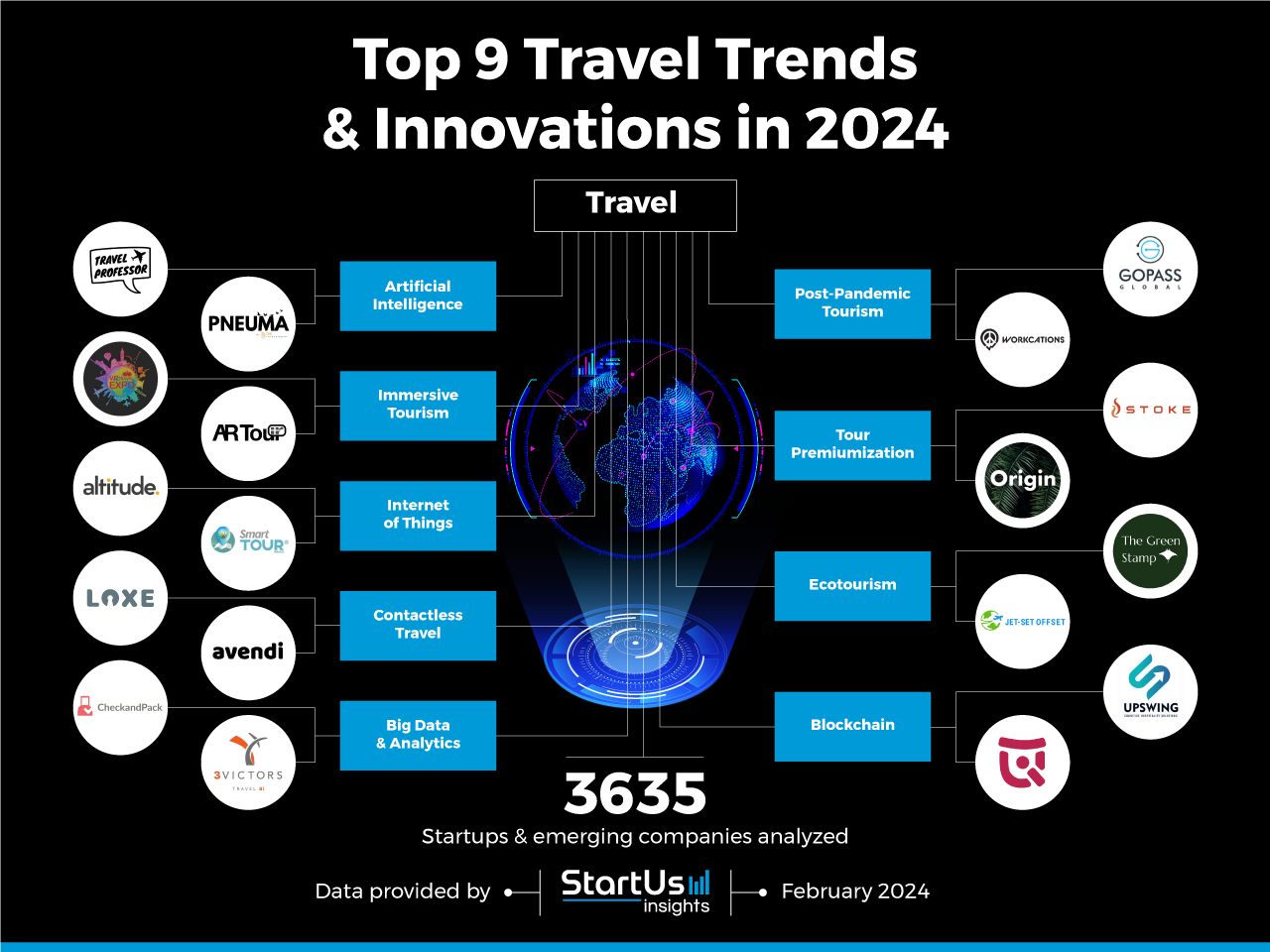
Click to download
Tree Map reveals the Impact of the Top 9 Travel Trends
Based on the Travel Innovation Map, the Tree Map below illustrates the impact of the Top 9 Travel Industry Trends in 2024. Startups and scaleups are enabling contactless travel using technologies like biometrics, radio-frequency identification (RFID), and near-field communication (NFC). This is due to increasing health and hygiene concerns post the pandemic. The use of AI in tourism ensures hassle-free trip planning while AR and VR allow tourists to virtually visit various locations and excursions. IoT increases visibility into tourism industry operations and allows passengers to track their luggage more efficiently. Further, the demand for personalized and luxurious travel is rising. Several startups enable recreational space travel as well as offer sustainable travel options to passengers.
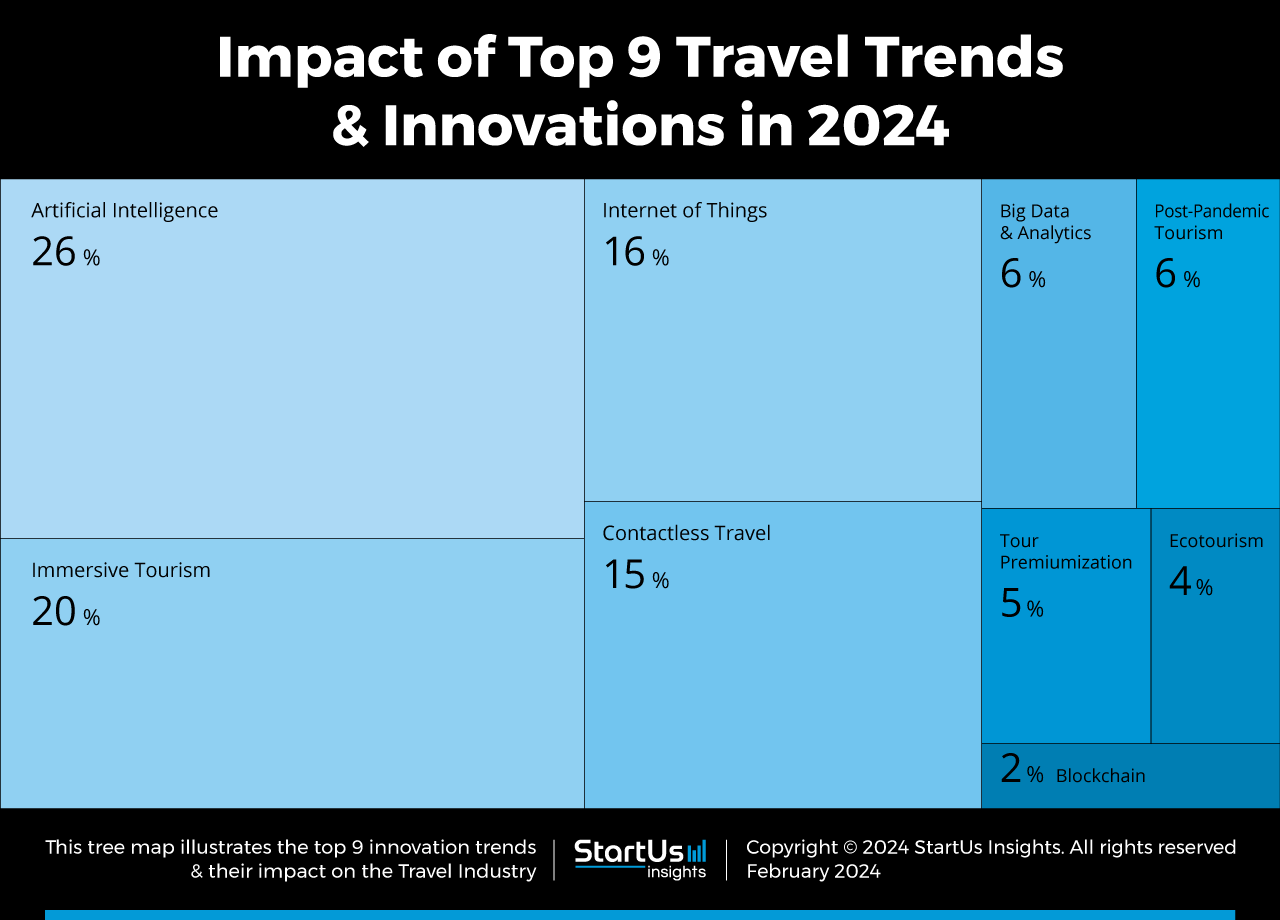
Global Startup Heat Map covers 3 635 Travel Startups & Scaleups
The Global Startup Heat Map below highlights the global distribution of the 3 635 exemplary startups & scaleups that we analyzed for this research. Created through the StartUs Insights Discovery Platform, the Heat Map reveals that the US, Europe, and India see the most activity.
Below, you get to meet 18 out of these 3 635 promising startups & scaleups as well as the solutions they develop. These 18 startups are hand-picked based on criteria such as founding year, location, funding raised, and more. Depending on your specific needs, your top picks might look entirely different.
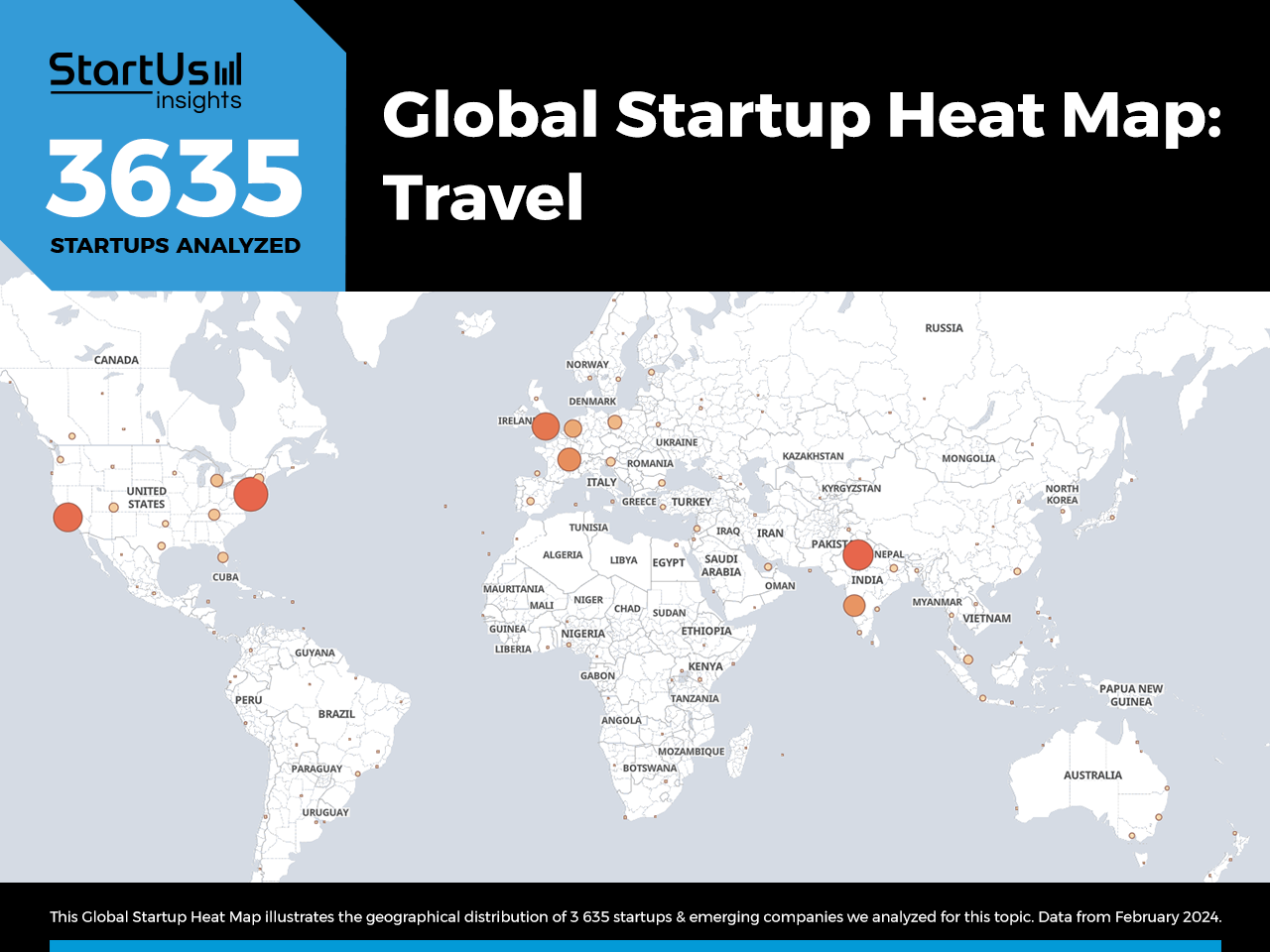
Interested in exploring all 3500+ travel startups & scaleups?
Top 9 Travel Trends in 2024
1. artificial intelligence.
Hotels employ intelligent chatbots, powered by AI, to provide quick and personalized responses to traveler inquiries. These chatbots simplify the booking process and gather customer reviews, aiding potential travelers in making informed decisions. Moreover, AI-based robots enhance the customer experience by automating hotel disinfection and delivering room service.
At airports, these robots guide travelers and assist with luggage handling. Facial recognition technology, driven by AI, expedites identity verification at airports, enhancing security and offering a swift alternative to traditional methods. Startups are developing AI-powered trip planning solutions, optimizing journeys, and personalizing travel experiences.
Travel Professor develops a Travel Chatbot
UK-based startup Travel Professor offers an AI-enabled chatbot for travelers. The startup’s chat widget software monitors multiple flight deals and notifies users when their preferences match. It also provides travel destination recommendations and flight price alerts. This allows travelers to book economical flights and have a budget-friendly tourism experience.
Pneuma Travel facilitates Travel Planning
US startup Pneuma Travel develops a voice-assisted digital agent, Sarah , to streamline the process of travel planning. This assistant, powered by AI, excels in arranging flight and accommodation bookings and assists travelers in discovering a variety of activities. Sarah , available round the clock, provides continuous support for all travel-related inquiries.
Moreover, Sarah customizes travel options according to individual preferences and budgetary constraints. The agent further enhances the travel experience by providing insights into local attractions in unfamiliar cities. Importantly, Sarah enables real-time modifications to travel plans, in compliance with specific airline policies, thereby minimizing waiting times for users.
2. Immersive Tourism
Immersive tourism caters to the growing demand for meaningful experiences among travelers, leveraging AR, VR, and mixed reality (MR). VR simulates original locations through a computer-generated environment, allowing tourists to virtually explore destinations. It provides travelers with a comprehensive 360-degree tour of points of interest.
AR enhances the travel experience with interactive elements such as navigation maps and ads. Travel companies employ AR and VR-based gamification to heighten tourist attractions. Moreover, these technologies enable hotels and resorts to present amenities and rooms in an engaging, interactive manner.
VR Travel Expo offers VR-based Travel Plans
US startup VR Travel Expo develops a VR travel application to transform the way people research and book travel. The application enables users to plan their vacations more efficiently. It provides an engaging platform for users to explore and expand their knowledge of the world. Moreover, it employs 3D geospatial technology that creates real-time digital twins of the world. This further enhances the travel planning experience.
AR Tour makes AR Glasses
Italian startup AR Tour offers AR-powered tours. The startup’s AR glasses superimpose reconstructed images of archaeological ruins to show how the site originally was. Its tour informs the tourists about the site’s history and significance via an audio-visual package. Moreover, the startup designs lightweight AR glasses to prevent motion sickness among tourists, improving convenience.
3. Internet of Things
IoT generates ample data that tourism companies leverage to personalize services in their subsequent visits. Hotels use IoT sensors to enable smart rooms that automate room lighting, temperature, and ambiance control, enhancing guest comfort. These sensors adjust appliances in vacant rooms, conserving energy and reducing the building’s carbon footprint.
Startups harness IoT to deliver location-specific information to customers, including real-time luggage tracking via IoT tags, minimizing lost items. Airlines also incorporate IoT-based solutions into seats, monitoring passenger temperature and heart rate for proactive health management.
Altitude enables Smart Hotels
New Zealand-based startup Altitude creates an IoT-based hotel software and hardware to develop smart hotels. The startup makes self-service kiosks to automate reservations, room up-gradation, payments, as well as check-in and check-out. Its hotel management platform further enables contactless engagement with guests. Additionally, Altitude’s mobile keys allow guests to open doors using mobile phones, providing convenience and saving time for travelers.
Smart Tour provides Smart Itineraries
Brazilian startup Smart Tour offers smart itineraries using IoT and quick response (QR) codes. The startup recommends travel routes and destinations based on the user’s preference in real-time. This facilitates a seamless experience for travelers. Besides, the user-generated data enables tourism managers to better understand consumer behavior and indulge in proximity marketing. The startup also offers a contact tracing solution to monitor COVID-19 infected travelers and ensure public safety.
4. Contactless Travel
Travelers benefit from contactless recognition technologies like retina scanning, which replace traditional travel documents, speeding up passenger identification and reducing airport queues. QR codes offered by travel companies allow tourists to access relevant information on their mobile devices, enhancing engagement.
Hotels have introduced contactless self-check-ins, enabling visitors to arrange services before arrival. Additionally, contactless payment modes are available in hotels and restaurants for swift and secure transactions. Moreover, wearable devices are transforming the travel experience by providing real-time notifications and touch-free access to services and information.
Loxe designs Smart Hotel Keys
US-based startup Loxe makes smart mobile keys for hotels. The startup’s smartphone app replaces key cards with contactless mobile keys that allow users to unlock doors using smartphones. It also reduces operational costs incurred in the manufacturing of conventional keys or plastic cards. Moreover, the startup designs a Bluetooth retrofit module that converts normal door locks into mobile-ready door locks. This allows hotel owners to easily convert their existing locks into smart ones without additional expenses while improving guest safety and convenience.
Avendi provides Contactless Payment
Singaporean startup Avendi offers contactless and cashless payments for travelers. The startup allows tourists to accumulate expenses throughout their trip and pay at the end of the journey. Avendi’s app utilizes QR codes to add all the billed expenses and shown through its dashboard. The user settles the tab amount in the preferred currency, preventing the inconvenience of cash withdrawal or credit card payments.
5. Big Data & Analytics
Big data empowers travel companies with customer trends for strategic marketing. Analyzing traveler behavior, they offer tailored recommendations for hotel bookings, cab hires, flight reservations, and ticket purchases.
Predicting future demand is another advantage of big data and analytics, helping hotels and airlines identify peak periods to optimize revenue. Advanced analysis of transactional data aids in detecting cyber fraud, and safeguarding sensitive customer information such as credit card details and biometric data.
CheckandPack creates a Travel Platform
Dutch startup CheckandPack offers a big data travel platform. It runs marketing campaigns to gather traveler data and understand tourism trends. Based on these insights, the platform enables businesses to approach travelers with a customized appeal. It also provides travelers with holiday planning.
3Victors provides Travel Data Analytics
US-based startup 3Victors offers travel data analytics. The startup’s product, PriceEye Suite , proactively monitors the prices of numerous airlines to provide insights into competitor prices. It creates a dashboard to display travelers’ location of interest, allowing travel airlines to better manage their revenue and pricing strategy.

6. Post-Pandemic Tourism
Post-pandemic tourism focuses on safe, sustainable, and flexible travel options, responding to evolving traveler preferences and health guidelines. Enhanced health and safety protocols, including regular sanitization and contactless services, become standard in airlines and hotels, ensuring traveler confidence.
Destinations and operators emphasize outdoor and less crowded experiences, catering to a heightened demand for nature-based and wellness travel. Flexible booking policies and trip insurance gain prominence, offering peace of mind amid uncertainties. Sustainable travel gains traction, with tourists and businesses prioritizing environmental impact and community well-being.
GOPASS Global enables Pre-travel Risk Management
Singaporean startup GOPASS Global provides a travel risk analytics platform against COVID-19. It analyzes the biosecurity risk elements involved in a trip, such as border restrictions, quarantine requirements, airport type, and airline transit points or seating in real-time. This allows travelers to assess risk factors and plan their trips accordingly.
Moreover, the startup creates world maps displaying information regarding COVID-prone areas, testing areas, and vaccine coverage. This provides travelers with a preview of the current situation, allowing them to ensure safety during business and leisure travel.
Workcations enables Work from Anywhere
Indian startup Workcations provides properties at tourist destinations for remote-working individuals. It offers amenities like internet connectivity, food, and a quiet ambiance, allowing tourists to work in a peaceful environment without hindrance. This increases employee productivity, motivation, and retention.
7. Tour Premiumization
Hyper-personalization in travel experiences is on the rise, with tourists eager to immerse themselves in diverse cultures. Luxury travelers enjoy tailored experiences and intuitive services through tour premiumization. Health and wellness packages offered by travel startups help tourists unwind.
These retreats enhance health and offer detoxifying food options. Space tourism is another exciting development, offering leisure or research trips to space. Lastly, travel startups are fostering customer loyalty and building strong relationships through membership or subscription models.
STOKE provides Space Tour
US-based startup STOKE facilitates space travel using everyday-operable rockets. The startup’s rockets are reusable and deliver satellites to any desired orbit. This enables on-demand access to space, paving way for space tours for exploration, recreation, and research. The startup also emphasizes the economical and rapid development of its hardware for feasible spacecraft launches, advancing space tourism.
Origin offers Travel Personalization
Dutch startup Origin provides premium travel personalization to tourists. The startup utilizes machine learning and travel curators to plan creative vacations. It also arranges flights and accommodation for travelers. Further, the startup measures the carbon output of itineraries and offers sustainable tourism options.
8. Ecotourism
Traveling responsibly minimizes tourism’s environmental impact and supports local communities’ well-being. Ecotourists strive to reduce their carbon footprint during their journeys. Startups contribute by developing sustainable transport, ecolodges, and solar-powered resorts.
Airline passengers have the option to offset carbon emissions during flight bookings. Local tourism stimulates small businesses economically and creates job opportunities. It also emphasizes minimum littering, which lowers pollution and the time spent on cleanups.
Jet-Set Offset simplifies Flight Carbon Offset
US-based startup Jet-Set Offset creates a carbon-offsetting platform for air travel. The startup partners with non-profit organizations working against climate change and connects them with travelers. Each time travelers book flight tickets via the startup’s platform, Jet-Set Offset contributes a certain amount per mile for their journey to environmental organizations. This way, the passenger’s journey promotes mileage-based donations to offset carbon emissions.
The Green Stamp facilitates Ethical Wildlife Tour
Dutch startup The Green Stamp provides a platform to book ethical wildlife tours. It curates tours based on the tourists’ inclinations toward certain locations or wildlife. Exploration of these projects allows travelers to indirectly contribute to their cause as these wildlife projects donate to the welfare of local communities and the environment.
9. Blockchain
Blockchain provides the travel industry with operational transparency and security. Traceable payments, particularly for international travel, are a key application, that fosters trust among parties involved in transactions.
Automation and enforcement of agreements in travel insurance and supplier contracts are achieved through smart contracts. This strengthens reliability and cuts administrative costs. Travel firms establish customer loyalty programs where points are exchanged for cryptocurrency. Lastly, blockchain increases data storage security, reducing the risk of information leaks.
Upswing facilitates Guest Profiling
Indian startup Upswing creates AURA , a blockchain-powered platform for guest profiling. It provides a holistic view of guests, their preferences, and purchase patterns. The platform associates a score with each guest and suggests improvements in their service. This facilitates hotels to provide a personalized experience to their guests and, in turn, increase sales.
UIQ Travel develops a Solo Traveling App
US-based startup UIQ Travel develops a blockchain-based app to connect solo travelers. It discovers people with shared interests and suggests tours or attractions. Such hyper-personalized recommendations assist in experience discovery and also increase traveler engagement.
Discover all Travel Trends, Technologies & Startups
Tourism, although severely impacted by the pandemic, now continues to rapidly grow across the globe. Post-pandemic trends indicate an increasing emphasis on hygiene and safety during travel. The industry is witnessing the widespread adoption of disruptive technologies like AI, XR, IoT, and blockchain. The travel industry utilizes big data to understand traveler trends for targeted marketing. The transition to ecotourism is accelerating as businesses integrate zero-emission transit and carbon offset programs to reduce their carbon footprint.
The Travel Trends & Startups outlined in this report only scratch the surface of trends that we identified during our data-driven innovation and startup scouting process. Among others, personalization, decarbonization, and travel safety will transform the sector as we know it today. Identifying new opportunities and emerging technologies to implement into your business goes a long way in gaining a competitive advantage. Get in touch to easily and exhaustively scout startups, technologies & trends that matter to you!
Your Name Business Email Company
Get our free newsletter on technology and startups.
Protected by reCAPTCHA and the Google Privacy Policy and Terms of Service apply.
Discover our Free Travel Report 21 pages
Book a call today!

Travel 21 pages report
Mobility 22 pages report, railway 22 pages report, cleantech 19 pages report.
Leverage our unparalleled data advantage to quickly and easily find hidden gems among 4.7M+ startups, scaleups. Access the world's most comprehensive innovation intelligence and stay ahead with AI-powered precision.
Get in touch
Your Name Business Email Company How can we support you? (optional)
Business Email

Protected by reCAPTCHA and the Google Privacy Policy and Terms of Service apply.

- Promising Startups 2022
- Boarding Pass
- Startup: Confidential
- Appointments
- CTalk
- Tech Gateways
- 2022 VC Survey
- Ctech Testimonials

- Terms Of Use
- Privacy Policy

Opinion The top travel-tech trends set to revolutionize tourism in 2023
Technology-driven innovations are reshaping the travel industry, with smart hotels, ar/vr experiences, contactless solutions, and ai-powered personalization leading the way towards a more seamless and efficient travel journey.

- FairFly rebrands as Oversee, adds Rapyd CEO Shtilman to board
- HyperGuest raises $23 million Series A to connect hotels, suppliers, and travel distributors
- Travel insurtech startup Faye lands $10 million in Series A


11 Travel Technology Trends Emerging in the Tourism Industry in 2024
With widely available vaccines and lower numbers of Covid-19 cases, travel is slowly returning to its pre-pandemic levels , although travel risks and disruptions are still present. Extreme weather conditions, political instabilities, and hardware malfunctions. With the emergence of artificial intelligence and mobile devices, customers expect a much greater level of personalization than ever before. These are the main reasons why the travel industry is consistently striving to find new and innovative ways of integrating breakthrough technologies into its operations.
Boost your travel business with the right technology
You will learn:, state of travel industry in 2024, key travel trends and technologies, customer experience with ai and ar, automation and efficiency in travel business, strategic technology investments, what is travel technology, impact of technology on the travel industry, why is technology important in the tourism and travel industry, key statistics and forecasts for travel technology in 2024, what are the latest technology trends used in the travel industry, 1. advanced travel search engines, 2. ai dynamic pricing engines, 3. dynamic scheduling systems.
- 4. Internet of Things
- 5. Augmented Reality and Virtual Reality
6. Contactless payments
- 7. AI chatbots
8. Big Data
9. 5g and fast wi-fi networks, 10. recognition technology, 11. cybersecurity practices, future of travel technology, building a travel application or extending your development team.
🚀 We're here to assist you in accelerating and scaling your business. Send us your inquiry, and we'll schedule a free estimation call .
Travel technology is an umbrella term to describe the multitude of different uses of modern technology such as artificial intelligence, augmented reality and mobile technology within the fields of tourism, travel, and hospitality industry.
Technology solutions can be deployed at virtually every point of travel in one form or another, significantly influencing the overall customer experience.
Do you remember buying an airline ticket from a real human being?
Neither do we.
We all got used to the presence of modern technological advancements in the travel industry.
There are many more ways in which modern digital technology influences and improves the travel industry.
The ultimate motivation behind implementing these technologies is pretty straightforward. It as always boils down to increasing profits and expanding business, which in turn has a positive impact on customer experience.

First and foremost, it leads to improved efficiency and decreased operating costs.
In fact, it is a win-win situation for online travel agencies, airlines, as well as the travelers.
For companies, digital transformation in travel industry means better margins and healthier cash flows. For customers, in turn, it means many more attractive tourist destinations and lower prices.
[Read also: What’s the Future of Digital Transformation and Its Trends? An Expert’s Point of View ]
These days, almost everyone has a smartphone or other mobile device, granting access to an immense choice of online services.
It is thus crucial for travel companies to allow their customers to book their trips, check-in for their flights, and find information about their destinations online.
Even though we are taking all of these modern utilities for granted, they are still a key factor for improving user experience in the travel industry. As a result, they have to be improved and optimized consistently.
Latest travel technology trends refer to the innovations and digital solutions that are transforming the travel and tourism industry. Some of the trends include online travel booking, virtual tourism, mobile travel apps, chatbots and artificial intelligence. Here are some of the latest quantitative statistics and forecasts on travel technology trends:
- Generative AI tools like ChatGPT will become more popular for trip planning, as half of travelers surveyed are interested in using them to find the perfect stay.
- Destination “dupes” and “set-jetting” will continue to be in vogue as travelers seek affordable alternatives to crowded or expensive places, or follow the locations featured in their favorite shows or movies¹.
- Global travel app revenues will grow by 17 percent in 2024, reaching nearly $400 million.
- The share of digital ad spending in the travel and leisure industry will reach 14.5 percent in the United States and 13.9 percent in the United Kingdom in 2024.
- The world’s leading online travel agencies (OTAs) will spend $2.3 billion on Google advertising in 2024.
- The global travel and tourism market will shift from 66 percent offline sales channels to 54 percent online sales channels from 2017 to 2027.
- The global travel technology market will grow by approximately 45 percent from 2020 to 2026, reaching $12.5 billion.
- The Asia-Pacific region’s recovery will be evident as travelers flock to destinations such as Taiwan, Thailand, and Australia, which have successfully contained the pandemic and reopened their borders.
- Travelers will need to be more creative and flexible in their destination choices, as travel restrictions and regulations may change frequently due to the ongoing health crisis.
- Travelers will opt for carry-on only luggage with a twist: they will use smart luggage that can track their location, charge their devices, and weigh themselves.
- Travelers will rely more on their travel advisors, who can offer more than just flights and hotels, but also personalized experiences, insider tips, and access to exclusive benefits.
Sources: Statista , Travel + Leisure , Smart Flyer .
There are plenty of different technology trends that are shaping the future of the travel industry.
Below, we’ve listed 11 of the most important travel industry trends.

Let’s compare here travel search engines to the Google search engine.
On the surface it is a pretty simple concept. A user introduce certain keywords of their interest and the search engine matches the most relevant results.
But what if you are looking for a hotel room in a specific location with certain room facilities? A simple Google search won’t be able to compute so many details.
This is where metasearch engines enter.
Metasearch engines are the tools that send search queries to many sources and organize results in a comprehensive list.
The main objective of such sites is to aggregate results in a unified way, so that the client can access the maximum number of available options on the market. It allows users to have a reliable source of objective information and to compare offers with one another.
Results presented by metasearch engines are obtained with less amount of exertion on the end user side.
Instead of searching one single search engine to find a specific website or browsing through different services, the right amount of data can be obtained by a metasearch engine.
It definitely improves the user experience. Ans save their precious time.
In the tourism industry, metasearch engines are used to search through and compare travel agencies’ offers to provide clients with as many suitable options as possible.
Nowadays, these services have grown quite robust. Many provide smart price alerts or tempting last-minute deals.
When developing a metasearch engine for an online travel agency , lodging reservation service, hotel booking engine , or a hotel inventory management software key factors are performance and scalability .
A team of Stratoflow Java developers when tasked with improving the travel search engine for a major hotel bookings aggregator decided to extract the availability search into a separate cache layer based on an in-memory data grid (IMDG) platform. It allowed for a major decrease in SQL database usage, as well as improved efficiency.
Interestingly, our client saw almost an immediate commercial effect right after the initial implementation.
Higher overall throughput of the travel search engine allowed the existing customer base to query the platform more frequently, generating higher revenues in the process.
[Read also: Introduction to a hotel channel manager ]
Airlines such as Ryanair or Southwest are known for their extremely low price model.
You can hop anytime you want on a plane from Warsaw to London for less than 30 dollars.
You may have been wondering – how are airlenes able to break even, and run a successful business model with such low prices?
The answer is artificial intelligence.
These days, the pricing of airline tickets is completely automated and run by advanced systems that aim to fill a plane with passengers at the most optimal prices.
These systems take into consideration different types of clients. Those can be either business travelers who value convenience and comfort the most or leisure travelers who are more cost-conscious regardless of long layovers.
All of these factors are summed up by the pricing system. The goal is to fill as many seats on each plane as possible. But at the same time to avoid situations of complete tickets’ unavailability for potential clients in a very complex balancing act.
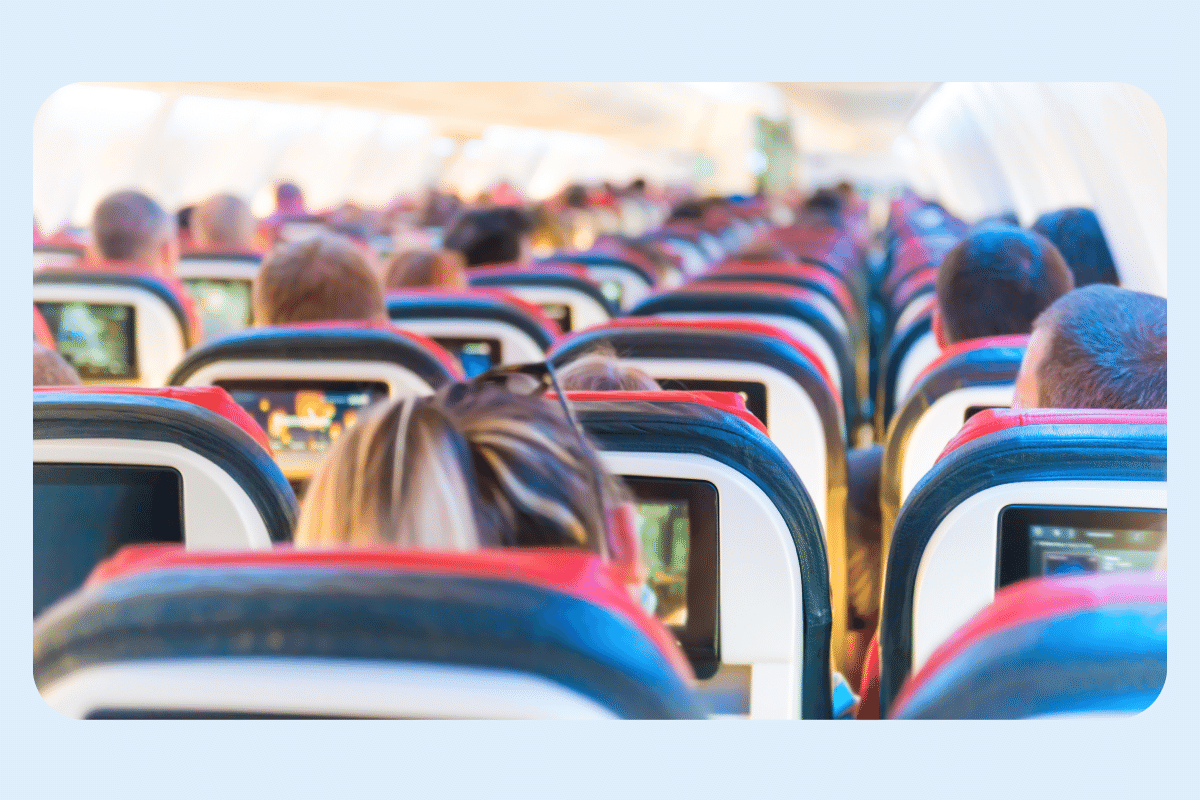
Airlines’ pricing systems have to process an immense amount of customer data as well as travel trends about local destinations.
It is worth mentioning that during the COVID-19 pandemic pricing systems of many popular airlines were pretty severely disrupted. This led to a rather peculiar situation when we could book flights from Europe to the US for less than 200 dollars.
How was that possible? The dynamic pricing engines weren’t prepared for such an exceptional situation.
Nevertheless, as pandemic restrictions loosen, and airlines worldwide resume their normal routes and operations, dynamic pricing systems continue to play a vital role in their business model .
[Read also: Benefits of Digital Transformation for Your Business ]
Airlines are characterized by their large involved capital and incredibly slim average profit margins hovering around 5% (ignoring COVID-19 disruptions).
What does it mean for travel technology trends?
It’s simple. For an airline to make money, it has to adapt fast and consistently search for profitable routing opportunities.
This task has to be handled by automatic scheduling systems .
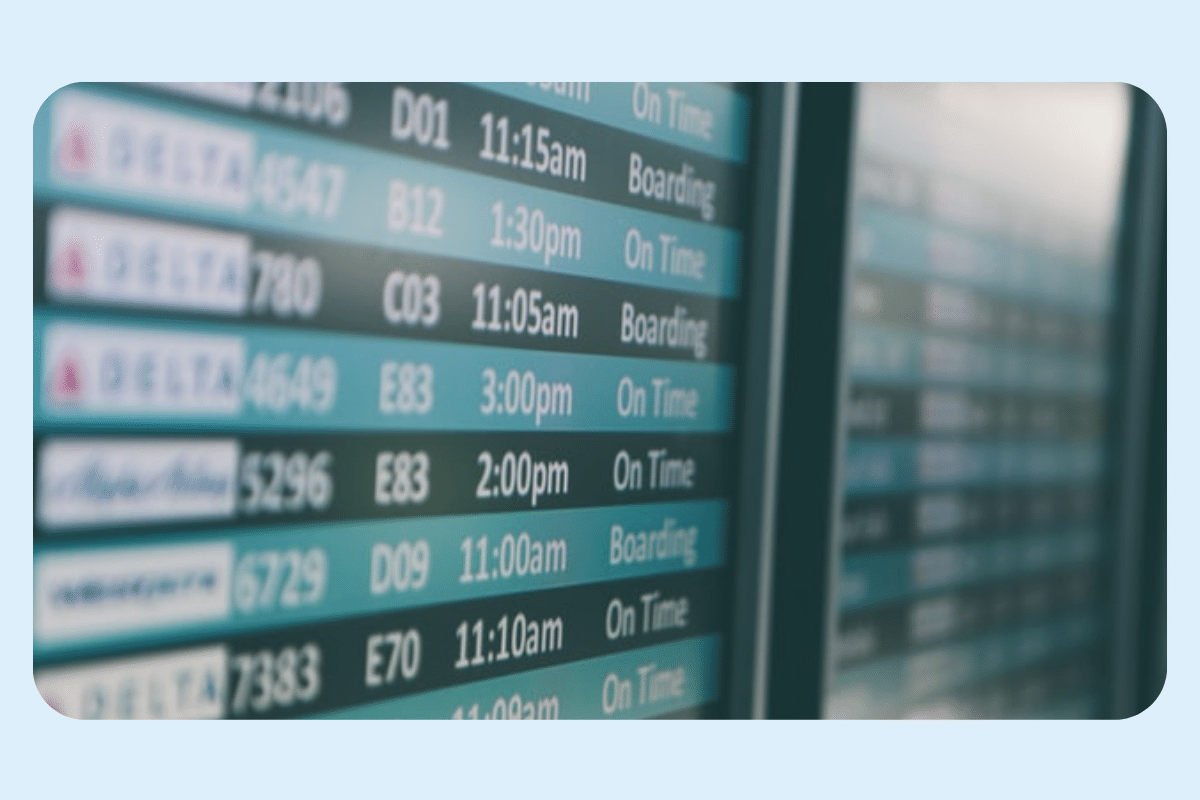
Aside from the cost, the major factor for customers determining which flight they will choose is the overall travel time.
Airlines, therefore, put an enormous effort into assembling the most optimal schedule that they can offer in the shortest travel time possible.
Modern dynamic scheduling systems have to take into account these three factors pointed by Nawal Taneja :
- Scheduling optimization system – An automated solution created by a team of experienced developers that process operational data and identify the set of possible routing and scheduling changes. These have to be both profitable and operationally feasible.Such a system works based on all the possible arrangements of feasible schedule changes. Then it sorts them by their profitability.
- Access to reliable market data – A dynamic scheduling system uses only reliable and accurate data on the routes popularity and its profitability.Considering a fairly short time horizon of flight scheduling operation, the best source for booking and revenue data is an internal Revenue Management system .
- Knowledge about potential operational constraints – Many factors dictate whether a certain route is feasible operationally or not.These include maintenance costs at airports, gate availability, and miscellaneous aircraft-specific constraints.Only understanding all of them can ensure that a dynamic scheduling system can return positive results.
In terms of profitability, it is estimated that dynamic scheduling can result in a 1-3% increase in revenue , depending on its utilization rate.
It constitutes a substantial amount when it comes to the airline industry.
Stratoflow developers have a great deal of experience in this particular field.
They were tasked by a global flight information company to improve their existing system.
Stratoflow proposed a replacement of major calculation logic with an open-source, high-performance framework that dramatically lowered TCO when compared with the existing code.
4. Internet of Things (IoT)
Another emerging technology that is slowly being adopted by the tourism industry is the Internet of Things (IoT)
This concept refers to the network of physical devices —“things”—that are equipped with various sensors in order to connect and exchange data with other systems within the network over the internet.
Depending on the use case, these “things” can range from ordinary household devices to sophisticated industrial machinery.
When it comes to its role in the tourism industry, we’ve already seen some practical implementations beginning to appear.
Some airports, using IoT devices, tag passengers’ bags to alert them of their luggage’s current whereabouts and send them a notification when it arrives at the carousel.
Hotels are also starting to leverage some IoT-enabled sensors and voice control devices to adjust things like air conditioning. Using an in-room tablet, hotel guests can seamlessly control the temperature, music, lighting, and curtains, changing the atmosphere of the room and personalizing their experience to a whole new level.
5. Augmented Reality (AR) and Virtual Reality (VR)
Virtual reality (VR) has recently once again come into the spotlight when Facebook rebranded itself and announced Metaverse. It’s a conceptual virtual universe that will be a future replacement for well-established social networks.
These visions seem exciting and a little eerie at times. But can virtual and augmented reality also influence the tourism industry in the future? As it turns out, the answer is “yes”.
Virtual Reality allows people to explore new places without leaving the comfort of their homes.
Virtual tours will enable people to have a glimpse of a certain exotic place before their visit in person. What’s more, popular travel platforms like Booking.com can set up virtual hotel room previews in order to better manage customer expectations.
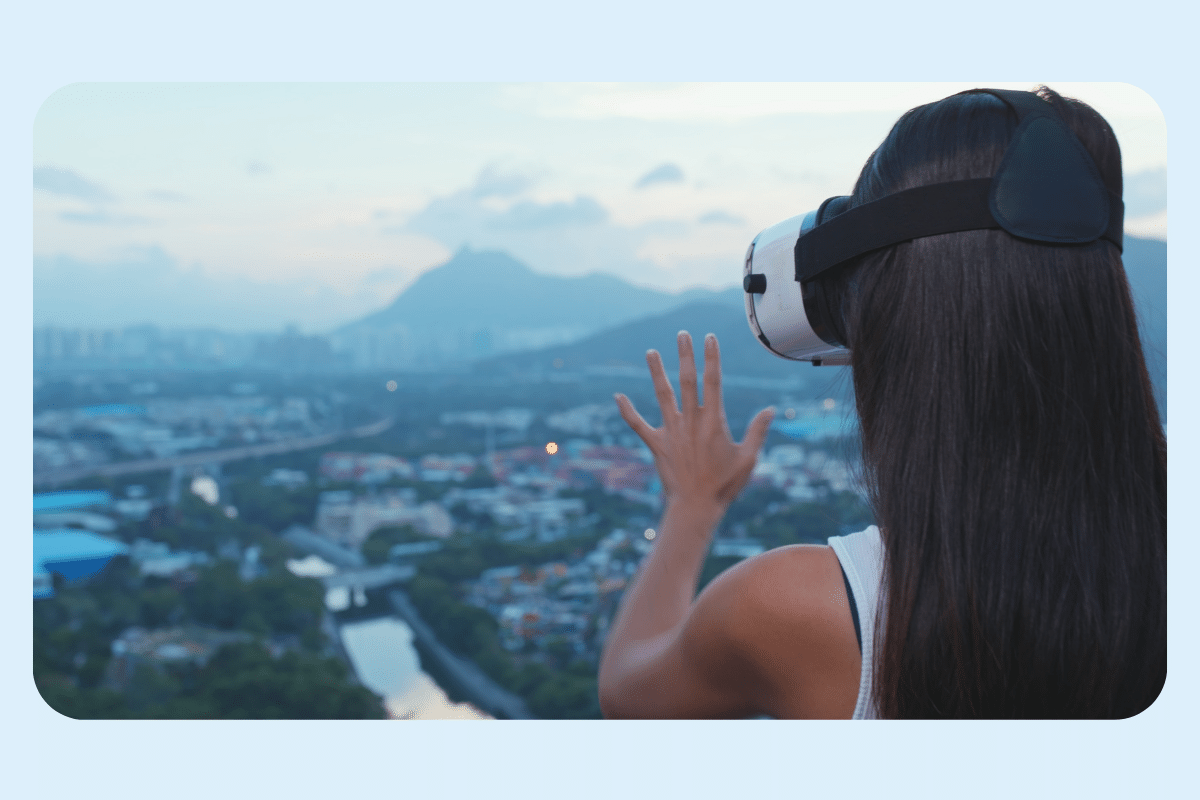
Contactless payment methods take pride of place among recent tourism technology trends.
As the pandemic forced people to shy away from physical coins and banknotes, contactless payment options like GooglePay and Apple Pay have gained a lot of popularity.
When using them, the user’s device with a payment app communicates with the reader using RFID technology.
To see how it works in practice let’s take a look at the contactless payment method designed by The Walt Disney Company.
Disney offers Disney World guests custom wristbands, known as MagicBands. Visitors can link their credit card to their MagicBand to make purchases with a simple and effortless swipe of a wrist.
From a business standpoint, this solution offers Disney an unmatched opportunity to track customer behavior in order to optimize its operations even further. It is a trend that is undoubtedly gaining traction in various sectors of the travel industry.
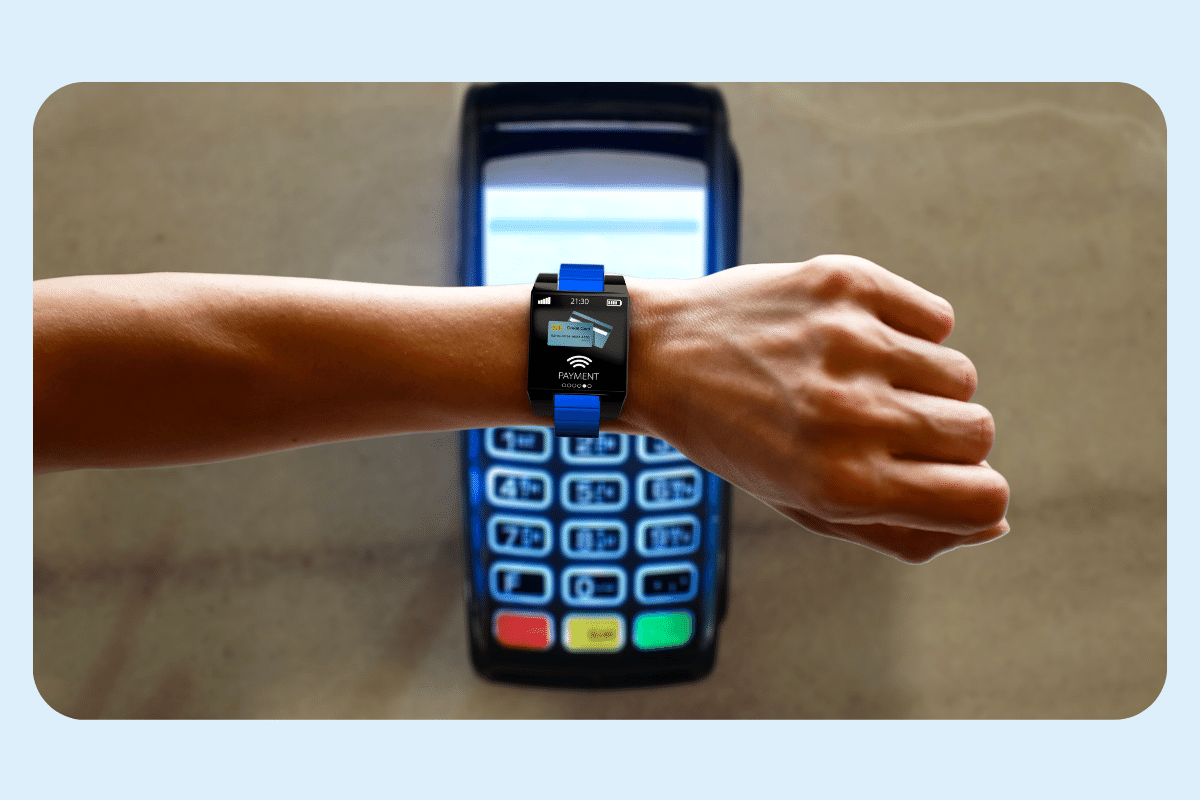
7. AI Integration and AI chatbots
AI is expected to be increasingly used in the hotel and travel industry, creating more seamless travel experiences and supporting new innovations to meet higher guest expectations.
Recently a story has surfaced that, allegedly, an advanced AI chatbot developed by Google has become self-aware.
AI chatbot technology has gone a long way in the last couple of years. It can also play a significant role in the development of the travel and tourism industry.
AI Chatbots stimulates human conversation, mostly using text interactions on various websites and services. Their main objective is to alleviate some congestion in call centers by proving at least basic help for customers 24/7.
When it comes to their usage in the travel and tourism industry, AirAsia is a good example of the use of a successful chatbot. Their advanced chatbot, AVA is able to do a multitude of things from helping travelers to choose seats and book flights to answering more difficult questions about current COVID-19 restrictions.
Data is a company’s most valuable asset.
This is also one of the main reasons why companies in the travel and hospitality industry are investing more and more funds into Big Data solutions.
Put simply, Big Data is a term that refers to large and unstructured data sets obtained from various data sources. These data sets are so voluminous that traditional data processing would have a hard time processing them into useful information.
Modern hotels and travel agents are using big data solutions to more effectively track customer behavior and preferences. This information is later used to improve the guest experience.
Big data measure precisely business performance.
Thanks to receiving data from previously untapped sources, the system allow for better yield management and demand prognosis.
[Read also: Fintech Trends That Shape Financial Future ]
As travel tech trends grow more robust with every passing year, connectivity develops at the same rapid pace.
A couple of years ago, 5G made its debut in some of the largest cities around the world, offering up to 20 times faster download speeds than before.
Even though that might not be such a big deal for an ordinary person, the connection between smart devices can now be more efficient than ever allowing more advanced IoT networks.

We have also seen an emergence of other breakthrough communication technologies, such as the Starlink internet.
Thanks to thousands of satellites in low earth orbit, people in virtually every corner of the world can enjoy internet speeds in excess of 100mbit/s and low latency unmatched by any other satellite internet provider.
A poor WiFi or Internet service in a hotel room can lead to bad online reviews for the hospitality and travel industry. With Starlink, even hotels in the most remote places can have a stable and fast internet connection.
[Read also: What is a GDS? ]
Facial recognition is the software that classifies a single face according to its gender, age, emotion, or other characteristics in an attempt to confirm a person’s identity.
It is currently one of the most powerful surveillance tools ever made.
While many people are happy to use it to effortlessly unlock their phones, companies and governments are beginning to use it to a much greater extent.
Facial recognition devices are beginning to appear in various airports across the world as an advanced security measure and potential deterrence.
According to a recent report from the Department of Homeland Security, “U.S. Customs and Border Protection (CBP) plans to dramatically expand its Biometric Exit program to cover 97 percent of outbound air passengers within four years.”
To verify accounts on virtually every major travel and tourism offer aggregator, you would have to provide a photo of your ID card and other sensitive personal data.
It’s natural to feel a bit uneasy to share so much personal information, regardless of the service’s squeaky clean reputation and impressive market share.
Tourism companies and travel businesses understand that. That’s why they dedicate a substantial amount of resources to developing reliable and safe cybersecurity practices.

As virtual reality and augmented reality technologies are becoming more and more advanced, some people speculate that they will negatively influence the tourism industry, but we beg to differ.
We predict that future tech advancements will push the travel industry towards better travel experiences and even more personalized experience.
Travel technology trends – summary
The travel and tourism industry is the one where proper interactions with the consumer are essential. As new technological breakthroughs enter the market, they are letting corporations understand their customers a bit better, and provide them with improved services and experiences.
Related Posts
- How To Build Travel Meta Search Engine: A Step-By-Step Guide
- Best Travel Management Solutions You Must Know
- Yield Management: What It Is and The Best Strategies
- Hotel Inventory Management 101: An Introduction
- How to Choose the Best Travel Agency Software to Maximize Your Revenue
We are Stratoflow, a custom travel software development company . We firmly believe that software craftsmanship, collaboration and effective communication is key in delivering complex software projects. This allows us to build advanced high-performance Java applications capable of processing vast amounts of data in a short time. We also provide our clients with an option to outsource and hire Java developers to extend their teams with experienced professionals. As a result, our Java software development services contribute to our clients’ business growth. We specialize in building bespoke travel solutions like fast search engines, metasearch engines, booking engine services or channel manager integrations.
Testimonials
The developed software product was built from scratch with solid quality. We have had a long-term engagement with Stratoflow for nearly 10 years. We look at them as partners, rather than contractors. I'm impressed by their team culture and cross-team support.
Nathan Pesin
CTO, Legerity Financials
Stratoflow was a great partner, challenging as well as supporting our customer projects for the best outcome. They have a great pool of talent within the business - all very capability technologists, as well as being business-savvy and suitable for consultancy engagements.
Chris Goodall
Managing Consultant, CG Consultancy (UK) Limited
The bespoke metal exchange platform works great, it is easily accessible and richly functional. Stratoflow managed deadlines capably, meticulously documented their progress, and delivered a complex project at an affordable cost.
Bartlomiej Knichnicki
Vice Chairman, Supervisory Board
We are very pleased with our partnership with Stratoflow and, as we continue to grow, we expect to increase the numbers of developers that work with us on our projects. They have proven to be very skilled and flexible. They're extremely reliable, and they have a very good company culture of their own, which gives them a real edge compared to other providers that serve more as production shops rather than thought partners and creative problem solvers.
Andrew Kennedy
Founder & Managing Director, Tier 2 Consulting
Stratoflow successfully customized the system according to the specific functionalities and without bugs reported. The team was commended for their adaptability in the work process and for their responsiveness.
Joshua Blavins
Tech PM, Digital Agency
The features implemented have received overwhelmingly positive feedback from end-users. Stratoflow has an incredible technical expertise and a high degree of flexibility when it comes to changing project requirements.
Chief Technology Officer, Legerity
They have impressively good knowledge of AI issues. Very responsive to any amendments and findings. Very good communication. We received a finished project which could be implemented into production shortly after testing.
CO-Founder & CTO
Circular Fashion Company
They provided superb service with seamless communication and a highly professional, technical approach. The team displays impressive technical expertise and are willing to share information and engage in constructive feedback.
Filip Stachnik
Operations Manager, Otwarte Klatki (part of Anima International)
They're very skilled technically and are also able to see the bigger picture. Stratoflow can actually think about solutions, not just the technical task at hand, which they've been assigned.
Arnd Jan Prause
Chief Operating Officer, musQueteer
Stratoflow delivered the website successfully within the timeframe and budget. They assured that the output met the set requirements. Overall, the team's performance was excellent and recommended for their exceptional technical business expertise. They've been able to deliver all of their work on time and within budget, which has been very impressive.
Lars Andersen
Founder & CEO, My Nametags
Travel sector rebound after the pandemic is complete. We have fantastic global coverage of travel data distribution due to mutual agreements and data exchange between aggregators. Competition for the best price of limited resources degradates margins. How to win? Provide personalized experience and build your own products in the front-office. The missing bits: a traveller golden record collecting past activities and a AI/ML recommendation technology.
Michał Głomba
CEO at Stratoflow
National Geographic content straight to your inbox—sign up for our popular newsletters here

5 pandemic tech innovations that will change travel forever
These digital innovations will make your next trip safer and more efficient. But will they invade your privacy?
In the 20 months since the COVID-19 pandemic began, technological innovations have gone from futuristic to familiar. These days it’s hard to be out in the world without encountering QR-coded menus or supplying digital vaccine passports.
As the tourism industry—which logged a billion fewer international arrivals in 2020 than 2019—sputters back to life, masks may begin to disappear, but many pandemic-era tech tools will continue to factor into your trips.
“Consumers will come to expect technologies that make them more confident about travel,” says Steve Shur, the president of the Travel Technology Association. “Some of these changes are here to stay.”
In fact, a 2021 Pew Research survey of 915 policy leaders, science researchers, and other experts predicts that, by 2025, our daily lives could be even more influenced by algorithms, remote work, and what some call “tele-everything.”
While novel interventions such as real-time translation devices and facial recognition passport control may make travel safer and more efficient, there are downsides, including concerns about privacy , data security, and biased technology. Here are some of the innovations that travelers will continue to see and use.
Virtual and augmented reality
When the pandemic shut down travel, museums and tourist destinations turned to augmented reality (AR) and virtual reality (VR) to create online exhibits and experiences. While some of these experiences are best seen with a VR headset, most can be enjoyed with just a computer or smartphone.
The Xplore Petra app launched in June 2020, allowing users to “visit” Jordan ’s most iconic archaeological site by projecting a scaled-down version of the ruins. Lights over Lapland, an Arctic travel company, launched a VR experience to show off the Northern Lights using VR headsets or computer screens.
( How virtual reality might change your next trip, even after COVID-19. )
Post-pandemic, VR and AR may enhance actual trips by adding experiences such as a simulated climb up the Matterhorn at Lucerne’s Swiss Museum of Transport . The Hunt Museum in Limerick, Ireland, has a VR attraction in which visitors immerse themselves in “ The Garden of Earthly Delights ,” a 500-year-old painting by Hieronymus Bosch.
The Museum of Natural History in Paris has an AR exhibit that brings visitors face to face with extinct animals in digital form. The National Museum of Singapore has an installation called “Story of the Forest,” where sightseers explore a virtual landscape comprised of almost 70 nature drawings from the museum collection. The Smithsonian Institution’s National Museum of Natural History , in Washington, D.C., has an app that uses AR to show what some of its animal skeletons would look like with skin and muscle over the bones, offering a new view of a collection dating back to the 1880s.
“VR is not going to replace travel and tourism. It is just going to enhance tourism,” says Anu Pillai, who runs the Digital Center of Excellence at Wipro, a technology company.
Crowd control
To help enforce social distancing, cities, airports, and museums tested or rolled out crowd-control technology including Singapore’s roaming, vaguely terrifying robots that announce people are too close together and signs indicating how large crowds are at airport gates . As throngs of travelers return to popular destinations, similar methods and devices may be implemented to prevent overtourism.

In Italy during the pandemic, Venice began tracking visitors using cameras designed to catch criminals. Post-pandemic, it plans to harness them to keep tourist numbers at manageable levels, perhaps in concert with the mayor’s proposal to add electronic gates at major entry points (cruise ship docks, train stations) that can be closed if the city gets overcrowded.
(These tech changes could make your next flight safer.)
“We know minute by minute how many people are passing and where they are going,” Simone Venturini, Venice’s top tourism official, told the New York Times . “We have total control of the city.”
Amsterdam , which also struggles with overtourism, tracks how visitors use Amsterdam’s City Card, a flat-fee pass to museums and public transport. Beach Check UK launched this summer with real-time information on how busy dozens of beaches are along the English coast, guiding travelers away from packed areas.
“Technology can be used to collect data in order to both make better decisions and communicate those decisions,” says Christopher Imbsen, director of sustainability at World Travel & Tourism Council.
UV-C cleaning
Hospitals have used UV-C light to disinfect and kill viruses for more than two decades. Now, indoor public spaces including airports, gyms, and movie theaters are adding UV-C to halt viral spread.
“UV-C is having its heyday right now,” says Peter Veloz, CEO of UltraViolet Devices, which makes UV disinfecting technology.

UV-C has germicidal properties that combat COVID-19 and other nasties, both in the air or on surfaces. Depending on the location, new UV-C installations go into HVACs, on escalator handrails, or through airports and planes via light-equipped robots that disinfect as they go.
If installed and operated correctly, a UV-C system can kill all sorts of bacteria and germs. Even seasonal flu bugs might be zapped before they spread. “COVID-19 could come and go, but what won't disappear are normal pathogens,” Veloz says.
QR codes at restaurants
In the early days of the pandemic, when transmission of the COVID-19 wasn’t yet well understood, restaurants hurried to provide QR codes. The little black boxes of pixelated dots and dashes could be scanned with a smart phone to bring up a menu, let you order from it, and then allow you to pay your bill, all with limited virus-spreading interactions with servers.
While earlier fears that people could catch the virus via menus and other surfaces have been disproven, the codes have proven convenient and will probably stick around, especially with late-pandemic worker shortages.
Such convenience might mean a trade off with privacy, however, since the little codes can potentially gather a large amount of information from users. Some QR programs just take a food order, but others mine data like a patron’s dining history, age, and gender. The restaurant could use that info to send them coupons or event invitations—or sell it to third parties.
“It’s an example of companies exploiting COVID-19 to extend tracking,” says Jay Stanley, a senior policy analyst at the ACLU. “Moving everything to mobile opens people to new ways of tracking and control.”
Travelers should know that QR codes can be hacked; you might scan one, place a dinner order, and wind up compromising your credit card instead. Stanley recommends treating QR codes just as you do links in unknown emails. Either use your phone to look up the restaurant’s menu on the internet or install a protective app like Kaspersky QR Scanner , which will give users a warning if the code isn’t safe.
Contact-tracing tools
Public health groups used contact tracing methods to identify and track down people who were potentially exposed to infectious diseases such as Zika and HIV, and offer counseling, screening, and treatment. These traditional tools were usually based on phone calls to ask individuals about who they were in contact with and to continue researching exposure. The pandemic pushed officials to scale up such efforts and implement new, higher-tech ones to track viral spread and provide information.
For instance, Apple and Google added contact-tracing functions to new smartphone software, allowing users to opt in and get alerts if they come into close contact with an infected person.
(If you must travel during a pandemic, here’s how to protect your health.)
“There’s been a strong recognition about the value of and the important role of contact tracing for infectious disease prevention and control,” says Elizabeth Ruebush, a senior analyst for infectious disease and immunization policy at the Association of State and Territorial Health Officials. “But we’ve never seen it implemented at the scale of COVID-19.”
Other technologies, such as automated texts, viral heat maps and even CCTV with facial recognition could help track other infectious illnesses or make us ready for the next pandemic.
Even with fancy new apps, however, phone calls and personal outreach will still be at the center of public health. “These tools are aimed to enhance, but not replace, traditional contact tracing,” Ruebush says.
COVID-19 has sped up our adoption of technology . The downside is that this may make it even harder to turn off smartphones while on vacation. Then again, wanderlust is now stronger than ever—and getting lost in the moment still hasn’t been harnessed by a digital code.
Jackie Snow is a Washington, D.C.-based writer specializing in travel and technology. Follow her on Instagram .
Related Topics
- INFORMATION TECHNOLOGY AND TELECOMMUNICATIONS
- SCIENCE AND TECHNOLOGY
You May Also Like
Digital mapmaking innovations are revolutionizing travel

New tools offer peace of mind for pandemic travel
Introducing nat geo kids book bundle.

The uncanny valley, explained: Why you might find AI creepy

How is your location data really tracked? You’d be surprised.

It’s harder than ever to identify a manipulated photo. Here’s where to start.

Would you travel by flying taxi? Here's everything you need to know

Jet lag doesn’t have to ruin your trip. Here’s what you can do
- Environment
- Paid Content
- Photography
History & Culture
- History & Culture
- History Magazine
- Mind, Body, Wonder
- Destination Guide
- Terms of Use
- Privacy Policy
- Your US State Privacy Rights
- Children's Online Privacy Policy
- Interest-Based Ads
- About Nielsen Measurement
- Do Not Sell or Share My Personal Information
- Nat Geo Home
- Attend a Live Event
- Book a Trip
- Inspire Your Kids
- Shop Nat Geo
- Visit the D.C. Museum
- Learn About Our Impact
- Support Our Mission
- Advertise With Us
- Customer Service
- Renew Subscription
- Manage Your Subscription
- Work at Nat Geo
- Sign Up for Our Newsletters
- Contribute to Protect the Planet
Copyright © 1996-2015 National Geographic Society Copyright © 2015-2024 National Geographic Partners, LLC. All rights reserved
The 7 biggest tech trends influencing travel in 2022
The travel industry has unquestionably demonstrated its resilience in the last two years, using the downtime afforded by the pandemic to adopt new technologies and innovate. According to Phocuswright’s latest travel research report Travel Innovation and Technology Trends 2022 , a dramatic acceleration in digital change has taken hold, from touchless journeys and robotic automation to the rise of remote working. We witnessed the turn in fortunes of SPACs, and the entry of tokenization and NFTs into common parlance. Travel companies dipped their toes into new business models like subscriptions and Fintech became all the rage. But which of these innovations will persist and what should we be paying attention to in 2022 and beyond?
Each year, Phocuswright's expert analysts identify the technology and innovation trends that will influence travel significantly in the years to come. This overview video features brief introductions to the seven trends that we will explore in depth over the coming months.
7 biggest tech & innovation trends influencing #travel in 2022 in less than 2 mins #Phocuswright
This year Phocuswright again incorporates the views of our extended analyst team, who contribute a range of perspectives and expertise.
In this report are our seven Travel Innovation and Technology Trends for 2022, with summaries of each included in this report. Stay tuned as we roll out more detailed analysis on each of these topics throughout the year.
To get access to this report, the detailed analyses of each of these topics and the entire Phocuswright research library, become an Open Access research subscriber. This subscription unlocks access for your entire company. Join the top travel brands who trust Phocuswright research and subscribe today. See the benefits here .
What is Open Access
An Open Access subscription provides company-wide access to the whole library of Phocuswright’s travel research and data visualization.
Curious? Contact our team to learn more:
What is open access+.
With Open Access+, your company gets access to Phocuswright's full travel research library and data visualization PLUS Special Project deliverables.
Provide your information and we'll contact you:
Curious contact our team to learn more:, more research insights.
You are using an outdated browser. Please upgrade your browser to improve your experience.
REDEFINING THE END-TO-END PASSENGER EXPERIENCE AND BUSINESS PERFORMANCE
10 technology trends that can enhance airline and airport operations in 2023
Ancillary | Biometrics | Digital Transformation | Mobility | On the Ground | Up in the Air // Jan 2023
Share on LinkedIn LinkedIn Share on Twitter Twitter Share on Facebook Facebook Share on Reddit Reddit Share on Flipboard Flipboard Share on Tumblr Tumblr Share via Email Gmail Share on WhatsApp WhatsApp
The beginning of a new year brings with it an opportunity, following last week’s CES 2023, to take a look at the trends, as well as the new and emerging technologies, which will shape the air transport industry over the next 12 months and beyond. This year, our list features 10 trends that will play a crucial role in improving passenger experiences and enhancing business performance. We explore everything from automation and robotics to the metaverse and Urban Air Mobility.
Automation and robotics
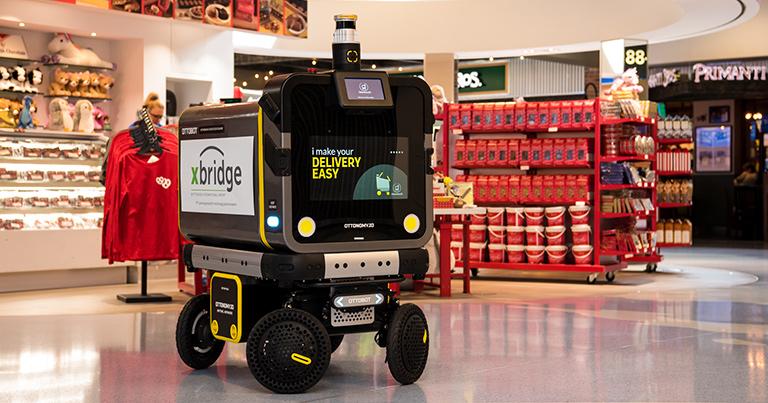
Perhaps an overriding trend this year and beyond will be increasing automation, using technology to streamline operations and offset rising labour costs. As this report in Forbes indicates: “Labour has typically represented about 25% of an airline’s cost. Over the next few years, many have forecasted that this will move to north of 40%.” With this in mind, investment in tech and automation is definitely paramount across the industry.
This is already being realised in innovative ways, such as using autonomous technology to future-proof airside operations. At FTE APEX Asia Expo in November 2022, Carolijn Schoofs, Head of Innovation, Royal Schiphol Group, explained Schiphol’s plans to achieve a fully autonomous airside operation by 2050. Automation will again be a key focus at this year’s FTE APEX Asia Expo, taking place in Singapore on 8-9 November 2023.
Avinor’s EU-funded autonomous baggage transport project has a big focus on robotics. Avinor is an Airport Lab Network Partner of FTE’s Baggage Innovation Working Group , for which automation will be a key focus area in 2023.
Meanwhile, in December we reported how Heathrow , alongside global consultancy and construction company Mace, has employed a robotic dog developed by Boston Dynamics, in a bid to improve efficiency and safety on major construction projects. The airport is refurbishing and modernising a cargo tunnel with updated mechanical and electrical services. The robot dog allows the project team to safely retrieve data from the building site, which is then used alongside 3D models and augmented reality to track accuracy and progress on the construction work. “Heathrow’s vision is to give passengers the best airport experience in the world and, in order to do that, we need great people, and we also need innovation,” said Emma Gilthorpe, Chief Operating Officer, Heathrow. “Dave the Dog has been a fantastic innovation enabling us to perform the tasks that we need to do – using robotics and automation.”
Autonomous robots are becoming increasingly prevalent at airports for the delivery of retail and food & beverage. In North America, Cincinnati/Northern Kentucky International Airport and Pittsburgh International Airport, through its xBridge Innovation Center, are among those having implemented the technology. In Europe, Aeroporti di Roma (ADR) has adopted a new fully autonomous delivery robot from startup company Ottonomy, which was one of 10 startups selected to take part in ADR’s acceleration programme ‘Runway to the Future’. “We chose automation as one of our topics for our first call for ideas because we truly believe in enhancing passenger experience with a continuous improvement approach,” said Emanuele Cala, VP Innovation & Quality, ADR.
Artificial Intelligence and Machine Learning
While Artificial Intelligence (AI) and Machine Learning (ML) come under the umbrella of robotics, we think it’s worth mentioning them in their own right.
We are particularly impressed by the capabilities of ChatGPT – a chatbot utilising AI and ML, which was launched by OpenAI in November and is generating a lot of attention. It is, of course, very early days, but we are excited about the possible applications in aviation and how it might be utilised.
Korean Air is among the airlines working towards introducing a machine learning management service, which will allow the airline to create, train and apply machine learning models to improve customer service by forecasting passenger and cargo demand more accurately.
Narita International Airport is proactively incorporating robotics and AI to promote business efficiency and enhanced productivity. It is also moving forward with the use of AI with the aim to improve customer satisfaction by using and analysing AI trained on real customer feedback.
Metaverse, digital twin and NFT
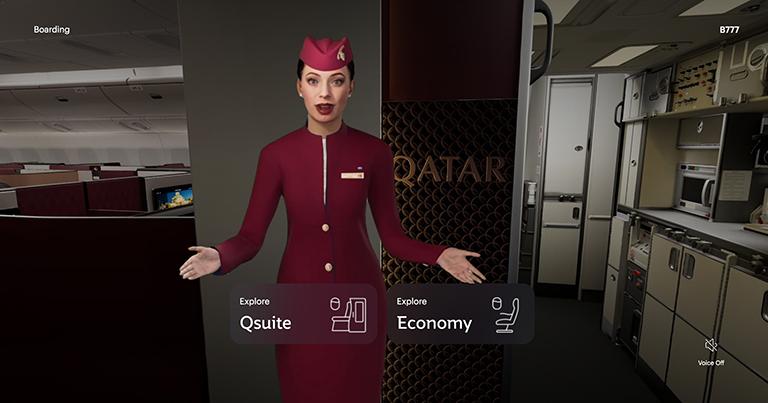
The metaverse – essentially an immersive virtual reality experience where people can interact with digital objects and digital representations of themselves and others – remained a hot topic at last week’s CES 2023.
In its recent ‘Meet the Megatrends’ report, SITA also highlighted that: “By 2030 metaverse operations will be commonplace at leading airports and play a vital role in optimising processes, avoiding disruption, and facilitating intuitive, immersive control of intelligent airports.”
While the full potential of the metaverse is a long way from being reached, progressive airlines and airports are already exploring opportunities and use-cases.
Bangalore International Airport Ltd (BIAL) – operator of Kempegowda International Airport, Bengaluru (BLR Airport) – has entered the metaverse with a T2 digital twin. It recently announced the first phase launch of the ‘BLR Metaport’ in collaboration with Amazon Web Services (AWS) and Polygon, which offers an immersive, 3D virtual experience of the newly-launched Terminal 2. “We are very excited that BIAL is entering into the new world of metaverse through the BLR Metaport,” said Satyaki Raghunath, Chief Strategy and Development Officer, BIAL. “This is our first foray into the world of Web3 and non-fungible tokens (NFTs), and we aim to delight travellers with a unique, immersive, and virtual experience. We also have several initiatives planned around the BLR Metaport, which promise to increase ways in which we can engage with our global audience and enhance business impact over the next few years.”
Qatar Airways has entered the metaverse with the launch of QVerse, a novel virtual reality (VR) experience for visitors to the airline’s website. Users of the www.qatarairways.com/QVerse website can virtually tour and navigate the Premium check-in area at Hamad International Airport, and the cabin interior of the airline’s aircraft, by using their own Personal Electronic Devices. The carrier is also the first global airline to introduce a MetaHuman cabin crew offering a digital interactive customer experience.
Meanwhile, Incheon International Airport Corporation participated in CES 2023 where, among other innovations, it showcased development of the first metaverse airport. The virtual airport, hosted on the Roblox global metaverse platform, has been designed to help passengers plan their travel and be well informed on how to check-in more efficiently using Incheon Airport’s smart check-in processes, including self check-in, self bag drop, off-airport check-in, and OneID Smart Pass.
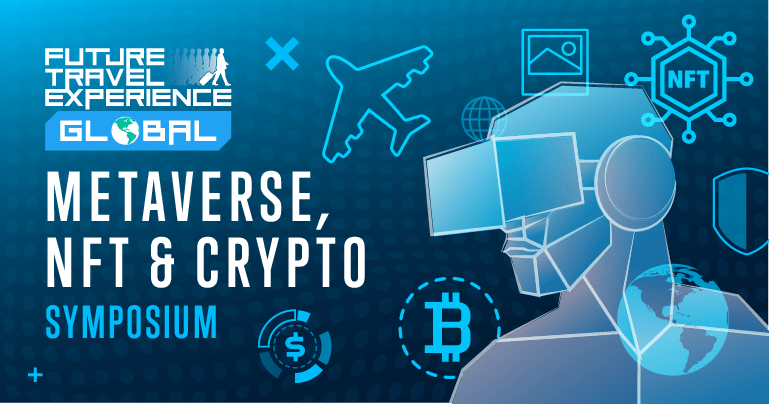
Personalisation
Travellers increasingly expect end-to-end personalisation at every step of their journey. At CES 2023, Delta Air Lines demonstrated how it is responding by showcasing Delta Sync – its vision for more personalised travel, which brings together an ecosystem of digital services and experiences.
Rolling out in 2023, Delta Sync is underpinned by SkyMiles membership and catalysed through free Wi-Fi to deliver personalised and exclusive inflight entertainment, more ways to enjoy onboard food & beverage, and exclusive partnerships with top consumer brands. “Delta Sync elevates what it means to be a Delta SkyMiles Member by enabling a journey that fits you perfectly and grows more rewarding the more you travel,” said Ed Bastian, CEO, Delta Air Lines. “The future of travel is one where your digital and physical experiences come together in a seamless, warm and personal way, making those human travel connections even more meaningful.”
New approaches to retailing
Significant steps forward in the transformation of airline retailing are taking place, with payment innovation, booking innovation, and all-you-can-fly subscription services.
A recent example is Finnair’s collaboration with Amadeus to build a next-generation airline retail offering, with personalisation and real-time insights. “Better retailing capabilities including dynamic pricing, upselling, cross-selling, bundling and unbundling support our target of boosting revenues and improving profitability,” said Antti Kleemola, Chief Information Officer, Finnair.
Icelandic low-cost carrier PLAY has also taken a new approach with its Internet Booking Engine (IBE). As part of this, it is planning the implementation of new features such as flight bundles, stopover flights and local payment options.
Aeromexico is utilising NDC technology to further enhance the shopping experience by providing richer and more customised content and supporting better upsell of its branded and ancillary products. “We are on our way to create a new marketplace for customised travel,” said Aaron Murray, Chief Commercial Officer, Aeromexico.
Meanwhile, a contactless retail experience is also being extended to an increasing number of airports. In September, Dallas Fort Worth International Airport opened three innovative concessions featuring grab-and-go technology – two featuring Amazon’s Just Walk Out Technology and one powered by Zippin. Meanwhile, in this interview with FTE, Sammy Patel, Vice President Commercial, Vantage Airport Group & Chief Executive Officer, Midway Partnership, explained how Vantage is “flexing its innovation muscle” with contactless commercial offers.

Urban Air Mobility
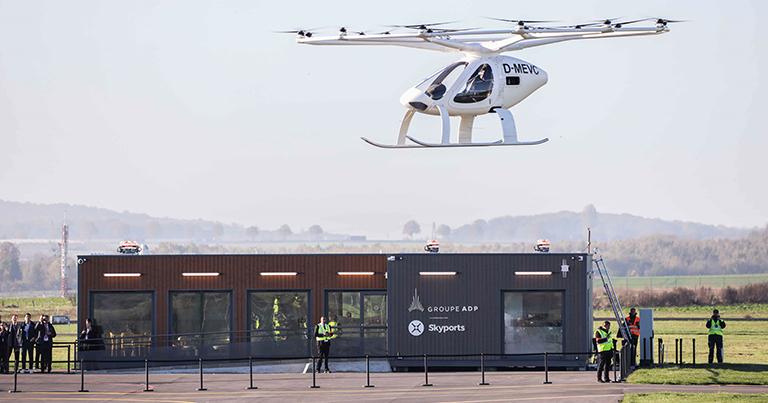
Urban Air Mobility continued to gain momentum last year, with several airlines and airports around the world accelerating this continuing trend. Groupe ADP and Skyports have unveiled a passenger terminal testbed for future electric vertical take-off and landing (eVTOL) in Paris, with plans for commercialisation in 2024; Aeroporti di Roma has deployed the first fully functional vertiport in Italy – a major step towards activation of Advanced Air Mobility (AAM) routes between Fiumicino Airport and Rome city centre in 2024; and São Paulo International Airport has selected VPorts and Air Traffic Management Inc. to build and operate a vertiport hub to open at the end of 2023.
Significant investments are being made by some of the biggest airlines too. Delta Air Lines has embarked on a multi-year, multi-market commercial and operational partnership with Joby Aviation to pioneer home-to-airport eVTOL transfer services. It has made an upfront equity investment of $60 million in Joby, with the opportunity to expand the total investment up to $200 million. Virgin Atlantic , meanwhile, has joined a consortium alongside Vertical Aerospace, Virgin Atlantic, Atkins, Skyports and NATS to develop key technology and infrastructure to accelerate the introduction of AAM in the UK by 2030.
The second FTE Air MobilityX Summit took place during FTE Global 2022 and reflected this growing trend, offering extensive insights into the future mobility landscape, and demonstrating the major growth opportunity that exists. Indeed, according to SITA’s recent ‘Meet the Megatrends’ report: “By 2032, electric air taxis will be ubiquitous at major international airports and operate as an effective auxiliary service and revenue stream for airports and airlines.”
Biometrics and digital identity
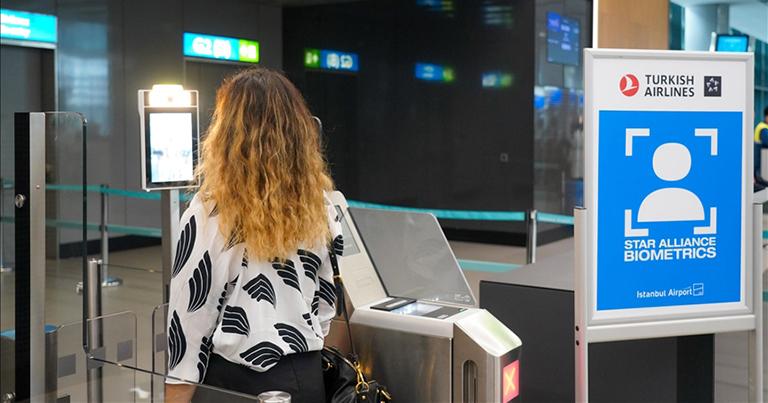
Biometrics has become a perennial fixture in our annual trends report. The post-pandemic preference for contactless technologies has only served to accelerate biometric adoption and its acceptance by travellers. IATA’s 2022 Global Passenger Survey indicates that: “Passengers see value in biometric identification. 75% of passengers want to use biometric data instead of passports and boarding passes.”
Implementation of biometric technology continues at pace globally. The many projects we have recently reported on include Turkish Airlines and Istanbul Airport testing the Star Alliance Biometrics access system; Philadelphia International Airport installing technology for a biometric boarding process; and British Airways trialling biometric check-in and boarding for international flights.
Last year, American Airlines launched a new partnership with the Transportation Security Administration (TSA) to test mobile identification. Customers with TSA PreCheck can now go through the airport with just their phone and their face.
The TSA , in collaboration with the State of Arizona and Apple, has also deployed a new digital technology for identity verification at Phoenix Sky Harbor International Airport’s security checkpoints. Arizona-resident travellers can now verify their identity using their state-issued mobile driver’s license or mobile identification card issued in Apple Wallet on iPhone or Apple Watch.
Digital identity was explored at FTE Global 2022 , with insights from the likes of American Airlines, Airside, Paravision and Entrust, and it will remain a key area to watch in 2023.
Private Networks
Private wireless is one of the hottest opportunities for air transport stakeholders – a foundational core enabling technology that provides the connectivity needed for an “internet of everything” to support anything from autonomous vehicles on the ramp through to optimised operations at the gate for airlines.
The technology was explored at FTE Global 22 in the successful Private Networks Symposium, featuring Miami International Airport, Dallas-Fort Worth International Airport, Metropolitan Airports Commission, Barich, Inc and ExteNet Systems.
Fraport last year launched a new strategic partnership with NTT to build Europe’s largest private 5G campus network at Frankfurt Airport. Thanks to the network’s high bandwidth and low latency, Fraport will be able to accelerate innovative projects, such as autonomous driving on the apron. The 5G network also enables real-time data transfer, which may be necessary for future applications, such as video-based monitoring of airport facilities via robots or drones. “Operating a standalone mobile network is a milestone for us as an airport operator,” said Dr. Wolfgang Standhaft, CIO, Fraport. “We are laying the strategic foundations that will help us make airport operations even more efficient in the future, thanks to innovation and digitalisation.”
Return to collaboration with startups
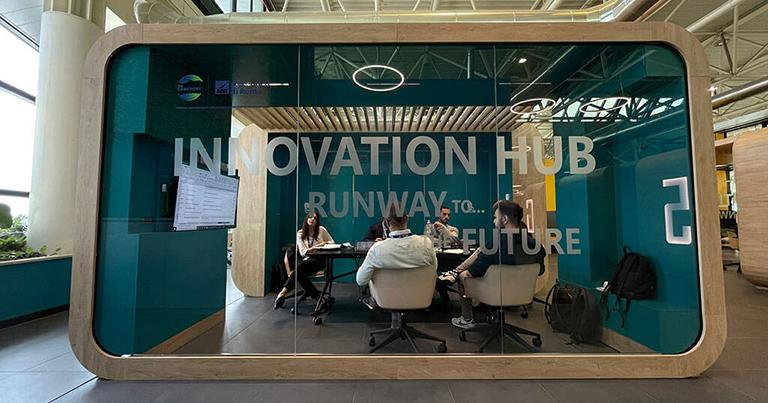
During the pandemic, collaboration with startups inevitably took a back seat. Now that the industry is truly back up and running it is firmly back on the agenda, with progressive airports and airlines increasingly collaborating with high potential startups and scaleups.
Aeroporti di Roma (ADR) recently launched a second ‘Call for Ideas’ from startups. After the success of the first ‘Call for Ideas’, which saw the implementation of 10 projects selected from over 100 applications, this new round of ADR’s acceleration programme will offer eight successful applicants the opportunity to work on their projects directly from the ADR Innovation Hub, which was inaugurated in October 2022 and is located at the heart of Rome Fiumicino Airport’s Terminal 1. Successful applicants will receive the support of mentors from the ADR ‘Innovation Cabin Crew’ and during the ‘Runway to the Future’ programme startups will have the opportunity to get in touch with national and international partners, and work with a network of airports focused on innovation within an environment entirely dedicated to startups.
Canadian airline WestJet is among the latest carriers to highlight its commitment to engaging with startups, specifically around the topics of artificial intelligence and machine learning, providing another example of the renewed appetite within the industry to collaborate closely with the startup scene.
The exponential growth of the FTE Digital, Innovation & Startup Hub demonstrates this trend, which we expect to further accelerate in 2023 and beyond.
Sustainability
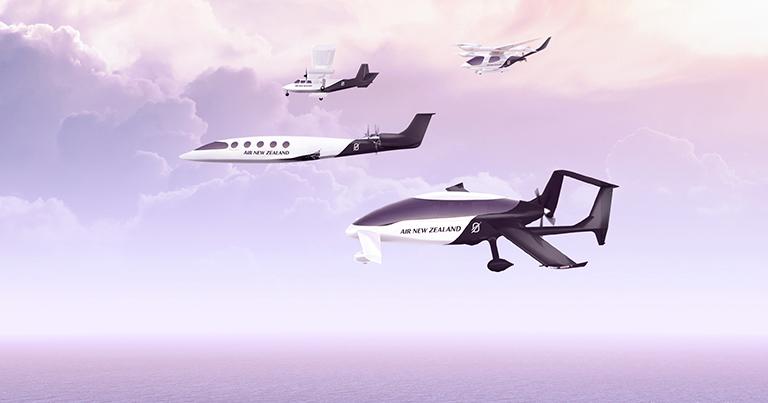
A common theme throughout the majority of innovation projects taking place across air transport is sustainability, which remains a key priority following the global industry’s commitment to reaching net zero carbon emissions by 2050.
Net zero will be reached through a combination of initiatives, including Sustainable Aviation Fuels, new aircraft technology, more efficient operations and infrastructure, and the development of new zero-emissions energy sources such as electric and hydrogen power.
Air New Zealand recently announced four innovators it will be working with on its mission to have its first zero emissions demonstrator flight take to the skies from 2026: Eviation, Beta, VoltAero and Cranfield Aerospace. A combination of electric, green hydrogen, and hybrid aircraft, these partners will work alongside Air New Zealand over the coming years to focus on developing the technology and associated infrastructure required to make flying these aircraft in New Zealand a reality. “Mission NextGen Aircraft is not about backing one innovator,” said Greg Foran, CEO, Air New Zealand. “It’s about working with a range of leaders in zero emissions aircraft technology to help move the whole ecosystem along. The learnings we will take from flying an aircraft with next generation propulsion technology from 2026 will then pave the way for our long-term partners to deliver an aircraft that can replace our Q300 turboprop domestic fleet.”
Another interesting project is the new Hydrogen Aviation Lab that has opened at Hamburg Airport in a decommissioned Airbus A320. The project is a joint initiative between Lufthansa Technik, the German Aerospace Center (DLR), the ZAL Center for Applied Aeronautical Research and Hamburg Airport, and is funded by Hamburg’s Ministry of Economic Affairs and Innovation as well as the city’s investment and development bank (IFB Hamburg). Over the next few months, the Hydrogen Aviation Lab will be fitted with a full suite of test systems, as well as an internal tank for liquid hydrogen and an onboard fuel cell, paired with supporting ground-based hydrogen infrastructure. “Climate-friendly flying with hydrogen technology is an important building block for the future of aviation,” said Michael Eggenschwiler, CEO, Hamburg Airport. “Through research projects such as this hydrogen laboratory, we ensure that all aviation partners contribute their experience to the development processes.”
Indeed, it is ultimately only through such collective, industry-wide efforts that net zero will be achieved.
You may also want to read...
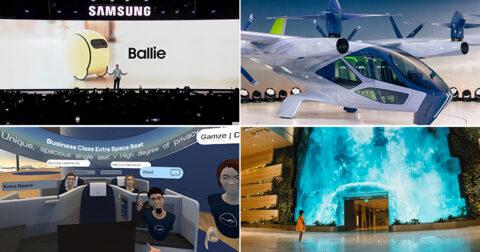
12 technology and CX trends that can enhance airline and airport operations in 2024
FTE explores a selection of the top trends and technologies for 2024 and beyond, including robotics and automation, biometrics and digital identity, sustainability, Urban Air Mobility and more.
Ancillary , Biometrics , Digital Transformation , Mobility , On the Ground , Personalisation , Robotics & AI , Startups , Sustainability , Up in the Air // Jan 2024
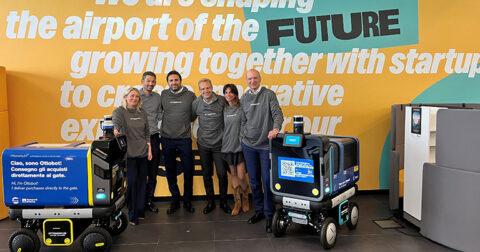
ADR Ventures invests in Ottonomy after successful launch of autonomous delivery robot at Fiumicino Airport
ADR Ventures, the new Corporate Venture Capital arm of Aeroporti di Roma (ADR) – a Corporate Partner of the FTE Digital, Innovation & Startup Hub – has announced its initial venture investment with Ottonomy.
On the Ground , Startups // Jun 2023
Future Travel Experience Ancillary
11-13 June 2024, Dublin
Empowering the airline sector to profit from collaborative digital retailing opportunities at every step of the journey
Future Travel Experience EMEA
A gathering of air transport’s digital and innovation leaders, creative designers and progressive minds who will inspire one another and reimagine travel together.
Future Travel Experience Global
28-30 oCT 2024, California
Where the world's most progressive travel facilitators define tomorrow’s end-to-end passenger experience

Future Travel Experience APEX Asia EXPO
19-20 November 2024, Singapore
Connecting vendors with airline and airport executives to transform tomorrow’s end-to-end passenger journey across Asia-Pacific
Get Future Travel Experience news & updates sent to your inbox

Dont remind me again X Close
- Search Please fill out this field.
- Manage Your Subscription
- Give a Gift Subscription
- Newsletters
- Sweepstakes
We independently evaluate all of our recommendations. If you click on links we provide, we may receive compensation.
- Travel Products
- Tech Essentials
The 22 Best Travel Tech Essentials of 2024
Here’s all the gear you need to make your travel experience better from tablets to headphones.
:max_bytes(150000):strip_icc():format(webp)/Stefanie-Waldek-7eed18a8c9734cb28c5d887eb583f816.jpg)
In This Article
- Our Top Picks
- Tips for Buying
Frequently Asked Questions
- Why Trust T+L
Travel + Leisure / Alli Waataja
We live in a technologically advanced society, and that means we usually bring some sort of gadget with us wherever we go, even if it’s just a phone. Some provide entertainment — like tablets, eReaders, and headphones — while others can make journeys more convenient or comfortable instead (such as luggage trackers, folding keyboards, and portable sound machines). To help you discover what your packing list could be missing, we've compiled a list of our favorite tech-related items whether you’re traveling for fun or business.
Best eReader
Amazon kindle paperwhite.
It has a 10-week battery life.
You need to pay a fee to get rid of the ad-supported lock screen.
One of the biggest players in the eReader game, the Kindle Paperwhite hits all the marks when it comes to features you need in a digital book. It has a 6.8-inch glare-free display screen with adjustable warm lighting for reading in the dark (say, on a plane at night), with a monumental battery life of 10 weeks and storage capabilities up to 16 GB. It's also water-resistant for poolside reading.
Best Earbuds
Bose quietcomfort earbuds ii.
The highly effective active noise cancellation technology drowns out annoying ambient sounds.
Our testers noticed inconsistent battery life after six months of use.
When we tested these Bose earbuds , we were impressed by a number of features, including effective active noise cancellation (ANC) technology, quick Bluetooth connectivity, and a lightweight fit. We also love that each pair comes with three sets of rubber earpieces, each a different size to accommodate multiple ear shapes and sizes. And, as for sound quality, Bose can't be beat, whether you're listening to music or taking a call. Though the headphones are pricey, we think these features make them worth the cost.
Best On-ear Headphones
Apple airpods max.
The ANC works particularly well for phone calls or Zoom meetings.
The only way to turn them off is by putting them in their carrying case.
These days, it's not good enough for a pair of headphones to simply deliver good sound — it needs to block sound, too. The Apple AirPods Max Wireless Over-ear Headphones do the trick with their ANC technology, which we found to be top-notch in tests . We also loved the intuitive nature, which can quickly and easily be controlled by buttons on the earpiece. But the one flaw here is that to turn them off, you must put the headphones in their carrying case. We'd appreciate a simple power button next time!
Best Power Bank
Tg90° portable charger.
It's the size of a credit card and has built-in cords.
It only holds approximately 1.5 full charges for most phones.
Portable charges come in all shapes and sizes, but if it's portability and convenience you seek, your best bet is to purchase this handy little device. Roughly the size of a credit card (albeit thicker) and weighing just 4.32 ounces, the TG90° Portable Charger is easy to toss in your bag or in your pocket. At 6000mAh, it holds less than two full charges for most phones, but it works perfectly when you need some juice in a pinch. Best of all, it has built-in Lightning and USB-C cords attached, so you don't need to waste space with extra cords.
Best Adapter
Epicka universal travel adapter.
It has six ports for maximum charging capabilities.
It's only an adapter, not a converter, so it can't handle high-energy tools like hair dryers.
A travel adapter is a must-have tool for all international travelers, since socket shapes vary in different parts of the world, making it possible to work from anywhere . This one by Epicka is our tester favorite — it can be used in more than 150 countries, making it a practical all-in-one device. It has an impressive six ports for chagrin: four USB-A, one USB-C, and 1 AC socket. So no matter what type of charger you're using, you'll be able to plug it into this adapter. As a bonus, it comes in four colors so you don't have to choose the standard black of so many tech items.
Best Wi-Fi Hotspot
Netgear nighthawk m6 pro.
It's unlocked, so you can use it on most major cell networks.
It's very expensive for occasional use only.
Portable Wi-Fi hotspots can be useful when you're traveling somewhere without a guaranteed internet connection, but do note that you'll usually need cell service to operate them. NETGEAR's Nighthawk M6 Pro is unlocked, so you can use it on any major cell network by adding a SIM card — and it taps into both 5G and the new Wi-Fi 6E to offer the highest speeds possible. You can also use a wired connection if you happen to have an ethernet cable.
Best Luggage Tracker
Eufy smarttrack link.
It's less expensive than an AirTag.
It isn't Android-compatible.
Apple AirTags might seem to run the show, but in our tests , we preferred Eufy's SmartTrack Link. For one thing, it's cheaper than an AirTag. And for another, it still works with the Find My app on iPhone just like an AirTag. Simply activate the device with the app, then put it in your checked suitcase, and you'll be able to track your bags as they make their journey through the airport and into your plane's cargo hold.
Best Projector
Nebula by anker solar portable projector.
It's compact yet still offers high-quality images and sound.
The power cord is quite short.
No, you probably won't need a portable projector on every trip you take. But if you're heading to a beach house or in a cabin in the woods, it could be a fun way to have a family movie night — particularly if your vacation rental lacks a big TV. If you're using your projector outdoors , note that we found this device to have a 3-hour battery life, which should work for most movies. Otherwise, you'll want to bring an extension cord to plug it in, as its built-in cord is just two feet long.
Best Smart Sunglasses
Ray-ban meta headliner.
You can't beat the video, photo, and audio quality.
The battery life isn't the best among smart glasses.
We've always been fans of Ray-ban sunglasses, but these smart glasses take the game to the next level. Within these frames, which have a slightly different shape than Ray-ban's classic Wayfarer, is a 12-megapixel camera with an ultra-wide lens to capture photos and videos that you can upload onto other devices like digital picture frames — and you can even live stream directly to Facebook or Instagram. There are five built-in microphones to capture audio, whether that's during a video recording or a phone call for extra-clear sound. The audio output quality is excellent, too, for both music and calls.
Best Digital Notebook
Rocketbook core.
You can scan a QR code to save your entries in an app.
It takes some getting used to a digital notebook rather than a traditional one.
Digital notebooks might not have the nostalgia factor of a traditional notebook, but they are pretty handy if you do a lot of journaling or doodling while you're traveling. This way, you won't have to lug around multiple notebooks on a months-long adventure! With Rocketbook Core, you can write or draw on the pages of the notebook with a Pilot pen , then scan a QR code to upload to an app. Once you're ready to start fresh, you can just wipe down each page with a slightly damp microfiber cloth (included). This is the full-size model, but there's also a mini size available if you'd prefer something more travel-friendly.
Best Laptop
Apple macbook air 13.6” laptop.
If you need to work on the road, this is lightweight yet reasonably powerful.
The base model only has 8GB of RAM.
If you're an Apple person, the newest MacBook Air is the best device for travelers. It has the ultra-fast M2 processing chip which is 1.4 times faster than the previous model, the M1. And, as an Air, it's lighter than the standard MacBook or MacBook Pro models which is always helpful when traveling. However, what we really love about the newest MacBook Air is that it's returned to a magnetic charging port, so you don't have to worry about accidentally ripping out your charging cable or pulling down a laptop if you trip over the cord.
Best Tablet
Apple 10.9” ipad (9th generation).
Since it's not the newest model, it's usually on sale.
It's best for entertainment rather than intense productivity.
Some planes aren't equipped with built-in in-flight entertainment systems, which means you should probably bring a tablet on your next trip . We're partial to the Apple iPad, specifically, not the latest model for one simple reason: it's usually on sale. Unless you plan on working from your iPad, in which case you'd probably want to upgrade to something more powerful or even a laptop, this one will do just fine for things like watching movies and shows. It'll still work for other tasks where a screen larger than a phone comes in handy, like sending email, making notes, and even taking photos.
Best DSLR Camera
Sony alpha 7r v.
It takes both excellent stills and video, thanks to its 61 megapixels and 8K video quality.
Lenses must be purchased separately.
For those seriously interested in photography and videography, you can't go wrong with the Sony Alpha 7R V. Ultimately, it has extremely high-quality imagery and video that works on a professional level. We're also impressed with its smart features, including fast Wi-Fi, real-time auto video tracking, and accurate subject recognition. And, for travelers, it's fairly lightweight for a DSLR, and it has a long battery life. Just know that it’s on the more expensive side if you’re just dabbling and the price does not include any lenses.
Best Point-and-shoot Camera
Sony rx100 iii 20.1 mp premium compact digital camera.
It's highly portable.
It's pricey for a point-and-shoot, though it does offer superior quality.
For more casual travel photographers, a point-and-shoot camera like the Sony RX100 III is an easier-to-use, more-travel-friendly option than a DSLR with much higher quality than a smartphone. It's still a smart camera, with built-in WiFi, a touch screen, and continuous autofocus to use in video mode, but it's far smaller and more lightweight than a DSLR. One feature we particularly like is its zoom — the built-in Leica lens has a 24–720-millimeter zoom range.
Best Portable Speaker
Ultimate ears wonderboom 3.
It offers bold sound for such a compact size.
It can be tricky to connect with other Wonderboom speakers (for surround sound).
Headphones are great for solo listening, but if you're with a group, you're going to need a portable speaker. We love the Ultimate Ears Wonderboom 3, first and foremost, for the small size and loud, crisp sound, but, second, for its waterproof and dustproof nature. That means it's perfectly fine to take this on a more rugged journey into the woods or to a beach party, or toss it in a backpack without concern. If you want to amplify the noise, you can connect it to multiple Wonderboom speakers, though we found the process a little bit complicated.
Best Portable Monitor
Asus zenscreen go 15.6" ips lcd fhd monitor.
It has a 3.5-hour battery life.
It's portable, but heavier than other portable monitors.
Nothing beats a multi-screen set-up in your office, but bringing multiple screens on the go isn't realistically feasible. Or is it? Enter: the portable monitor. ASUS ZenScreen is a 15.6-inch screen with an adjustable kickstand that can easily be set up as a second monitor with its included adapters. Or you can use it as a larger screen to stream from your phone, thanks to wireless mirroring capabilities with Apple, Android, and Google. Perhaps most impressively, it can run on battery power alone for up to 3.5 hours.
Best Folding Keyboard
Samsers foldable bluetooth keyboard.
It can be used for various devices, including your phone.
The included stand is only designed for phones, not tablets.
For people who have to type lengthy emails, articles, or notes during their travels, sometimes the touchscreen keyboard of your phone or tablet doesn't cut it. If you'd like to leave your laptop behind but still have full typing capabilities, you'll want to pack this foldable Bluetooth keyboard . It's super compact, lightweight, and long-lasting (up to 40 hours of use on a single charge), but it unfurls to a full keyboard size.
Best Mini Photo Printer
Canon selphy square qx10 compact photo printer.
The photos are printed with a peel-off adhesive backing.
You can only print square photos.
Turn any camera into an instant camera with this portable photo printer. The Canon Selphy QX10 prints images on 2.7 x 2.7, adhesive-backed photo paper, making it easy to stick them into a notebook or onto a wall. If you download the Canon Selphy app, available on both iPhone and Android, you can even create multi-photo layouts and add effects, filters, and stickers to your images before printing.
Best Portable Sound Machine
Babelio white noise machine.
It's truly pocket-sized — and cheap!
You can't add your own sounds, as they're all pre-programmed.
Can't sleep without white noise? Bring this teensy portable sound machine with you on your next trip. There are 15 sound options on the device, which rain from white and pink ambient sounds to natural sounds like waves and rain. The battery will last the whole night (charged by a USB-C port), or you can set a timer for 30 or 60 minutes to automatically shut the sound machine off.
Best Headphone Adapter
Twelve south airfly pro.
It connects wireless headphones to in-flight entertainment systems.
Sometimes there's a slight lag in the audio.
While many headphone-wearers have cut cords and opted for wireless earbuds or headphones, in-flight entertainment systems on planes are still largely wired (though cabins are slowly debuting wireless audio capabilities!). Not only are they wired, but they're only compatible with a traditional 3.5-millimeter headphone jack. Fortunately, there's AirFly, a device that transmits audio from that jack to your wireless headphones via Bluetooth. It has up to 20 hours of battery life, which pretty much covers every flight in the world.
Best Tech Organizer
Bagsmart cable organizer bag.
There are multiple loops and pouches for cables, as well as pockets for memory cards.
It's not particularly small, so if you only have a few items to store, you might want to pick a more petite model.
Cords tend to get tangled in transit, so keep all your chargers nice and tidy with a tech organizer . This one has a variety of pouches and loops that can be used to keep your cords separate, as well as pockets for other small tech gizmos, like a Lightning to USB adapter or lightning to audio jack adapter. There's a spot for everything in this organizer, which makes it a touch bulky. You can always opt for a smaller version if you don't think you'll fill this one.
Best Laptop Backpack
Solo re:define backpack.
It has a compact silhouette but a sneakily large interior.
We noticed a zipper fraying after four months of use.
If you're traveling with a laptop, you'll definitely want some sort of bag or carrying case to store it in. Because laptops can be fairly heavy — or at least feel heavy after lugging them around all day — we recommend a laptop backpack. In our tests , we ranked Solo's Re:Define Laptop Backpack quite highly, praising it for its slim look yet surprisingly spacious interior. Then, of course, there's a padded laptop pocket that can fit devices up to 15.6 inches in size. With its sleek look, we think the bag is great for both students and commuters, but it'll also fare well on leisure trips, too.
Tips for Buying Travel Tech Essentials
Prioritize convenience, entertainment, or both.
Typically, travel tech essentials should either make things more convenient as you travel, or provide entertainment on a long day or during downtime at your destination. Of course, exact purposes vary but, before deciding to buy (or pack) any travel tech items, consider their portability as well as how much use you’ll get out of each pick as space is often limited on the go.
Plan for your organizational needs
Remember that you're going to have to store your travel tech somewhere so have an organizational plan in mind for the items you plan to bring. You can do this with bags with numerous pockets, such as easy-access ones where you can stash things you might need to take out frequently, such as your passport or headphones. Or you can store important items in smaller bags that go into bigger ones such as a cord organizer or travel pouch .
Consider your mode of transportation, your destination, and your itinerary. Are you packing essentials for a road trip , or taking a plane or train? If you have limited space, you may want to watch movies on your phone with a pair of earbuds. If you plan on taking long train rides or red-eye flights, on-ear, noise-canceling headphones may be an item you’ll want to leave space for in your bag. If you’re traveling for long periods and plan to work, a laptop or tablet and portable keyboard can come in handy, and if you know you’ll have a bunch of travel tech items, having some sort of organizer or a backpack with ample pockets will be key.
It's advisable to avoid bringing delicate and heavy items — the hardier and more lightweight, the better. Plus, remember that not all items can be taken on the road, specifically on planes. Lithium batteries and portable power banks, for example, cannot be stored in checked bags and must be brought with you in the cabin.
When flying, travelers commonly appreciate bringing headphones, headphone adapters, and portable entertainment like a tablet loaded with shows or movies or an eReader.
Why Trust Travel + Leisure
T+L contributor Stefanie Waldek is a freelance travel writer with a decade of experience. She flies 200,000 miles a year and spends months in remote destinations like Antarctica and the Arctic. so being fully prepared with tech essentials is part of her travel routine. For this article, she evaluated various pieces of travel tech to enhance a traveler's journey, taking into account personal experience, T+L tester insights, and customer reviews.
Love a great deal? Sign up for our T+L Recommends newsletter and we’ll send you our favorite travel products each week.
:max_bytes(150000):strip_icc():format(webp)/MAP-6ce9546f181240c688532a919598e720.jpg)
Related Articles
The 27 best travel gadgets in 2023
When you buy through our links, Business Insider may earn an affiliate commission. Learn more
For today's traveler, a packing list includes not only their daily wear and toiletries, but also tech gadgets: a phone, maybe a laptop or tablet, and possibly a smartwatch. You may also be wondering, what other gizmos are worth lugging around? As it turns out, there's a lot to consider.
Whether you're on a long-haul flight, a never-ending road trip, or just jetting around your destination, there are plenty of travel-appropriate tech gadgets that can make your next trip a breeze.
From gear to ensure you're charged up to a TSA-approved massage gun to ail the aches of travel, here are our favorite travel tech gadgets and accessories to ensure you're ready for anything that comes your way.
For keeping an eye on your valuables, put a Tile Pro or Apple AirTag in your checked baggage. We recommend Tile because it works for both Android and Apple devices, while utilizing the Tile user network to help you locate things that are much further away.
On the flipside: Apple's AirTag offers the same features, but only works with Apple devices. The AirTag connects to the Find My app built into every iPhone and iPad, which theoretically means it taps into a wider network of users to locate your item. Whichever you choose, consider a tracker in your luggage as personal insurance.
Insta360 X3 Camera
Sure, the best camera is the phone that's in your pocket, but if there's a reason to bring along an additional shooter, make it the the X3. This 360-degree camera works alongside a companion app on your phone and captures everything surrounding you. No longer will you need to choose what to frame. But what makes this camera truly fun are the special effects you can create, which will make your vacation photos and videos stand out from the crowd.
Sony WH-100XM5 Headphones
If you want the latest and greatest in over-ear noise-canceling performance, it's the Sony WH-100XM5s . The XM5s sport an updated design with a narrower headband and wider earcups for a roomier fit. The drivers have been updated and the ANC (active noise cancellation) performance has been kicked up a notch thanks to two processors and eight noise-canceling microphones, up from the four microphones found on the previous-gen XM4s. Speaking of the XM4s, they're still a great option and cost $50 less .
Beats Fit Pro
The Beats Fit Pro was released back in 2021, but they continue to be one of our favorite wireless earbuds. It packs the same features you'd get in the AirPod Pros, but in a more secure, sweat-resistant package. This year, Beats introduced three new eye-catching colors: coral pink , volt yellow , and tidal blue .
Panasonic ErgoFit Wired Earbuds
It's a good idea to have a pair of wired earbuds to toss in your bag for a flight, especially since most in-seat entertainment systems have yet to roll out support for Bluetooth. And while there are plenty to choose from, Panasonic's ErgoFit is a tried-and-true budget pair you won't regret. Available in more than 15 colors, these earbuds are as basic as you can get, but they'll get the job done for under $20. Just note that you'll need a Lightning adapter for Apple devices .
Anker 622 Magnetic Battery
If you own an iPhone 12 or newer and want to take advantage of MagSafe technology, this portable battery pack from Anker has a capacity of 5,000mAh, which is more juice than Apple's MagSafe battery pack , which is rated at 1,460mAh. The 622 is capable of wirelessly charging your phone at a max of 7.5 watts, but its best feature is the travel-friendly built-in kickstand. If you're looking for more power, Anker also sells a 10,000mAh version .
For more picks, check out our guide on the best MagSafe battery packs .
Mophie 3-in-1 Travel Charger with MagSafe
Apple stans will appreciate Mophie's 3-in-1 charger , which has dedicated charging spots for the iPhone, Apple Watch, and AirPods. We're not sure what we like more: the convenient carrying case or that it comes complete with a 30W USB-C wall adapter.
Fujifilm Instax Mini 12
The Instax Mini 12 is Fujifilm's newest camera, and just like its predecessor, it's a one-button instant camera that's so easy to use that even kids can operate it. The Instax Mini 12 improves on the lineup's winning formula by adding a new lens that you can twist to enable "close-up" mode. The entry-level instant camera works with Instax Mini film , which is widely available. Plus it runs on replaceable AA batteries, so you'll never have to worry about running out of power.
Anker 747 Charger
If you're a frequent traveler, you need a multiport charging hub. And Anker's GaNPrime-powered 747 Charger is one of the best you can buy right now . With three USB-C ports, one USB-A port, and 150W charging capacity, this compact charger can charge multiple devices — laptops, tablets, smartphones, or other small devices — quickly and all at once. And thanks to GaNPrime technology, the 747 is smart enough to identify how many devices are connected and how much output each device needs.
Native Union Belt Cable Universal
When it comes to cables, it pays to have a spare just in case you lose one. For that, we recommend this universal cable from Native Union. Measuring at 6.5 feet long and made from braided nylon, the cord can quickly transition between micro-USB, USB-C, and Lightning connectors.
Bellroy Tech Kit
A dedicated tech bag can turn the roost of cables, cords, and techy accessories you travel with into a well-organized mobile workstation. While you should shop around to find a tech organizer bag that suits your particular needs, the Tech Kit from Bellroy is a quality option. It features a soft-shell body for added structure and protection, along with loops, pockets, and compartments to neatly store your essentials. It's also available in a compact size .
For more options, check out our guide on the best tech organizer bags .
Nimble Champ Portable Charger
The Champ Charger is one of Nimble's smallest and lightest power banks, but it still packs a punch. It's designed to top up smaller devices, and supports up to 15W of charging through one USB-A port and one USB-C port. The battery's 10,000mAh capacity is enough to charge your phone or tablet for a weekend of use. Bonus: Nimble is a certified B Corp with a commitment to sustainable consumerism currently unmatched in the consumer tech industry, from using non-traditional materials and plastic-free packaging, to its free e-waste recycling program.
DJI Osmo Mobile 6
Unfortunately, nobody wants to watch your vacation videos if they're nauseatingly bouncy, no matter how beautiful the scenery is. To capture rock-steady footage with smooth pans and tilts — think Hollywood-style cinematography — put your phone into what is the best gimbal for consumers. It's easy to operate, and the built-in telescoping pole lets you capture selfies with a wider view.
Moft Invisible Laptop Stand
When you're on the road, ergonomics is a challenge. Moft's "invisible" laptop stand is an ultra-thin portable stand that won't add any weight to your laptop, and only takes a second to put into action. It has two elevation angles (15 and 25 degrees), which you can adjust to whichever is more convenient for your sitting posture. Moft also sells stands for other devices, including the iPad and iPhone .
Epicka Universal Travel Power Adapter
If you're jet-setting across the world, a universal travel adapter is a must. And you won't find one that'll meet most simple charging needs than Epicka's all-in-one adapter. This handy plug is designed for phones, laptops, and other smaller devices. The retractable prongs allow it to work in more than 150 countries, and it has six charging ports: four USB ports, one USB-C port, and one universal AC socket.
Backbone One Mobile Controller
For gaming on the road, we recommend the Nintendo Switch . But if you're looking for an alternative with even better portability, we highly recommend the Backbone One Mobile Controller, which can turn gaming on your iPhone or Android phone into a first-class handheld console experience. The Backbone One gives you joysticks and buttons, so it's comfortable for long playing sessions, and it works with mobile titles as well as cloud-gaming services like Xbox and PlayStation Remote Play.
Yogasleep Rohm Travel Sound Machine
With Yogasleep's Rohm Travel Sound Machine , you can rest easily wherever the road takes you. It features three modes: bright white noise, deep white noise, and "gentle surf." And unlike other portable sound machines, it's powered by a rechargeable battery instead of disposable batteries. If you're looking for something more baby-friendly, the Hushh Compact Sound Machine features a soft LED night light and child-safe locks.
GoPro Hero 12 Black Action Camera
If you can only pack one camera for travel, make it the new GoPro Hero 12 Black. An evolution of the already impressive Hero 11 Black , it's small enough to fit in the tightest corners of a bag, yet it is on par with much larger cameras, thanks to 12 generations of innovation. This latest version of GoPro's storied Hero camera can shoot high-dynamic-range video for improved contrast and coloring, a wider field-of-view lens to capture more of a scene, and Bluetooth support for headphones. Plus, it has the best in-camera stabilization yet. It's built to withstand bumps, drops, and splashes, and a great smartphone app lets you upload your footage to social media wherever you are.
Kensington Privacy Screens
When you think of tech privacy while traveling, you might think of VPNs , which allow you to connect to the internet through a secure server so you can work securely and remotely. But for added security, don't overlook privacy screens. Kensington sells a number of reliable privacy screens — some attached with magnets, others by an adhesive, depending on your laptop or tablet — that reduces viewing angles and filters blue light .
Etekcity Luggage Scale
Overweight baggage fees can cost an arm and a leg and who knows what else, and they're especially tricky when traveling internationally. Etekcity's luggage scale is reliable and accurate, plus it's ultra portable and weighs under five ounces to easily fit in your bag.
TwelveSouth AirFly
A tiny dongle that lets you use your wireless headphones for in-flight entertainment? How smart. TwelveSouth's AirFly plugs into the audio jack so you can hear airline TV screens using your own personal headphones. And with more than 20 hours of battery life, it could last even the most long-haul flights. If you've got a travel companion, the AirFly Duo lets you connect two pairs of headphones at once. And for car rides in older vehicles, the AirFly Pro lets you stream from your phone to the stereo's aux-in port.
Logitech K380 Keyboard
Logitech's K380 keyboard is an excellent portable set of keys that has a small footprint that will make working even in the most cramped spaces a little more comfortable. It connects to any device that supports Bluetooth and pairs with up to three devices, which is perfect if you're switching between a laptop, tablet, and phone. It's ultra quiet, and can last two years one just two AAA batteries.
Ultimate Ears Wonderboom 3
The newest ultra-portable speaker from Ultimate Ears, the Wonderboom 3 is a 360-degree speaker that should fulfill your travel needs. It has battery life of up to 14 hours on a single charge. There's an "Outdoor Boost" mode that cranks up the bass, and it can float if you throw it in water. This is a versatile little speaker that can also pair with another Wonerboom speaker for stereo sound.
Kindle Paperwhite
Easily one of the best Kindles you can buy right now , the 11th-generation Kindle Paperwhite includes a larger 6.8-inch, high-resolution display, adjustable warm lighting, responsive page-turning, and USB-C charging. The base Paperwhite comes with 8GB of storage, which should be plenty for most people (that's around 3,000 e-books).

Hypervolt Go 2
A must-have for preventing and easing the aches and pains of traveling, the Hypervolt Go 2 weighs just 1.5 pounds and lasts up to 3 hours on a single charge. With three speeds and two interchangeable heads, it can do wonders for a stiff neck, sore muscles, back pain and more. It's also surprisingly quiet. The Go 2 is TSA-approved, as long as it's packed in your carry-on. Unfortunately, it doesn't come with a travel case.
Manfrotto Pixi Mini Tripod
Whether it's for timelapses, self-portraits, or video calls, a phone tripod can be surprisingly handy when you're on the go. Manfrotto makes some of the best travel tripods in the world, and its Pixi Mini Tripod folds up small (you can also use this tripod as a grip) and weighs less than a pound. Unlike some tripods, the Pixi Mini can be used with different types of phones thanks to its universal clamp.
Roku Streaming Stick 4K
If you're not traveling with a streaming stick, you're missing out on a simple travel hack. You can plug it into your hotel room or Airbnb's TV and stream your favorite movies and shows. Roku's Streaming Stick 4K is well-suited for travel, and will give you great picture quality, whether streaming in HD, 4K, or HDR. Just don't forget to bring the physical Roku remote.
You can purchase logo and accolade licensing to this story here . Disclosure: Written and researched by the Insider Reviews team. We highlight products and services you might find interesting. If you buy them, we may get a small share of the revenue from the sale from our partners. We may receive products free of charge from manufacturers to test. This does not drive our decision as to whether or not a product is featured or recommended. We operate independently from our advertising team. We welcome your feedback. Email us at [email protected] .

- Main content
18 Companies & Startups Revitalizing Travel in 2024

You may also like:
- Top Travel Industry Trends
- 20 Disruptive Transportation Startups
- 6 Important Hospitality Trends
The travel industry was one of the hardest hit industries during the pandemic.
In 2023, global tourism recovered, jumping back to 84% of pre-pandemic levels . Also, global travel and tourism revenue is expected to grow from $927.3 billion in 2024 to $1.1 billion by 2028.
However, the industry as a whole isn't expected to recover until 2027 .
Despite that, some travel startups are still growing exponentially.
Check out this list of companies that are looking to revitalize the travel industry in 2024 and beyond.
1. TravelPerk

5-year search growth : 172%
Search growth status : Exploding
Year founded : 2015
Location : Barcelona, Spain
Funding : $530M (Series D)
What they do : TravelPerk is a travel management platform designed to simplify business travel. It offers a centralized platform for booking, managing, and analyzing business travel, with features such as real-time booking, expense management, and travel policy enforcement. The company aims to reduce the time and cost associated with business travel while providing a seamless and enjoyable experience for travelers.
In 2023, revenue grew 70% and gross profit 90% year over year as annual booking volumes reached $2 billion. The company also raised an additional $104 million in January 2024 at a valuation of $1.4 billion.
2. SafetyWing

5-year search growth : 9,800%
Year founded : 2017
Location : Palo Alto, California
Funding : $47.1M (Series B)
What they do : SafetyWing is an insurtech company that focuses on digital nomads. Their flagship, "Nomad Insurance," is accepted across several different countries (ideal for travel). SafetyWing also offers a B2B "Remote Health" product that provides coverage for remote teams. In 2023, SafetyWing grew revenue to $20.3 million and served over 25,000 customers .

5-year search growth : 99x+
Year founded : 2019
Location : Singapore, Singapore
Funding : $67.3M (Series B)
What they do : Airalo is an alternative to using multiple SIM cards while traveling. Specifically, the company offers over 190 affordable "eSIMs" that can be switched over with a few clicks. eSIMs aren't supported by all smartphones, but they are becoming an increasingly common feature in newer models. The SIM company recently raised $60 million in its most recent series B funding round.
4. Roadsurfer

5-year search growth : 900%
Location : Munich, Germany
Funding : $33.9M (Series Unknown)
What they do: Roadsurfer rents customized camper vans in 13 European countries and, most recently, the United States. In addition to the core rental service, the startup offers a number of optional add-ons for each trip, like kitchen cutlery. Each plan also includes an insurance policy. Today, the company has 70 stations across Europe and North America .
5. YouLi (YouLive to Travel)
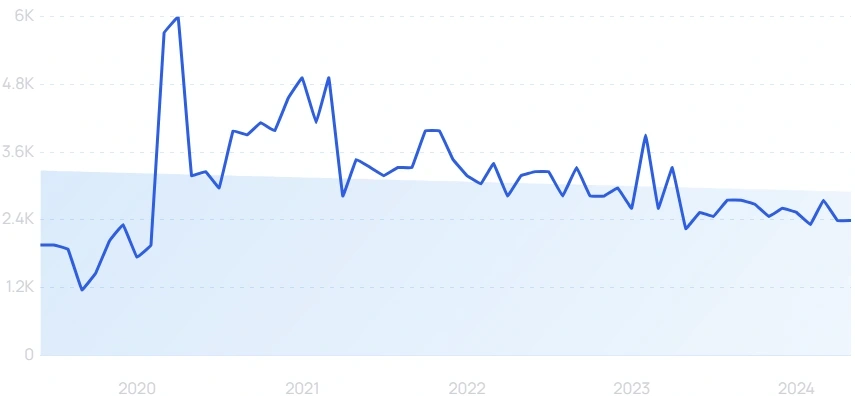
5-year search growth : 22%
Search growth status : Peaked
Year founded : 2016
Location : Melbourne, Australia
Funding : $200K (Angel)
What they do : YouLi is an all-in-one travel management software for organizing group trips and company retreats. The software includes a number templates for different types of travel itineraries. The software also has a member's area that travelers can use to manage and pay for their trips.
6. PickYourTrail

5-year search growth : 23%
Search growth status : Regular
Year founded : 2014
Location : Chennai, India
Funding : $3M (Series Unknown)
What they do : PickYourTrail is a platform for booking entire trips online (including flight, road transportation, and lodging). The startup reports that 46,000 people have used the service to date.

5-year search growth : 400%
Location : New York, NY
Funding : Undisclosed
What they do : Tracki is a travel tech startup that provides real-time GPS tracking solutions for individuals, families, and businesses. Their products range from portable GPS trackers to asset trackers and pet trackers, which can be easily monitored through their mobile app or web platform. The app has more than 500,000 downloads on the Google Play Store.
8. Very Local Trip

5-year search growth : 300%
What they do : Very Local Trip connects travelers with local tour guides. In other words, the startup is a focused version of Airbnb's "Experiences" feature. Currently, the startup offers experiences all over the world in Asia, Europe, North America, and the Middle East.

5-year search growth : 3,233%
Year founded : 2018
Location : Madrid, Spain
Funding : $200.6K (Seed)
What they do : Holafly is an eSIM startup that offers international data plans for travelers. The company partners with local providers in different countries and offers unlimited data plans for a fixed time period. Currently, the startup operates in 160+ countries with 1 million customers worldwide.

5-year search growth : 6%
Location : New York, New York
Funding : $181M (Series D)
What they do : Away is a DTC travel brand. Often called the “Warby Parker for suitcases,” the company keeps overhead costs low by selling direct-to-consumer. Away's product line includes travel luggage, sleep masks, travel pillows and blankets, and compression socks.

5-year search growth : 284%
Location : Denver, Colorado
What they do : GOTRAX is an electric scooter company that provides affordable and eco-friendly transportation solutions for urban dwellers. With a range of electric scooters for adults and kids, GOTRAX offers a convenient and cost-effective way to navigate through busy city streets.
12. Lodgify

5-year search growth : 217%
Year founded : 2012
Funding : $36.6M (Series B)
What they do : Lodgify develops software that helps property owners manage their vacation rental properties. The all-in-one website includes features to manage bookings, accept reservations, and synchronize across different platforms, including Airbnb, Vrbo, and Expedia.
13. Bobobox
5-year search growth : 325%
Location : Badung, Indonesia
Funding : $13M (Non-Equity Assistance)
What they do : Bobobox is a technology-based hospitality startup that provides affordable and accessible capsule hotels for travelers in Indonesia. The company utilizes an app-based platform that allows customers to book and manage their stays, as well as access various hotel amenities and services.
Bobobox aims to revolutionize the hospitality industry in Indonesia by offering affordable and convenient lodging options that cater to the needs of modern travelers. The app has generated more than 1 million downloads on the Google Play Store.

5-year search growth : 10%
Location : Bucharest, Romania
Funding : $1.8M (Seed)
What they do : Questo is a mobile app for iPhone and Android that gamifies city exploration. Users embark on "quests" to discover interesting spots and learn about local lore. Each quest is designed by a local "creator." The app currently offers quests in over 500 cities to more than 400,000 players.
15. Bespoke

5-year search growth : 8,700%
Location : Tokyo, Japan
Funding : $2.5M (Series B)
What they do : Bespoke has developed an AI-powered chatbot designed for multilingual guest services. Their software provides hotel guests with answers to hotel-specific questions, local recommendations, and restaurant reservations. Bespoke was used by the Japanese government during COVID-19 to communicate critical health and safety updates to residents and travelers.
16. Tailos (Formerly Maidbot)

5-year search growth : 14%
Location : Austin, Texas
Funding : $50K (Series B)
What they do : Tailos , formerly Maidbot, manufacturers a housekeeping robot (named Rosie) designed to clean hotels and commercial buildings. Rosie takes on "dull, dirty, and dangerous tasks", in order to reduce injuries to staff while increasing productivity and consistency.
17. TasteAtlas

5-year search growth : 1,400%
Location : Zagreb, Croatia
What they do : TasteAtlas is a food and travel startup that provides a comprehensive guide to traditional dishes, drinks, and ingredients from all over the world. The platform offers a database of authentic food recommendations and local restaurants to help travelers discover new cuisines and experiences. Additionally, TasteAtlas allows users to create their own food maps and share their culinary discoveries with others.
18. Roame Travel

Search growth status : Exploding
Year founded : 2023
Location : San Francisco, California
Funding : $500K (Pre-Seed)
What they do : Roame is a free award travel search engine that finds available flights that qualify for credit card points and miles redemption. Currently, Roame provides search results for 16 airline loyalty programs and 200 airlines . Users can upgrade to a premium membership to access the SkyView feature, a search function that finds flights within a 90-day search window.
That wraps up our list of travel startups growing despite the hardships of the pandemic.
The trend away from traditional hotels and towards short-term rental properties, RVs, and campsites accelerated this year as more people work remotely and seek a change of scenery.
There is also a notable shift towards AI and automation, as hotels seek to cut costs and increase efficiency.
Find Thousands of Fast-Growing Startups With Our Platform

30 Top Travel Startups to Watch in 2024

- Top Startups to Watch
Last Updated: May 10, 2024 By TRUiC Team
The travel industry was hard hit by the pandemic, with travel startups facing sharp declines in demand at pivotal stages of their business. The companies that are thriving today are those that have quickly adapted to meet the ever-evolving needs of travelers.
From work retreats to staycations, innovation is the name of the game. These top travel startups are promoting tourism by making it more convenient, more eco-friendly, and simply more fun. There are plenty of opportunities for any entrepreneur, particularly as the public gets their second wind to get back out there and start exploring.
Recommended: Learn how to launch your own company by reading our comprehensive guide on how to start a startup .
Best Travel Startups to Follow
Every year, new startups pull to the forefront of their industry through exciting innovation and industry-disrupting business models. We’ve rounded up the top travel startups of 2024 that startup lovers, investors, and aspiring entrepreneurs should follow.
Disclaimer: With so many exciting travel companies launching and growing worldwide, we aren’t able to cover them all. Furthermore, the startups that are listed below are not officially ranked and are listed in no particular order.
Investors—Looking for Venture-Worthy Startups?
Systematic helps you discover, research, and connect with investment-ready companies. Join today to expand your portfolio.
Get Started Or, learn more about why we like Systematic
- Location: San Francisco, California
- Founder(s): Francis Davidson, Lucas Pellan, Martin Picard
- Founded In: 2014
- Funding: Post IPO-Equity, $839.6 Million
- Investors Include: Principal Global Investors, BlackRock, Moore Capital
Sonder taps into a growing demand for unique places to stay. The company has a number of luxury properties in popular destinations around the world. What makes the company even more special is that the staff has adapted services based on how people travel today. Travelers can check-in, request towels, and get recommendations on what to do — all from their phones.
2. TravelPerk
- Location: Barcelona, Spain
- Founder(s): Avi Meir, Javier Suarez, and Ron Levin
- Founded In: 2015
- Funding: Series D, $530.3 Million
- Investors Include: SoftBank Vision Fund, Greyhound Capital, General Catalyst
TravelPerk is a travel platform that helps business travelers manage their travel and expenses as well as book business trips with ease. The platform suits businesses of all sizes and streamlines the process of finding, booking, and planning business travel.
- Location: Singapore
- Founder(s): Ahmet Bahadir Ozdemir
- Founded In: 2019
- Funding: Series A, $67.3 Million
- Investors Include: Plug and Play , GO Ventures, Rakuten Capital
Airalo is providing a more flexible phone alternative no matter what country you’re in. Their eSIM store is the first of its kind, offering affordable, local rates for eSIM compatible phones, tablets, or PC computers. Customers never have to worry about carrying several SIM cards, changing their phone number, or losing communication capabilities with Airalo eSIM cards.
4. Tripsider
- Founder(s): Olga Bortnikova, Ivan Bortnikov
- Founded In: 2018
- Funding: Seed, $1 Million
- Investors Include: Liqvest, Mission Gate, Starta
Next on our list of top travel startups is Tripsider , an app that matches people with the right trip based on everything from their interests to their budget. The company compares the algorithm to that of a dating app, taking into account values, past experiences, and goals to match people with a travel expert via text or phone call. Experts have resources to help travelers officially confirm their bookings, removing one more thing for vacationers to worry about.
5. BabyQuip
- Location: Santa Fe, New Mexico
- Founder(s): Fran Maier
- Founded In: 2016
- Funding: Seed, $10.7 Million
- Investors Include: Moai Capital, How Women Invest, SBI Investment
BabyQuip is a travel startup with a new take on the gig economy – providing a platform for baby gear rentals for traveling families. BabyQuip delivers all the necessary gear to wherever a family needs it – the airport, a hotel, or even the grandparents’ house. The company will tailor the equipment to each client’s needs, whether it’s a full-size crib, car seat, stroller, or anything else.
6. The Hotels Network
- Founder(s): Juanjo Rodriguez, Laura Martinez Celada, Marc Rollan Serrano
- Funding: Series B, $15.2 million
- Investors Include: Seaya Ventures, Elaia, 4Founders Capital, NFX
The Hotels Network is a platform that serves as a method of growth for hotels using technology to attract and convert online visitors to paying customers by creating a unique, personalized, and predictive user experience. Hotels can use the platform to compare reviews, pricing, analytics in order to create more impactful marketing campaigns.
- Location: London, United Kingdom
- Founder(s): Steve Domin, Tom Bates, Vincent Pastor
- Founded In: 2017
- Funding: Series B, $56.2 Million
- Investors Include: Index Ventures , Benchmark , Kima Ventures, Blossom Capital, et al.
Duffel is an online platform for travelers to find, book, and manage flights from a myriad of airlines. Working in tandem with airlines to provide a better customer experience, Duffel provides travelers with real-time pricing and availability to make booking a trip easier than ever.
- Location: Madrid, Spain
- Founder(s): Dennis Vilovic, Leonard Cremer
- Funding: Series B, $11 Million
- Investors Include: All Iron Ventures, Durable Capital Partners, Madrona Venture Group
Troop is a travel technology company that utilizes data to help corporations plan in-person meetings. Leveraging the power of science and technology, Troop makes planning in-person meetings for their Fortune 500 companies sustainable, safe, and secure.
9. roadsurfer
- Location: Munich, Germany
- Founder(s): Christoph Niemann, Markus Dickhardt, Susanne Dickhardt
- Funding: Series Unknown, $28.9 Million
- Investors Include : Lawrence Leuschner, Heartcore Capital, 10x Group, et al.
roadsurfer rents RV campers to outdoor lovers in Europe and America. The company stands for freedom and offers a number of perks to its customers, including unlimited mileage, a free second driver, road assistance, and flexible rebooking options. For anyone who dreams of getting away from it all and experiencing van life for a few months, this company is connecting people to the vehicles they need to hit the road.
10. Pickyourtrail
- Location: Chennai, India
- Founder(s): Hari Ganapathy, Srinath Shankar
- Funding: Venture, $3 Million
- Investors Include: Kumar Vembu, Vinay Ahuja, Girish Mathrubootham, Kunal Shah
Pickyourtrail is India’s largest online holiday booking platform for DIY travelers. People come here to customize their vacations by building unique itineraries from the ground up. The platform takes into account people’s interests, timelines, and budgets before crafting travel that will mesh with the individual’s tastes. The company also works with a number of tourism boards in popular locations, such as Iceland, Japan, and New Zealand, to create more streamlined experiences for all customers.
- Founder(s): Johannes Siebers, Michael Siebers, Rasmus Porsgaard
- Funding: Series E, $199.8 Million
- Investors Include: Venture Stars, Prime Ventures, EQT Ventures, et al.
Holidu is a website where vacationers can book accommodations at the lowest price. It was started by the founders after trying to find a place to stay in Portugal, only to find that many of the same properties were listed on different sites at different prices. Their platform makes it possible to search and book rental properties without having to worry if there was a better deal out there.
12. Whimstay
- Founder(s): Alexander Alioto, Ben Jamshahi, Kamesh Jasani, Noel Russell
- Funding: Seed, $10 Million
- Investors Include: Talent Resource Ventures
Whimstay is designed for last-minute travelers who want great deals. The app and website helps property owners and hosts match their unsold nights with travelers, so everyone can benefit from the search engine. The company is built on the premise that many of our favorite travel moments are entirely unplanned, and the platform boasts up to 60% savings off the original costs of rental properties.
13. Scenset
- Location: Amsterdam, Netherlands
- Founder(s): Eli Bressert, Tamar van de Paal
- Funding: Seed, $5 Million
- Investors Include: Cavalry Ventures, Project A Ventures
Next on our list of the best travel companies is Scenset . Most people take just under 3 weeks to book a trip, and while some people may love piecing it all together, most just want to just get it over with. Scenset personalizes your vacations with end-to-end planning with the help of travel curators. The team is there so travelers don’t have to skip from site to site, and these experts often deliver experiences that travelers would never have without their interference.
14. Boom Supersonic
- Location: Englewood, Colorado
- Founder(s): Blake Scholl, Joe Wilding, Joshua Krall
- Funding: Series Unknown, $700 Million
- Investors Include: Momentum Ventures, Prime Movers Lab, Caruso Ventures
Boom Supersonic is attempting to cut down on travel time by as much as half with supersonic jets. Travelers have the option of going from Tokyo to Seattle in as little as 4.5 hours (compared to 8.5 hours in a standard passenger plane). The company offers more than 500 transoceanic routes, allowing more people to test their boundaries and explore the world.
- Location: Paris, France
- Founder(s): Aziza Chaouachi, Mario Moinet, Yassine Ben Romdhane
- Funding: Convertible Note, $22 Million
- Investors Include: Prime Ventures
Leavy allows people to live anywhere they’d like, if only for 24 hours or less. Though it was founded before the pandemic, the company is tapping into the idea of travel and affordability. The platform pairs customers with people willing to share their homes and pays cash to anyone who will open the door. While accommodation amenities vary, the barebones feature of Leavy is opening the door to people who might not have been able to afford travel otherwise.
- Location: Bucharest, Romania
- Founder(s): Alexandru Govoreanu
- Funding: Seed, $1.8 Million
- Investors Include: Early Game Ventures, Sparking Capital
Questo is a gaming app for travelers designed to help them explore cities and towns in an unusual way. So if an individual in London wanted to hunt down Jack the Ripper, they’re whisked away on an exciting quest, gathering clues in real time while learning about history at the same time. Games range depending on destination, so you can uncover the Midici conspiracy in Florence or discover the ghosts of Glasgow.
- Location: Berlin, Germany
- Founder(s): Naren Shaam
- Founded In: 2013
- Funding: Series E, $476 Million
- Investors Include: Lazard Asset Management, Stack Capital, Goldman Sachs Asset Management, et al.
Omio is a transportation app that gives travelers an easy way to travel long distances. It’s not designed for getting around a city but rather suggests nearby airports and train routes that would make it possible to cover serious ground at the drop of a hat. It helps travelers visualize the best routes to take based on everything from speed to price. Travelers can also access tickets on their phones for trains and planes, adding an extra layer of convenience.
18. Surf Air Mobility
- Location: Hawthorne, California
- Founder(s): Cory Cozzens, David Eyerly, Liam Fayed, Reed Farnsworth, Scott Craig Porter, Sudhin Shahani, Wade Eyerly
- Founded In: 2012
- Funding: Debt Financing, $563.7 Million
- Investors Include: IVP, Troy Capital, Sway Ventures, et al.
Surf Air Mobility is an environmentally friendly company that’s introducing the world to zero-emission flying with the help of electric vehicles. With more than 910 million tons of carbon on the line, the company is starting with existing aircraft. The staff replaces the standard engine with an electric version as a means to decarbonize the travel industry.
19. SafetyWing
- Location: Silicon Valley (Palo Alto, California)
- Founder(s): Hans Nyvold Kjellby, Lona Alia, Sarah Beyahte Sandnes, Sondre Rasch
- Funding: Series B, $47.1 Million
- Investors Include: Creandum, Alma Mundi Ventures, Kinnevik, et al.
SafetyWing describes its products as insurance for nomads, by nomads. The company makes it possible for people outside their home country to get the medical help they need, including treatments needed for COVID-19, should they become ill or injured while abroad. People can even purchase insurance while they’re in a foreign country.
20. Wanderlog
- Founder(s): Harry Yu, Peter Xu
- Funding: Seed, $1.7 Million
- Investors Include: Y Combinator , Abstract Ventures, General Catalyst
Wanderlog is a free travel app that makes it possible for travelers to build and map their vacations. Designed for trips of all kinds, including the open road, it’s a way for people to keep all of their details organized so they know where they are, what they’re doing, and where they’re going at all times. Drive times, reviews, and reservations can all be tracked in one handy place, making it less likely that something will go wrong along the way.
- Founder(s): Oskar Bruening, Ruzwana Bashir
- Funding: Series C, $119.9 Million
- Investors Include : Eric Schmidt, 12 BF Global Ventures, Cathay Innovation, et al.
Peek helps tourism businesses book more people by offering handy software to take payments, market their services, and manage reviews. So far, the company has powered more than $1 billion in experiences (e.g., paddleboards, pottery classes, rafting, etc.). Their customers love the easy-to-use platform that makes it possible to both generate and track business.
- Location: New York, New York
- Founder(s): Anthony Menna, Greg Ramey, Mike Petrakis
- Funding: Series A, $17 Million
- Investors Include: Pritzker Group Venture Capital, Corazon Capital, Alumni Ventures
Batch is designed specifically for bachelor or bachelorette parties. It helps the core planner track the details of the trip, so everyone can have a smooth experience. Trying to coordinate anything on a group trip like this can be an exercise in futility, but the app accounts for any number of scenarios, making it possible for people to have more fun before, during, and after the trip.
23. Sēkr
- Location: San Diego, California
- Founder(s): Breanne Acio, Jessica Shisler
- Founded In: 2020
- Funding: Seed, $3.1 million
- Investors Include: Crescent Ridge Partners Ventures, Storyteller Overland, Backstage Capital, et al
Sēkr is a mobile platform for outdoor lovers, making it easier, safer, and more communal to plan a trip and dig into the Great Outdoors. The company has more than 50,000 campsites included in its platform, making it the nation’s largest database of free campsites and local events. People can use it to learn more about what they can really expect at each site, and to connect to virtual friends with similar interests.
24. Point.me
- Founder(s): Adam Morvitz, Tiffany Funk
- Funding: Series A, $12 Million
- Investors Include: Thayer Ventures, RiverPark Ventures, Plug and Play
Next up on our list of top travel startups is Point.me . With so many different types of airline miles and points out there, it can be difficult for travelers to keep track of all their rewards. As a result, they often end up losing out on their benefits, or cashing them in for a fraction of what they’re worth. Point.me scours the internet to find the absolute best deals for travelers who want to get the most from each and every point.
25. AvantStay
- Location: Los Angeles, California
- Founder(s): Reuben Doetsch, Sean Breuner
- Funding: Private Equity, $686 Million
- Investors Include: Saluda Grade, Bullpen Capital, Capital One Ventures
AvantStay is a booking platform with unique properties that can be used for personal or commercial use alike. These are luxury rentals that feature unique amenities, including stunning interior design for groups. Excellent for family and company retreats or just a fun weekend trip between friends, AvantStay makes it possible for travelers to hammer down accommodation details and organize additional excursions as well (e.g., spa treatments, wine tastings, etc.).
26. Spotnana
- Founder(s): Sarosh Waghmar, Shikhar Agarwal
- Funding: Series B, $116 Million
- Investors Include: ICONIQ Growth, Durable Capital Partners, Blank Ventures
Spotnana designs software to connect partners, suppliers, and providers, all in service of improving the booking experience for travelers. The idea is to unbundle travel, making it possible for travelers in the future to get anything they need without the hassle. The core values are freedom and trust, reintroducing choice to the traveler so they feel comfortable making any and all of their arrangements online.
27. Life House
- Founder(s): Rami Zeidan, Yury Yakubchyk
- Funding: Series C, $230 Million
- Investors Include: Tiger Global Management, Sound Ventures, Global Founders Capital
Life House is a vertically integrated operating system built for boutique hotels. It specifically supports three functions: hotel technology for operators, hotel management for owners, and hotel branding and positioning. With Life House's powerful software, boutique hotels gain a suite of tools that can help streamline processes and increase their profitability.
28. Kindred
- Founder(s): Tasneem Amina, Justine Palefsky
- Founded In: 2021
- Funding: Series A, $22.8 Million
- Investors Include: Andreessen Horowitz, New Enterprise Associates, Bessemer Venture Partners
Kindred is a home-swap platform that connects travelers with other members to trade spaces or travel with credits they can earn by using the platform. With Kindred, hosts receive complimentary hosting essentials like towels, sheets, and lockboxes as well as free professional cleaning before and after guest stays.
29. Hotelverse
- Location: Mallorca, Spain
- Founder(s): Rafael Bover, Fermin Carmona
- Funding: Seed, $3.92 Million
- Investors Include: Sabadell Venture Capital, Plug and Play
Hotelverse leverages technology to create an innovative booking experience for travelers. On the platform, users can explore hotel facilities, customize their room, do a flyover of their hotel, and book a room — all virtually using a realistic, 3D model.
- Location: Vancouver, Canada
- Founder(s): Connor J. Wilson
- Founded In: 2020
- Funding: Angel Investment, CA$1.1 Million
Pilot is a travel planning platform powered by artificial intelligence (AI). Using its free app, travelers can plan and collaborate with friends on trips by creating itineraries, planning routes, importing travel documents, and obtaining travel visas — all on one platform. Plus, the app works both online and offline thereby ensuring travelers can access important travel information at any time.
Recommended: Check out our full list of the top startups to watch in 2024 !
What are travel startups?
Travel startups today are largely companies that lean on innovation to get noticed in a saturated landscape. Because we’re more reliant than ever on our devices, many of the companies on this list have tech that will drive tourism across the globe.
Whether by reducing carbon emissions, offering health insurance by phone, or making it easier to split costs, travel startups are tackling the small and big issues that stop travelers from fully committing to a trip.
What does the future of the travel industry look like?
The future of the tourism industry will be controlled by everything from global emissions to public health. However, based on the most popular startups today, one of the major trends is based on how people book their travel and how the details are managed. Travel is likely to become more customizable, more affordable, and less damaging to the environment.
What are some travel startup ideas?
Travel startup ideas are often born from personal experiences that people have with their own bookings. So maybe you have a difficult time scheduling a trip on a regular weekend. This leads to an idea that helps vacationers travel without having to take vacation time from work.
Or maybe you take your inspiration from global headlines. If gas prices rise drastically in your area, you can start an app that helps people take a staycation they’ll never forget.
How do you start a travel startup?
Beginning a travel startup will mean sketching out a business model with details about how you’ll monetize your idea and how much capital you’ll need to get started. You’ll need to know what kind of staff you’ll need, how much you can pay them, and what kind of collaboration will be needed to hit your milestones. From there, you’ll likely need to approach investors and secure funding.
About the Author

The TRUiC Team
TRUiC’s team of researchers, writers, and editors dedicate hours to ensure startupsavant.com’s articles are actionable and accessible for both startup founders and startup enthusiasts. From launching a startup to growing your venture, you can trust that our information is an up-to-date and reliable source.
You Might Also Like...
- How to Travel Like a Local: Citycatt Origin Story
- Meet the Film Producer that Knows the Secret to Instagrammable Vacations
- LOVU: The First Romance Travel App on the Market
Featured Articles

What Is a Startup?

Best Startup Ideas

How to Start a Startup
'ZDNET Recommends': What exactly does it mean?
ZDNET's recommendations are based on many hours of testing, research, and comparison shopping. We gather data from the best available sources, including vendor and retailer listings as well as other relevant and independent reviews sites. And we pore over customer reviews to find out what matters to real people who already own and use the products and services we’re assessing.
When you click through from our site to a retailer and buy a product or service, we may earn affiliate commissions. This helps support our work, but does not affect what we cover or how, and it does not affect the price you pay. Neither ZDNET nor the author are compensated for these independent reviews. Indeed, we follow strict guidelines that ensure our editorial content is never influenced by advertisers.
ZDNET's editorial team writes on behalf of you, our reader. Our goal is to deliver the most accurate information and the most knowledgeable advice possible in order to help you make smarter buying decisions on tech gear and a wide array of products and services. Our editors thoroughly review and fact-check every article to ensure that our content meets the highest standards. If we have made an error or published misleading information, we will correct or clarify the article. If you see inaccuracies in our content, please report the mistake via this form .
The best travel gadgets you can buy: Chargers, headphones, and more

The holiday season is here, and with it, lots of plans for travel to see family or just to get away. If you're already starting to stress about some of the logistics, don't worry -- there are things you can do and pack that make travel easier, less stressful, and combat some metaphorical turbulence. For example, you can slip an AirTag into your bag to at least know the whereabouts of "lost" luggage.
Also: The best travel VPNs you can buy
AirTags, however, aren't the only tech travel gadget you should consider as a stowaway. There's lots of tech out there that can save you space, battery, trip memories, and all three combined. To find the gadgets best suited for the job -- and your luggage or even car -- I talked to travel experts and enthusiasts to see what they consider essential, and you should, too. Our pick for best travel tech gadget overall is Anker's 747 GaNPrime 150W charger due to its compact form and its ability to charge up to four devices quickly. However, this charger is just the tip of the iceberg when it comes to essential travel gadgets. Check out the rest of our top picks below.
The best travel gadgets of 2024
Anker 747 ganprime 150w charger, best travel tech gadget overall.
- Can charge up to 4 devices quickly
- Compatible with iOS and Android devices
- USB-A and USB-C charging ports
Anker 747 GaNPrime charger features: 3 USB-C ports and 1 USB-A port | Can charge 2 laptops at once | Can charge up to 4 devices at once | 38% smaller than Apple's 140W charger, but packs in 10 more Watts (150W)
When you're traveling, it's important to keep all your devices powered and ready to go. Has anyone else ever had their phone die just as you're scanning your mobile boarding pass? To avoid that embarrassment, world traveler Nick Yiu is saving up for the Anker 747 charger to power all his devices for the five flights he has coming up. Even though the brick is smaller than a standard Mac charger from Apple, it offers three USB-C style ports, a traditional USB-A port, and all at a whopping 150W total output. To put it in perspective, it's powerful enough to charge two laptops in a short amount of time.
"This would replace the need to carry any additional power bricks, so you just need this one alone," said Yiu.
The 747 also employs Anker's GaNPrime technology , which is a faster, more powerful, and even more sustainable semiconductor than traditional silicon chargers. Anker's ActiveShield 2.0 technology also monitors temperature throughout the day and makes the appropriate power output adjustments, safeguarding connected devices. For these reasons and more, this charger is even essential for ZDNET contributor Jason Cipriani when he travels for work.
However, Cipriani points out that while the brick is compact, it is heavy, "falling out of most outlets, which is why Anker includes a plate that fits around the adapter and has a bunch of small suction cups to hold it against the wall." Aside from its density, the only other downside of the 747 power brick is the $110 price tag. However, when you factor in its adaptability and power, you're really paying for multiple charges rolled into one.
Tessan International Plug Adapter
Best adapter for international travel.
- Lightweight
- 5 total USB ports
- Can use adapter for almost any country
- Enough wattage to charge a laptop
- Only compatible for 100V to 250V devices
- Max of 15W on USB-C
Tessan International Plug Adapter features: 2 USB-A ports (12W) | 3 USB-C ports (15W) | 4 different built-in plugs, which covers over 150 countries | 6 in 1 travel adapter outlet
The New York Times' recent daily crossword acknowledged that the most "annoying thing" you can forget to pack for a trip is, by far, a charger. Even more frustrating is remembering a charger, and don't forget that if you're traveling abroad, there's a high likelihood your charger won't work. Enter the Tessan International Plug Adapter. This compact tool has four different built-in plug types, which covers over 150 countries, and also includes a universal AC outlet that can convert plugs from the ES, EU, UK, and AU to fit your chargers' socket.
Featuring five total USB ports, three of which are USB-C, this can also be used both internationally and domestically as a multi-charging brick. In fact, the executive editor of The Points Guy, Scott Mayerowitz , says this is one of his biggest tricks since they easily plug into airplane outlets and can be a one-stop, compact shop to keep track of different cords.
This is especially a good option if you don't want the heavy price tag or physical weight of something like the Anker 747. It may not be as fast, but it's definitely efficient and price-conscious. However, keep in mind that devices requiring a higher voltage, such as a hair dryer , are only compatible with devices in the 150V-250V range.
Sony WH-1000XM5 headphones
Best travel headphones.
- Noise canceling quality is best in class
- Long lasting battery life
- Advanced voice chat quality makes for quality video conferencing
- Over-ear headphones take up more space than earbuds
- Larger carrying case than previous generations
Sony WH-1000XM5 headphone features: Over ear, closed back | Bluetooth 5.2 | USB-C charging port | Up to 30 hours of battery (3 hours on a 3-minute charge) | 4Hz-40,000Hz frequency response
Sony's WH-1000XM5 headphones are a cult classic. With market-leading active noise cancellation and up to 30 hours of battery, they've rightfully earned the top spot on our best headphones and best noise-canceling headphones list and in Lonely Planet Managing Destination Editor Alex Howard's favorite travel bag .
"The drone of the engines disappears into a pleasant background hum, and you can focus on catching up with the Last of Us instead of the screaming baby a few rows over," Howard said.
Excellent sound quality isn't their only travel perk; the Sony WH-1000XM5 headphones include a folding design and compact carrying case, making them easy to take on the go for short and long trips alike.
AirPods Pro 2
Best travel earbuds.
- Transparent and noise canceling quality is best in class
- Wireless charging
- Integrates Apple's FindMy system
- Remain some of the most expensive earbuds on the market
- If you have multiple Apple devices, beware of connectivity chaos
- Not the greatest for non-iPhone users
Apple AirPods Pro 2 features: 6-hour battery life and 30 hours in the case | IPX4 waterproof rating | 5.3 g each | Wireless charging | New Apple H2 chip
Over-ear headphones are a powerful sound blocker, but they're not necessarily space-conscious. If you're not ready to sacrifice precious luggage real estate with headphones, no matter how compact or portable, a pair of pocket-sized noise-canceling earbuds can be just as effective. I personally never leave my apartment without my Apple AirPods Pro 2 or get on a plane without them. What I love about the second-gen AirPods is that they deliver outstanding sound quality in both noise-canceling and transparent modes .
Also: Flying soon? Flighty is a must-have iOS app for air travel
Sure, it's great to block out the rattles of the subway car as I make my way to the airport or the crying baby on the plane, but it's also important to be aware when traveling. And with my AirPods, I can clearly hear the flight attendant announce which carousel my luggage has (hopefully) arrived at without having to pause Taylor Swift's "Welcome to New York" as I fly into the city, per Scott Mayerowitz's suggestion.
Plus, there's a built-in case speaker that makes it easy to ping your AirPods case if it's lost in the depths of your bag or waiting to be rescued from the airplane seatback pocket. Apple's FindMy feature also comes in handy to keep track of all Apple-associated devices when you're on the go, sending you a notification when one isn't on the move with you. The second-gen Pros also employ wireless charging, even via the Apple Watch charger, which may save you packing one less cable.
Review: AirPods Pro 2 offer two big upgrades but connectivity chaos hasn't been tamed
Best travel tablet
- 12.9-inch screen and high resolution display
- 1600 nits at peak brightness
- Lightweight for an iPad Pro
- Doesn't have the newest M2 chip
- Camera suite isn't as updated as newer models
iPad Pro (2018) features: M1 chip | 12.9 inch Liquid Retina XDR display | WiFi 6 connection available | 12MP Ultra-Wide camera | 4K video recording at 30 fps or 60 fps | Five microphones and four speakers | FaceID | USB-C charging port
Speaking of Apple, Alex Howard relies on his iPad Pro for inflight entertainment. But his main pro tip is to upgrade to a bigger storage size to "accommodate extra seasons of your favorite TV show when Wi-Fi is spotty."
While a few years old, the 2018 iPad Pro features Apple's fast-performing M1 chip, a 12.9 Liquid Retina HDR display that makes for sharp and vivid visuals, and 1600 nits at peak brightness. Plus, if you take Alex's suggestion and opt for more storage, you won't face much latency and can let the high-res graphics shine.
At 22.26oz and around $480 at most retailers, you won't be adding too much weight to your travel gear or your wallet, especially compared to the most recent iPad Pro model. Additionally, the iPad Pro 2018 (3rd generation) is compatible with the more sleek, capless second-generation Apple Pencil, which simply attaches to the magnetic strip to pair and charge . And if you're like me, it's great for taking notes that can even sync to and stay on your other devices while you're on the go.
Of course, the iPad Pro 2018 also integrates Apple's FindMy system, making it easy to track and find as you destination hop.
Duex Plus monitor
Best travel monitor.
- Folds up and flips out easily
- USB-C connectivity – no HDMI cords
- 1080p resolution
- Adds bulk to your laptop
- Pricey at $280
- Drains laptop battery
Duex Plus monitor features: 13-inch display | Compatible with Mac and Windows laptops | Auto-Rotation display | Multi-device compatibility | 1.33 mm | USB-C plug-and-play
Traveling doesn't mean you have to sacrifice work productivity. If you, like me and many other working professionals, rely on a monitor to multitask, the Duex Plus is a great portable option. Coming with four adhesive magnets, the monitor easily attaches to your laptop cover and flips out hassle-free. From there, it's as easy as connecting via USB-C to either your Mac or Windows laptop -- no extra HDMI cord is needed.
ZDNET's June Wan reviewed the monitor and was not only impressed with the easy setup but also with its ability to enhance his workflow, from responding to Slack messages to video editing.
What makes the Duex optimal for travel is its ability to slide in and out from the laptop lid and then just collapse and act as a makeshift case before you pack it away in your back. While there's no need to lug around an extra bag or pack the monitor as a new entity, it unsurprisingly does add some bulk to your laptop.
Review: This flip-out portable monitor is my productivity secret weapon
Insta360 X3
Best action camera for travel.
- 360-degree footage
- Compact and rugged for adventurous travel
- User-friendly
- 2.29-inch display makes for an excellent viewfinder
- Software support can be sluggish
- 360-footage requires a larger MicroSD card
Insta360 X3 features: 180g | 2.29-inch touchscreen | ½" 48MP sensor | Up to 5.7K resolution | 1,800 mAh removable battery | USB-C or MicroSD connectivity | Waterproof up to 33ft
The best part of traveling is making memories and capturing them. However, lugging around a big camera takes up space, adds weight, and places limits on capturing fun action shots. As of right now, travel buff Nick Yiu likes throwing in his tiny but mighty GoPro to take versatile footage but has his eye on the Insta360 X3 action camera. As the name suggests, the camera films at every angle and assures you won't miss a shot -- even if you're skydiving.
ZDNET's June Wan did have the chance to go hands-on with the Insta360 X3, and his experience confirmed that it's worth a spot on Nick's packing list and our best travel tech list.
"Whether you're a professional or a beginner, the X3 brings a lot to the table for all to play," said Wan.
This third-generation action cam is the Insta360's most compact, refined design yet and, according to Wan, "the exterior is gilded with a rugged blend of rubber and texturized ridges which assures you that the X3 can hang in the toughest outings and/or within the slipperiest of fingers."
Perfect for long adventures, the camera is also capable of lasting two to three days on one charge, limiting yet another device you have to charge on your trip. Additionally, Insta360 puts "art" in artificial intelligence, as June Wan puts it, packing a suite of photo editing AI features on the back and front end.
Review: Insta360 X3 360-degree action cam will blow you away
Guide AI trip planner
Best travel planner.
- Personalized travel itinerary
- Hotel booking
- Can modify recommendations
- Group planning enabled
- Only available as a website
- No flight, transportation, or restaurant booking
Guide features: AI trip planning tool | AI chatbot to ask questions | Free | Can book hotels | Group planning
If you want to make your trip as seamless and efficient as possible, you need a trip planner. While not a tech gadget per se, a planner can help you stay organized before and during your trip, making travel much less stressful. Guide is an AI travel planning tool that helps you create personalized itineraries based on your trip preferences. (Full disclosure: It's also ZDNET's sister brand. It's currently in private beta, but you can join a wait list.) Once you create an account, you can input your travel details, and Guide will generate a customizable schedule for your desired trip, with hotel, restaurant, activity, and attraction suggestions.
You can modify Guide's suggested itinerary to your liking by adding new activities and restaurants or by moving current suggestions around -- a feature ZDNET associate editor Gabriela Perez Jordan loves. In a recent trip, she used Guide to find the top activities and restaurants to visit in Austin, Texas.
With Guide, you can also send your schedule to friends and family to assist in the trip-planning process, or you can use its chatbot to ask your most burning questions regarding your destination. While you currently can't book any flights, transportation, or restaurant reservations through Guide, you can book and find great hotel deals powered by Expedia.
What is the best travel tech gadget?
There are lots of tech gadgets that can optimize travel, from canceling out distractions on a long flight to capturing memories around you, and a device to power all of those devices. The items on this list consider functionality, durability, build, battery life, and more that hopefully enhance your journey.
*Lowest price at the time of writing. Please note that prices may vary based on retailer and available promotions, sales, or discounts.
Which travel tech gadget should you buy?
All the items on this list were carefully selected, as most have various functionality for different needs, preferences, and even budgets. Here's a further breakdown if you're trying to decide which gadgets are essential for your next trip.
How did I choose these travel tech gadgets?
To compile my list and decide which travel tech was the best of the best, I turned to experts and enthusiasts. I consulted Nick Yiu, who took 15 flights in 2022, the executive editor of travel publication The Points Guy, Scott Mayerowitz , and Lonely Planet Destinations Managing Editor Alex Howard. As a frequent traveler myself, I also drew from my own experience and looked at products ZDNET has reviewed. Ultimately, I weighted the following aspects when curating this list:
- Design: When selecting travel tech gadgets, portability and design were top of mind since you must always consider where you will store your devices during your trip. Most, if not all, of these devices are lightweight and compact, perfect to store in a purse, backpack, carry-on, or suitcase.
- Durability: No one likes to buy products that break at first use, which is why I only included items you could buy and count on their performance for years to come.
- Price: Useful travel gadgets don't have to be a hefty investment, especially when you have hotel, transportation, and flights to consider -- or, let's be real, you can easily forget the gadgets in a car or hotel. The devices on this list are top-quality devices that won't break the bank.
- Functionality: Traveling requires fitting all of your essentials in a tight, compact space. This means you should only take devices that advance common traveling components, such as charging your phone, tuning out noise on the plane, or storing and recording memories.
What should I look for in a good piece of travel tech?
According to The Points Guy Executive Editor Scott Mayerowtiz, it's important to travel with tech that is lightweight, compact, and durable.
"You might have to pay an extra $10 to $15, but it's well worth it to have the lightest device or the one with the battery that lasts that extra 20 to 30 minutes. It makes all the difference when you're on the road or in the air," he said.
That said, it's also important not to get the most expensive item on the market, "How many chargers have you left in a hotel room when checking out in a rush?" joked Mayerowitz. "Maybe it doesn't have to be the 'best' product out there. Be mindful that things on the road get damaged."
I considered Mayerowitzs' tips on what to look for when compiling this list -- making sure I talked to someone who had hands-on experience with every product and could vouch for it's quality.
Is smart luggage worth it?
Smart luggage has been a hot-button item, but they don't necessarily make travel easier. If a smart suitcase has a lithium battery, you'll have to remove it before even getting to the airport. However, certain smart suitcases, like the Away suitcase, can be purchased without the lithium battery pack.
Are there alternative travel tech gadgets worth considering?
While deciding on the best products on the market, we tried to find the best options to throw in your luggage and make your next trip as stress-free, entertaining, and easy as possible.
However, there are also other options worth considering, depending on your different preferences and how you like to spend your travel time.
ZDNET Recommends
Hiking this weekend don't forget to pack these gadgets, don't forget these gadgets for your next beach day, traveling this summer here's everything you need.
34 Cool Travel Gadgets for Flights and Road Trips This Holiday
Consider these useful picks to solve your travel blues.
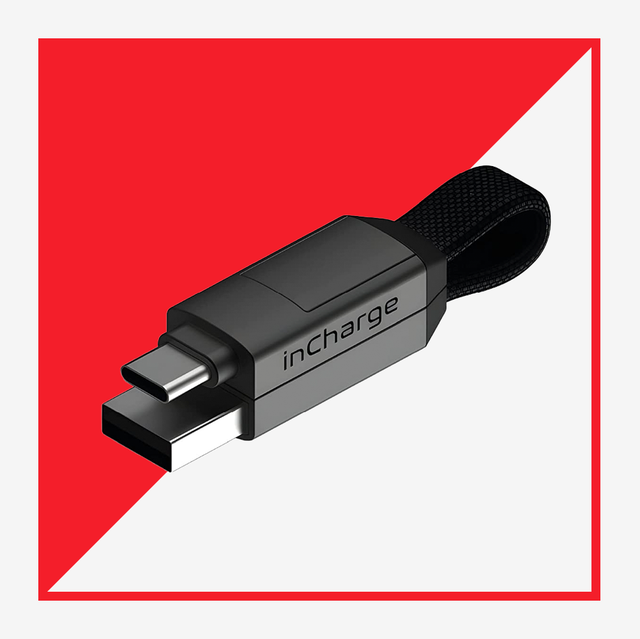
Our product picks are editor-tested, expert-approved. We may earn a commission through links on our site. Why Trust Us?

The Travel Gadget Everyone Should Get
Incharge 6-in-1 portable keychain charger cable.
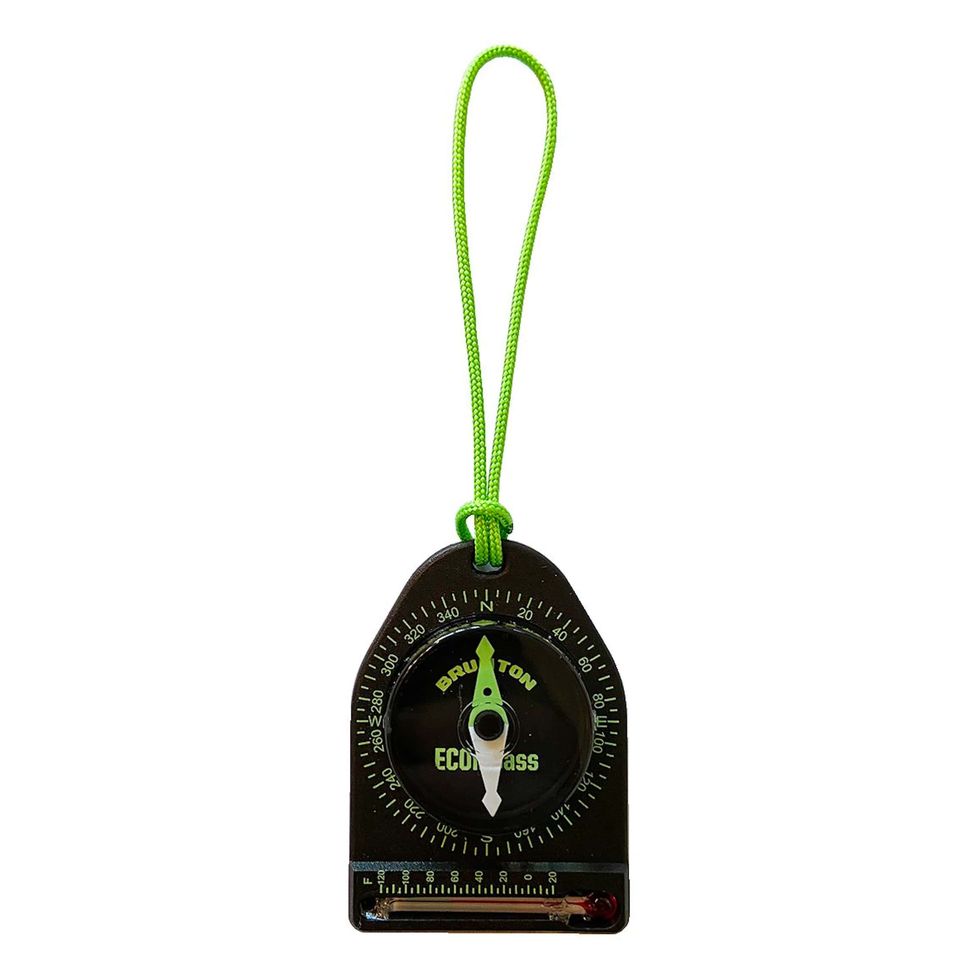
Best Old School Gadget
Brunton tag-along 9045 chill compass.
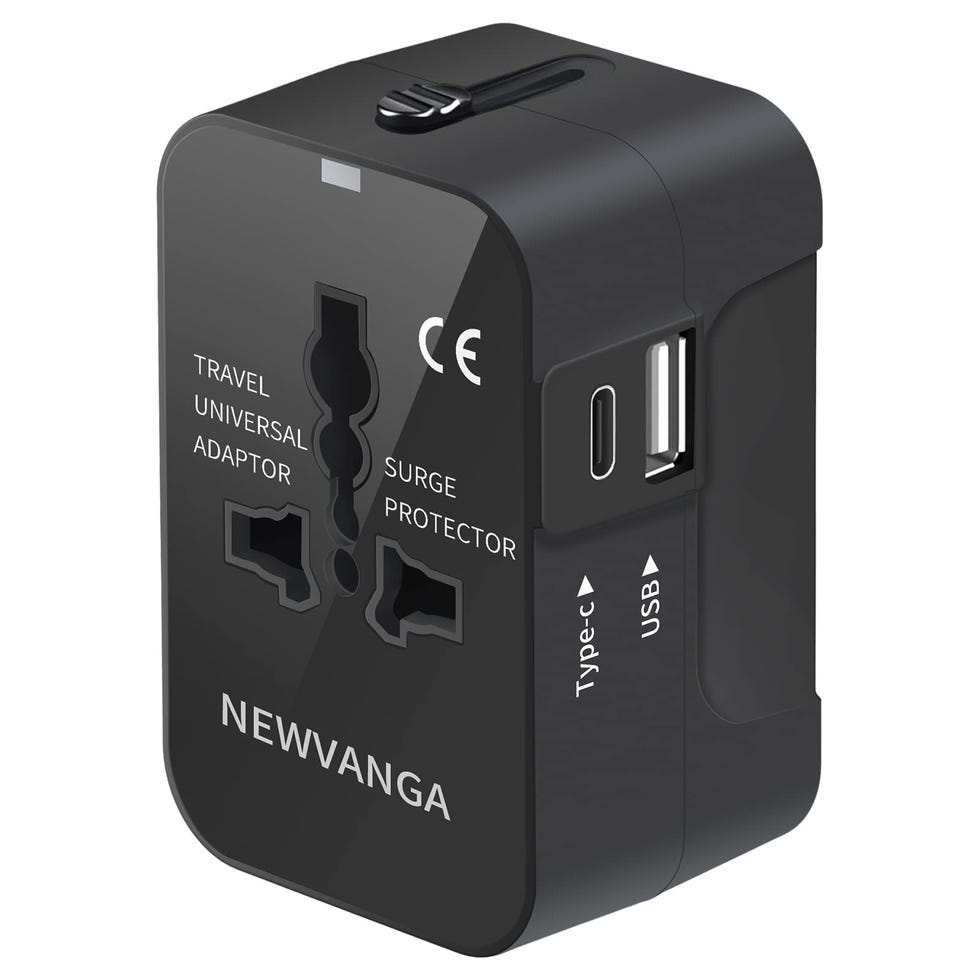
Best Travel Adapter
Newvanga universal travel adapter, all in one plug adapter with usb c.

Best Locking Carabiners
Gold lion gear aluminum carabiner with lock.

Best Portable Air Conditioner
Jisulife portable neck fan, hands free bladeless fan.

Best Door Lock Gadget
Winchy portable door lock home security door locker hotel.

Best Digital Notebook
Amazon kindle scribe (16 gb).

Best Sleep Headphones
Musicozy sleep headphones bluetooth 5.2 headband.

Best Watch Case for Traveling
Aukura 2 slot hard watch travel case.
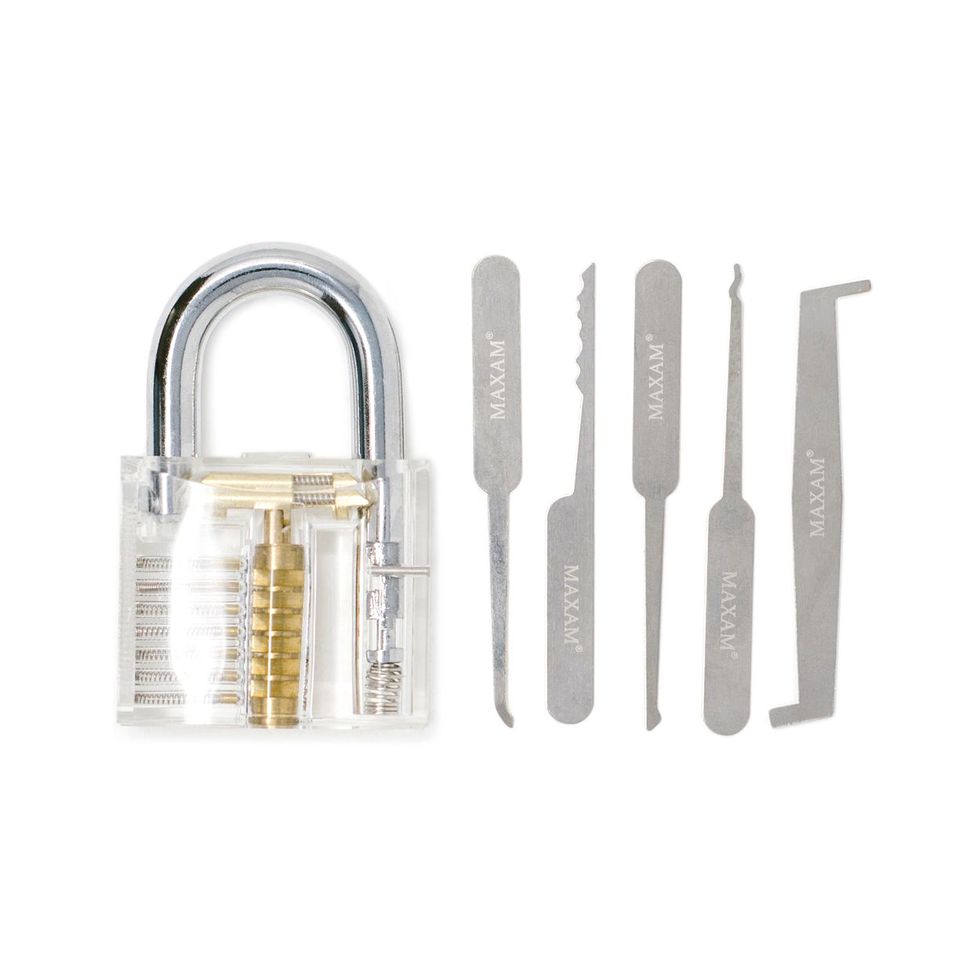
Most Unique Travel Gadget
Cool material lock pick training kit.
The best travel gadgets and electronics should highlight an inefficiency in your travel routine and help solve the problem. A travel gadget should provide high functionality, comfort (or both) while also being considerate of space. If your travel gadget does not have any of these qualities, then it's going to be hard to make a case they're worth bringing along for the ride.
Read more: Best Gadgets of 2023
Companies are constantly trying to come up with new gadgets to improve the travel experience, but the only way of knowing which ones actually work is by vetting them in person or conducting thorough research. Lucky for you, we took the time to bring together a list of worthy travel gadgets that could help improve your travel experience by leaps and bounds. Ahead, the very best travel gadgets and travel electronics, curated with all types of travelers in mind.
2024 Tech Awards | Best Duffel Bags | Best Carry-On Luggage | Best MagSafe Wallets | Best Macbook Accessories | Best Travel Bags | Best AirTag Wallets | Best Travel Pants | Best T-Shirts | Best Backpacks
Power is everything when traveling, and a lot of times our chargers can take up tons of space. The inCharge is the size of a small keychain and has six different charging input and output combinations to provide power to your phone, headphones, e-reader, smartwatch , and more. For quick reference, the inCharge has these specific ports: an input USB-C, an output USB-C, a USB-A, and an output lightning plus micro USB.
Never under estimate old-school instruments. This portable gadget comes with a compass and a thermometer to always let you know about your environment. It's super portable (barely 3 inches by 2 inches) and will tie on any bag for easy access. Oh, and it's also made with recycled materials.
There are a zillion travel adapters out there. Our favorite is this three-in-one device that operates as a an outlet adapter, USB-C adapter, and a surge protector.
A carabiner with a locking function is a great gadget for keeping your items together—and for helping decrease the chances of theft. This pack of five here is our go-to for locking carabiners. Keep one or two on your backpack or travel duffel at all times.
News flash: it's always summer in some part of the world. This portable AC fan is a lifesaver when traveling to warm climates. Throw this baby around your neck and enjoy three different gears of air flow directly to your head and neck.
Door locks aren't a necessary gadget when traveling, but they do pose value in giving travelers peace of mind. This compact one here is easy to store away. And when in use, all you have to do is place the end of it in your door latch, shut the door, and then fold out the sides and tighten the bolt down.
An e-reader is a no brainer for travels, but Kindle's new Scribe throws in the ability to operate as a digital notebook. You can annotate your favorite book paragraphs and then open up your free pages for some travel journalling.
A pair of sleep headphones can help give you that added push to get you into a deep slumber. Throw these on whenever you need to drown out any background noise during your travels.
Sometimes more than one watch is needed for a trip. This hard case will hold up to two watches and protect them when getting from point A to point B.
Read more: Best Watch Boxes
This lock pick kit is very James Bond-esque in the way that it prepares your for the unpredictable. Will you ever actually need to pop open a lock? Probably not. But wouldn't it be cool to use your travels as a time to learn an interesting skill? Absolutely.
Field Notes Expedition Edition 3-Pack
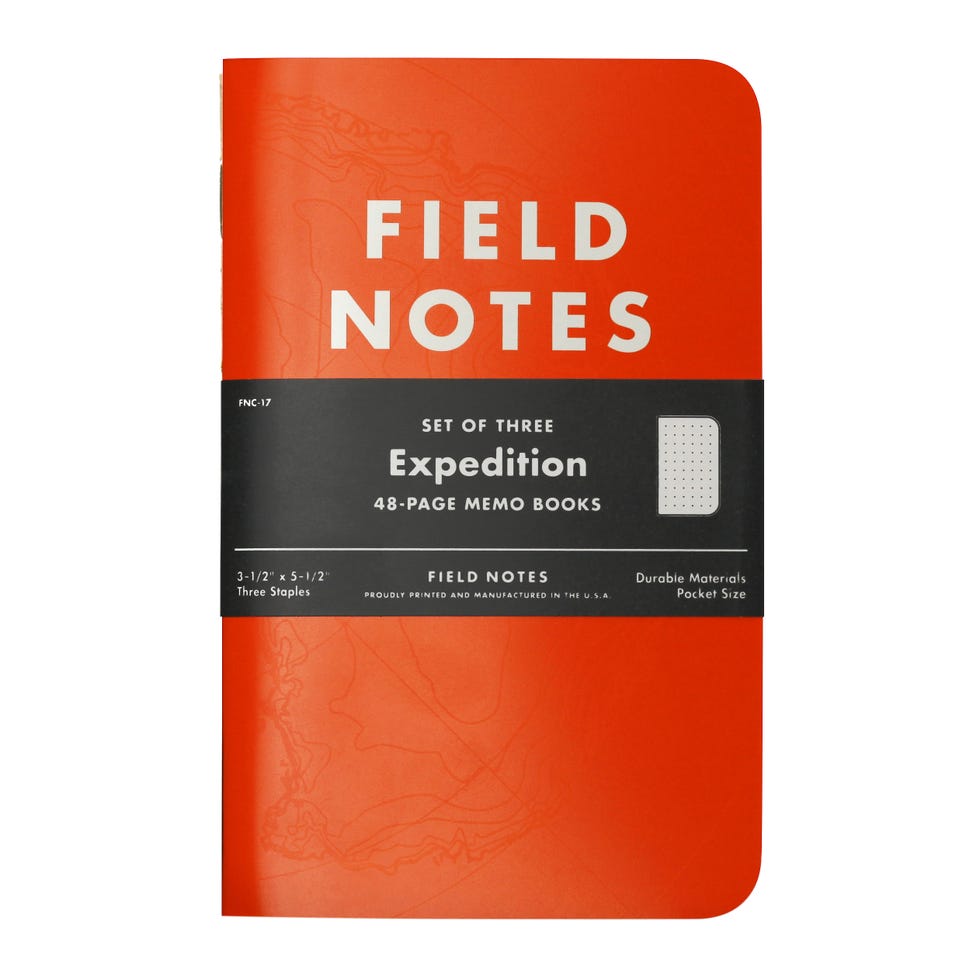
For the ol' fashioned travel writer, a pack of weatherproof notebooks is in store. This three-pack from Field Notes is printed with waterproof and tearproof Yupo synthetic paper, so you won't have to worry about a little rain ruining your travel log.
County Comm Titanium UGM Tritium Keychain Cage
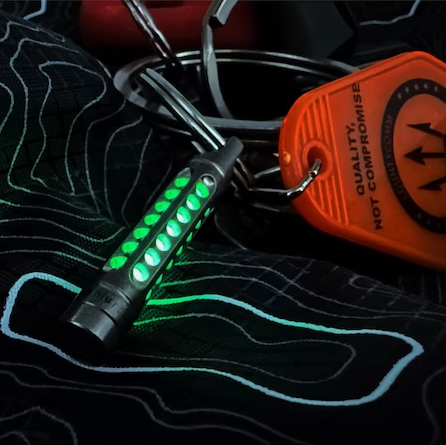
Ever heard of a tactical glowstick? Well you're looking at one. This keychain gadget is made of grade four titanium and comes tritium tubes that will glow up in the dark—thus, allowing you to spot your keys or other items easily at night.
Alpaka Gear Zip Pouch Pro
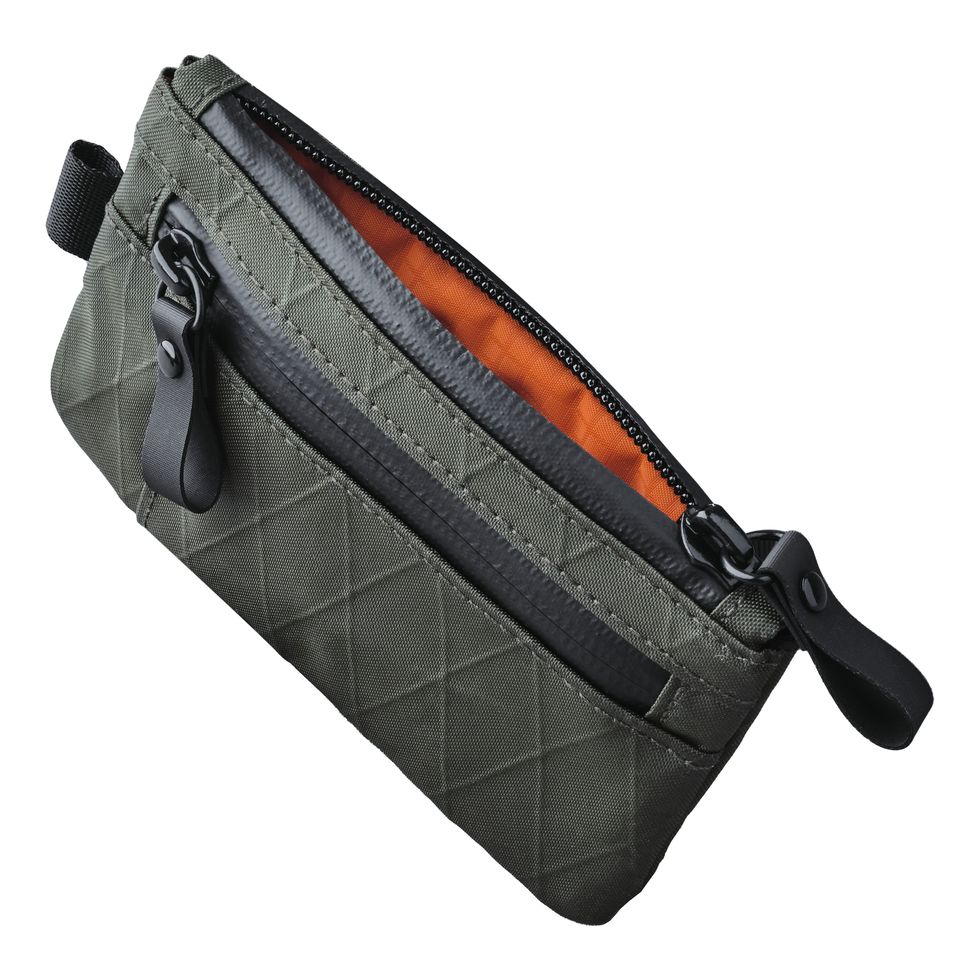
Compact, functional, and tough as nails, the Zip Pouch Pro is an easy side kick to turn to for travels. It's made from a strong and waterproof X-Pac material and features two zippered compartments and three external pockets for storage. Use it to hold cash, cards, keys multi-tools, pens, you name it.
Twelve South AirFly Pro

The AirFly allows your AirPods or headphones to be used to watch movies on your plane's in-flight entertainment center. We like the pro version of the AirFly, as it allows up to two people to connect to the same in-flight screen and watch at the same time. No more having to use the corded headphones that are passed out.
Groove Life Groove Belt
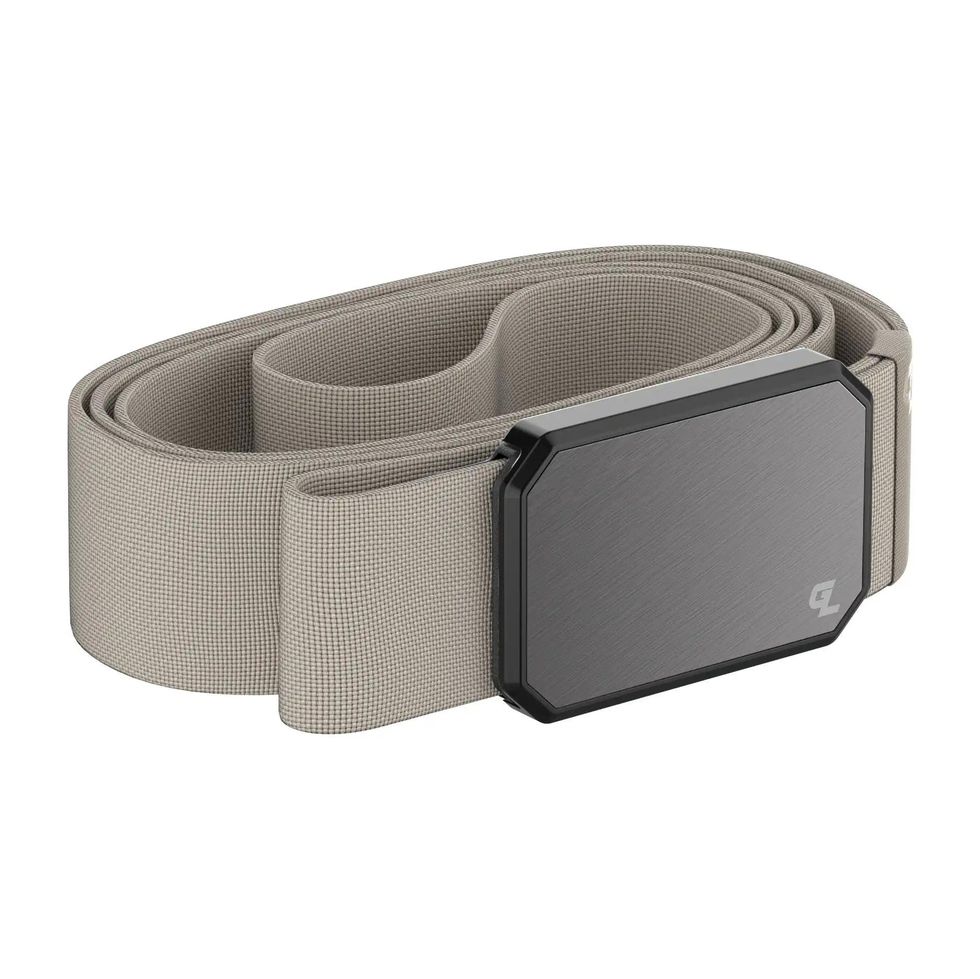
Making sure you look presentable while traveling is a subtle style move that will make you feel good and leave a positive impression on others. Ditch the pajamas and aim for a comfortable casual look. For keeping your pants in place, the Groove Belt is your best friend. It's wildly comfortable and simple to clip on and off, and it stretches enough to provide movement in all ranges of motion.
MATEIN Electronics Travel Organizer
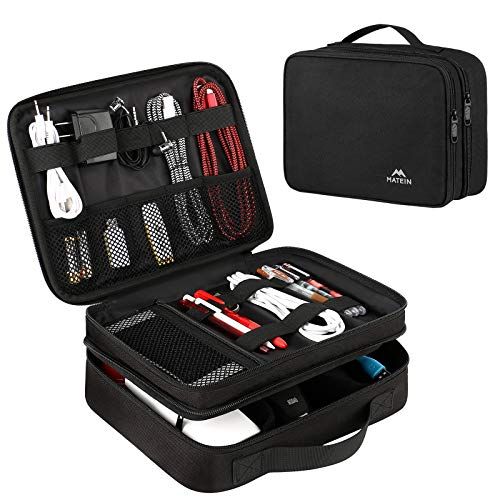
There are a zillion electronic organizers out there, and really you can't go wrong with most of them. Our favorite, however, is this simple water-resistant pouch from MATEIN that has over 5,000 five-star reviews on Amazon. It's got enough space to hold all your charging cords, as well as a space for small e-readers or small tablets. Best of all is the fact it's less than $25.
Read more: Best Travel Backpacks
INIU Portable Small Power Bank USB C in/Output
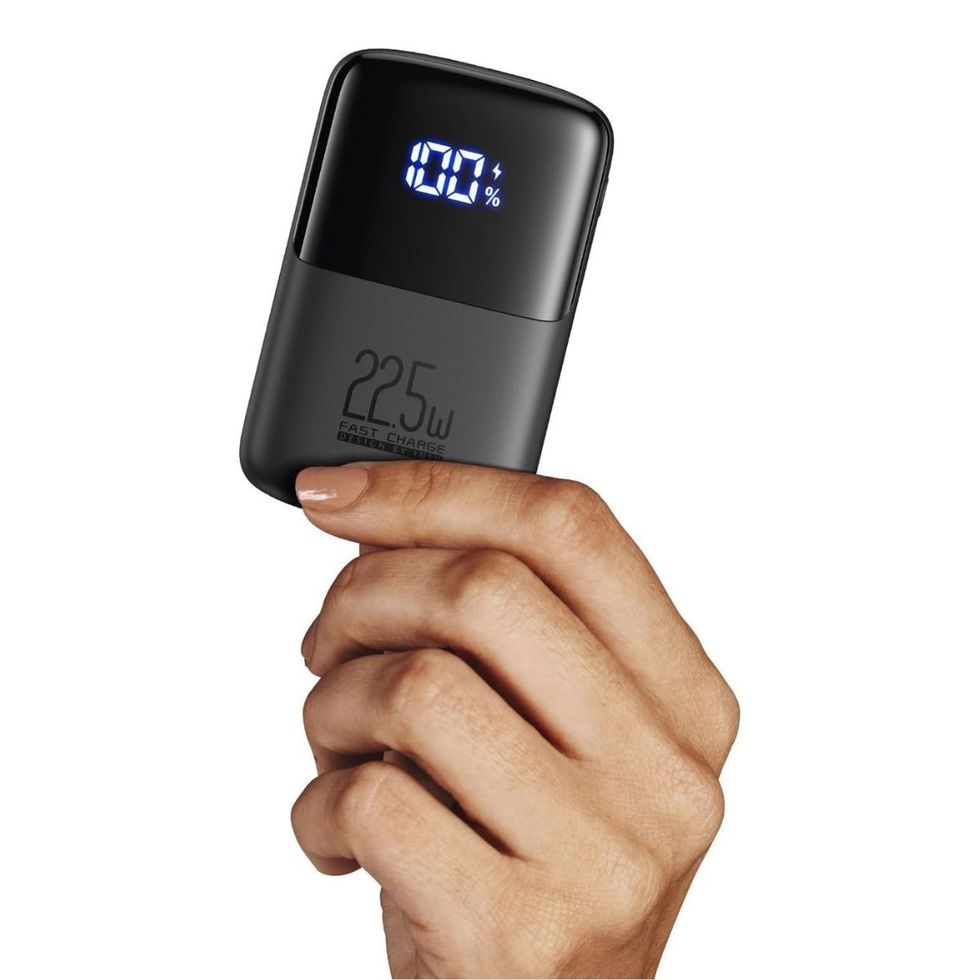
Portable chargers are a must for every traveler, but traveling with a clunker is no fun. This super-portable power bank packs enough juice for full charge to your phone (10000mAh) and will slip into a small pocket for easy storage.
Pluto POD Travel Pillow
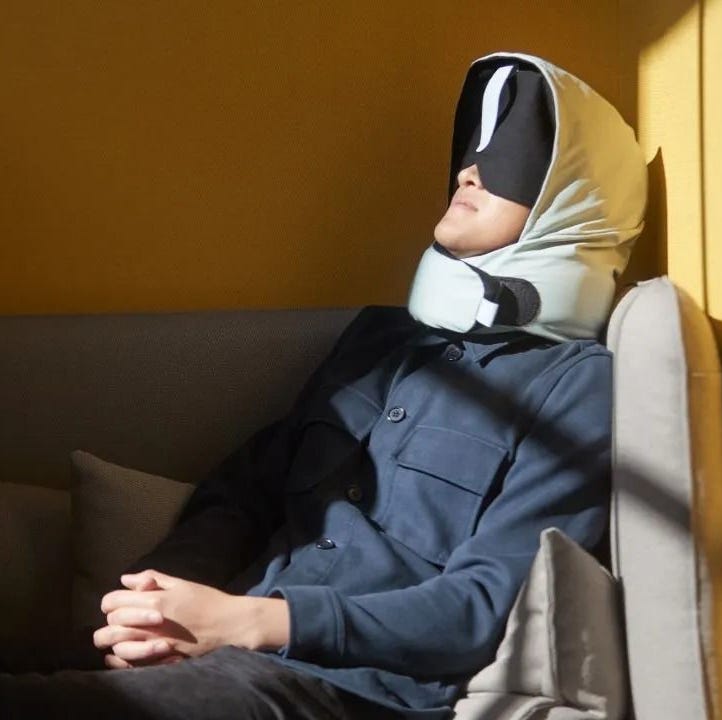
If you think all travel pillows are the same, think again. The Pluto POD acts almost like a sensory deprivation mask that works to block out sound and light with smart design notes like a slide-down eye mask and a deep hood. This travel pillow is perfect for promoting relaxation in the air and on the road.
LifeStraw Go 650 ml Water Filter Bottle - 22 fl. oz.
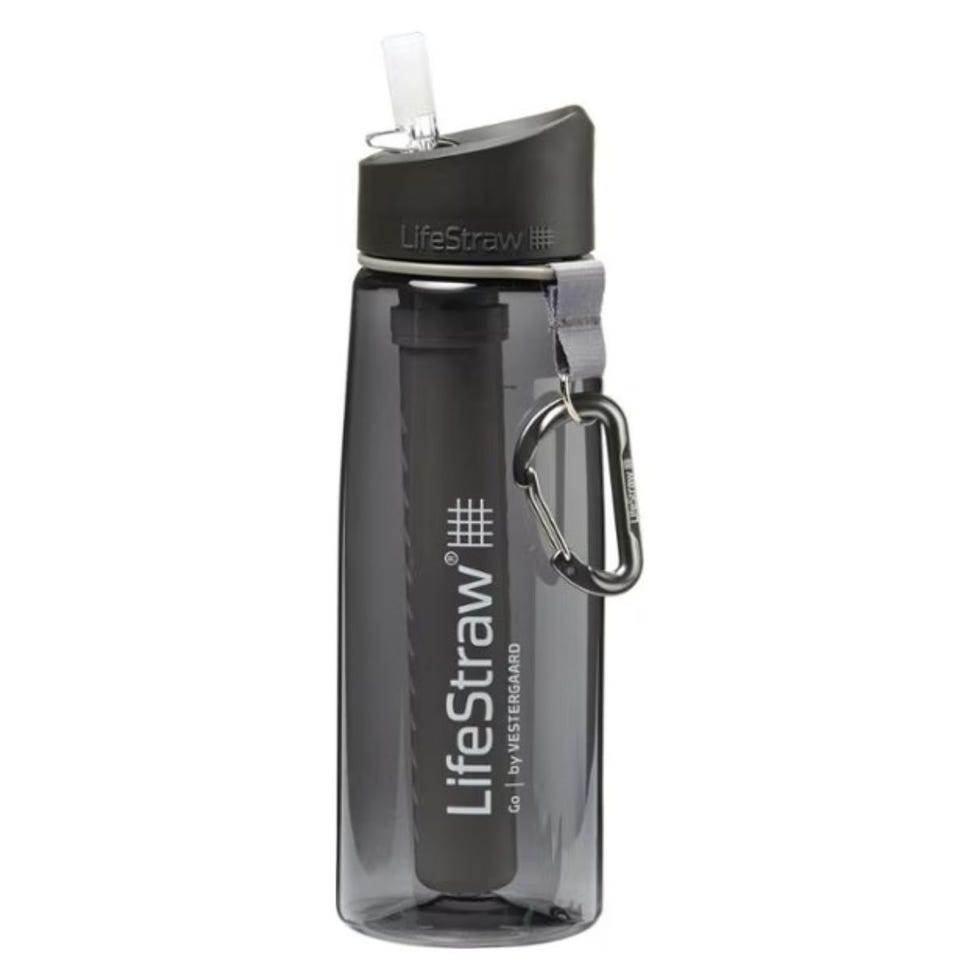
The LifeStraw Go is like any other refillable water bottle , except for the fact it's got a near-perfect filter built into, you guessed it, the straw. The LifeStraw can protect against a whopping 99.999999% of bacteria and 99.999% of parasites, making it a safe option for drinking water that comes from sinks and water foundations, and even some outdoor streams and rivers.
Kodak Luma 150 Ultra Mini Pocket Pico Projector
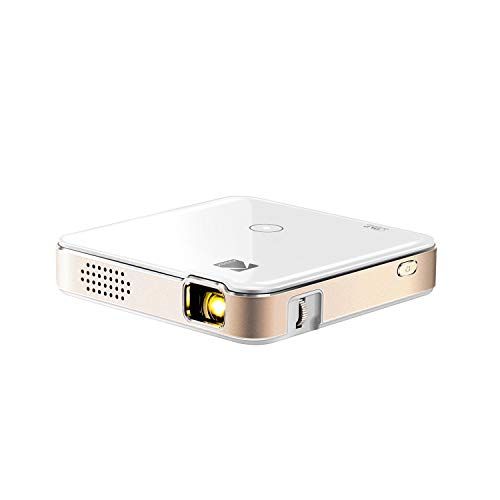
It's better to think of using this mini pocket projector at the hotel to watch your favorite shows or films, but in the rare chance you get stuck in a flight delay the projector can also be useful in helping entertain your kids. Regardless if you're a parent or not, this is an entertainment option that's fun for everyone.

.css-1fpt53b{height:1.25rem;}@media(max-width: 48rem){.css-1fpt53b{overflow:unset;line-height:1.25rem;}}@media(min-width: 48rem){.css-1fpt53b{line-height:1.25rem;}}.css-1fpt53b:before{background-color:#D2232E;color:#fff;margin-right:0.625rem;width:1.25rem;height:1.25rem;content:'';display:block;} Travel

12 Top Luggage Brands You Can Find on Amazon

The Perfect Luggage for Avoiding Airport Chaos
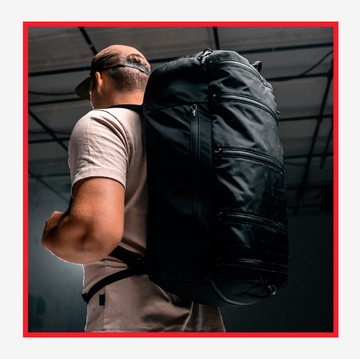
13 Best Carry-On Backpacks for Stress-Free Travel
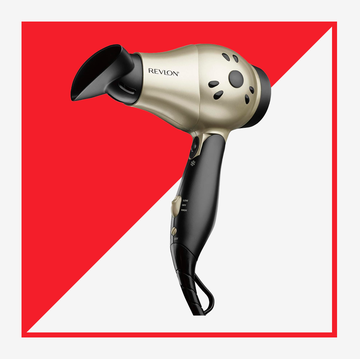
7 Travel Hair Dryers, Vetted by Grooming Editors

No One Was Prepared for the Diarrhea Plane
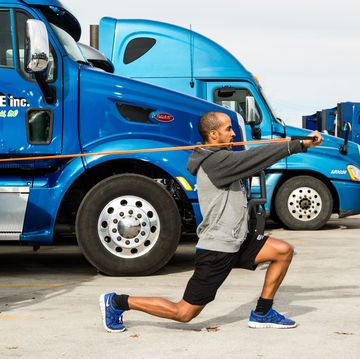
7 Rules of On-The-Road Fitness

You Need These TikTok-Famous Amazon Travel Hacks
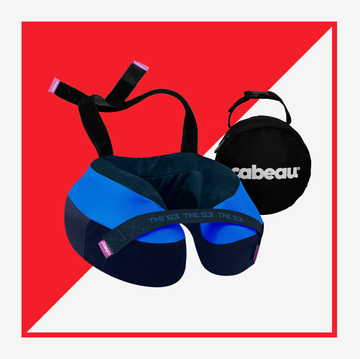
These Are The 10 Best Travel Pillows of 2024

Where to Work Out in Texas

The 12 Best Nude Beaches in the World

25 Transformative Trips Every Guy Should Take

Suggested Searches
- Climate Change
- Expedition 64
- Mars perseverance
- SpaceX Crew-2
- International Space Station
- View All Topics A-Z
Humans in Space
Earth & climate, the solar system, the universe, aeronautics, learning resources, news & events.

55 Years Ago: Star Trek Final Episode Airs, Relationship with NASA Endures

Space Station Research Advances NASA’s Plans to Explore the Moon, Mars

What’s Up: June 2024 Skywatching Tips from NASA
- Search All NASA Missions
- A to Z List of Missions
- Upcoming Launches and Landings
- Spaceships and Rockets
- Communicating with Missions
- James Webb Space Telescope
- Hubble Space Telescope
- Why Go to Space
- Commercial Space
- Destinations
- Living in Space
- Explore Earth Science
- Earth, Our Planet
- Earth Science in Action
- Earth Multimedia
- Earth Science Researchers
- Pluto & Dwarf Planets
- Asteroids, Comets & Meteors
- The Kuiper Belt
- The Oort Cloud
- Skywatching
- The Search for Life in the Universe
- Black Holes
- The Big Bang
- Dark Energy & Dark Matter
- Earth Science
- Planetary Science
- Astrophysics & Space Science
- The Sun & Heliophysics
- Biological & Physical Sciences
- Lunar Science
- Citizen Science
- Astromaterials
- Aeronautics Research
- Human Space Travel Research
- Science in the Air
- NASA Aircraft
- Flight Innovation
- Supersonic Flight
- Air Traffic Solutions
- Green Aviation Tech
- Drones & You
Technology Transfer & Spinoffs
- Space Travel Technology
- Technology Living in Space
- Manufacturing and Materials
- Science Instruments
- For Kids and Students
- For Educators
- For Colleges and Universities
- For Professionals
- Science for Everyone
- Requests for Exhibits, Artifacts, or Speakers
- STEM Engagement at NASA
- NASA's Impacts
- Centers and Facilities
- Directorates
- Organizations
- People of NASA
- Internships
- Our History
- Doing Business with NASA
- Get Involved
- Aeronáutica
- Ciencias Terrestres
- Sistema Solar
- All NASA News
- Video Series on NASA+
- Newsletters
Social Media
- Media Resources
- Upcoming Launches & Landings
- Virtual Events
- Sounds and Ringtones
- Interactives
- STEM Multimedia

Webb Finds Plethora of Carbon Molecules Around Young Star

NASA Scientists Take to the Seas to Study Air Quality

NASA to Change How It Points Hubble Space Telescope

NASA Astronauts Practice Next Giant Leap for Artemis

Former Astronaut David R. Scott

NASA Mission Flies Over Arctic to Study Sea Ice Melt Causes

Twin NASA Satellites Ready to Help Gauge Earth’s Energy Balance

Solid State Quantum Magnetometers—Seeking out water worlds from the quantum world

C.12 Planetary Instrument Concepts for the Advancement of Solar System Observations POC Change

B.10 Heliophysics Flight Opportunities Studies Correction
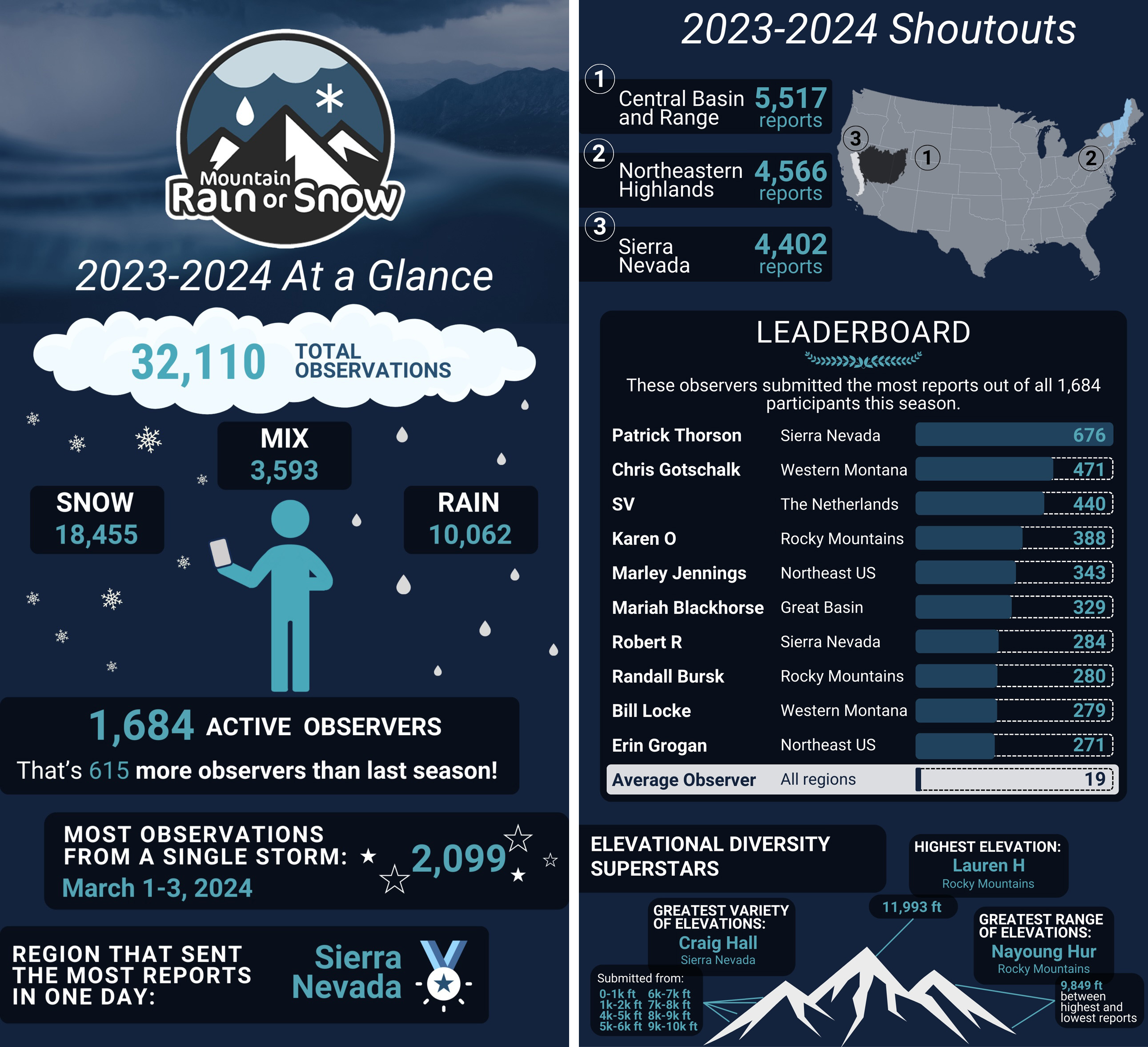
Mountain Rain or Snow Volunteers Broke Records This Winter

ARMD Solicitations

Winners Announced in Gateways to Blue Skies Aeronautics Competition

NASA, Industry to Start Designing More Sustainable Jet Engine Core

Tech Today: Measuring the Buzz, Hum, and Rattle

Artemis Generation Shines During NASA’s 2024 Lunabotics Challenge

Ames Science Directorate’s Stars of the Month, June 2024

Ted Michalek: Engineering from Apollo to Artemis
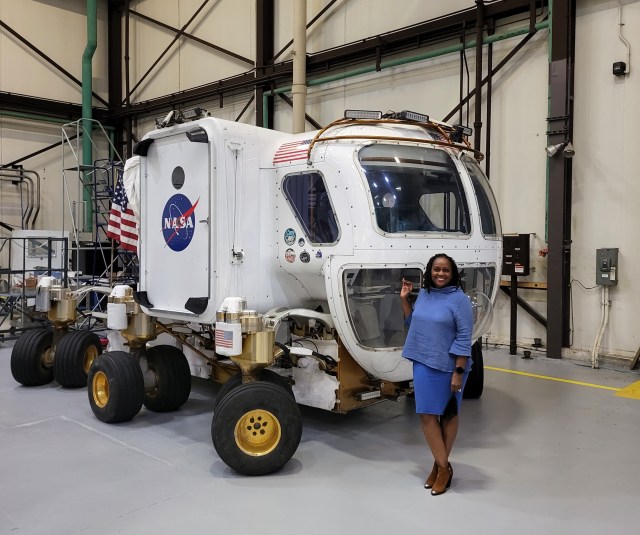
Aerospace Trailblazer: Shirley Holland-Hunt’s Visionary Leadership Transforms Space Exploration

Diez maneras en que los estudiantes pueden prepararse para ser astronautas

Astronauta de la NASA Marcos Berríos

Resultados científicos revolucionarios en la estación espacial de 2023
Space travel.
The path to the Moon, Mars, and beyond requires technologies to get us where we need to go quickly, safely and efficiently. Space travel includes launch and in-space propulsion systems, cryogenic fluid management, and thermal management, as well as navigation and landing systems to get our supplies, equipment, and robotic or human explorers to diverse surface destinations.
Quick Facts
NASA’s Space Launch System is 17 feet taller than the Statue of Liberty and produced 15% more thrust than the Saturn V at liftoff.
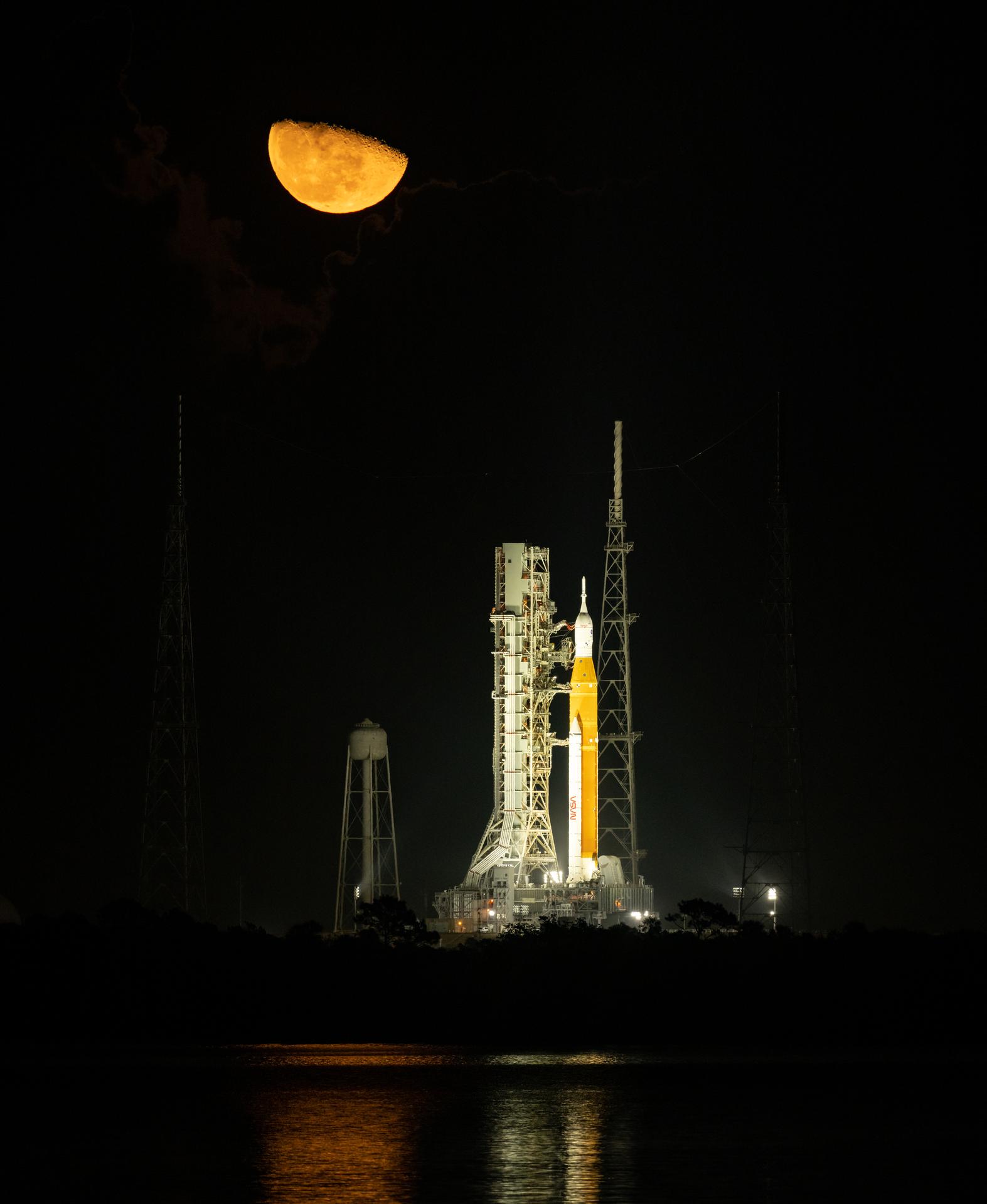
The last nuclear thermal rocket engine tests conducted by the United States occurred more than 50 years ago. NASA and DARPA are partnering on the Demonstration Rocket for Agile Cislunar Operations, or DRACO, program and together, we’ll develop and demonstrate advanced nuclear thermal propulsion technology as soon as 2027.
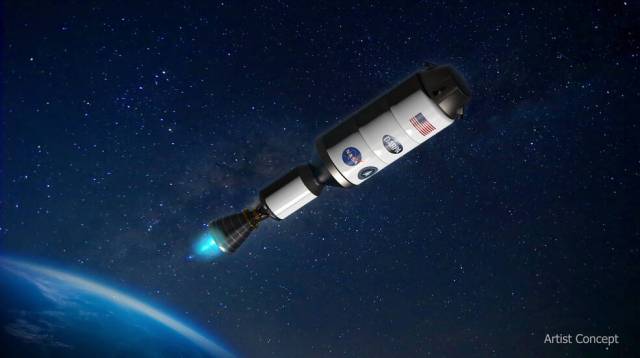
Mission and Impact
NASA seeks to improve our ability to access and travel through space; land more mass in more locations throughout the solar system; live and work in deep space and on planetary bodies; build next generation air vehicles, and transform the ability to observe the universe and answer profound questions in earth and space sciences.

Latest Space Travel News
NASA Announces Winners of Power to Explore Challenge

NASA’s SERT II: ‘A Genuine Space Success Story’

NASA Announces Semifinalists of Power to Explore Challenge

NASA Artemis Mission Progresses with SpaceX Starship Test Flight

How Do Spacecraft Slow Down? We Asked a NASA Technologist
How do spacecraft slow down? Rigid heat shields and retropropulsion have been the favorites of engineers for years. Now NASA is testing a new inflatable heat shield technology that could allow us to carry even larger payloads to worlds with atmospheres.
NASA Technology

Explore Technology Areas
Space Technology Mission Directorate

@NASA_Technology

@NASATechnology

NASA Space Tech Channel
We've detected unusual activity from your computer network
To continue, please click the box below to let us know you're not a robot.
Why did this happen?
Please make sure your browser supports JavaScript and cookies and that you are not blocking them from loading. For more information you can review our Terms of Service and Cookie Policy .
For inquiries related to this message please contact our support team and provide the reference ID below.
- Travel Ideas
- Ski & Snow
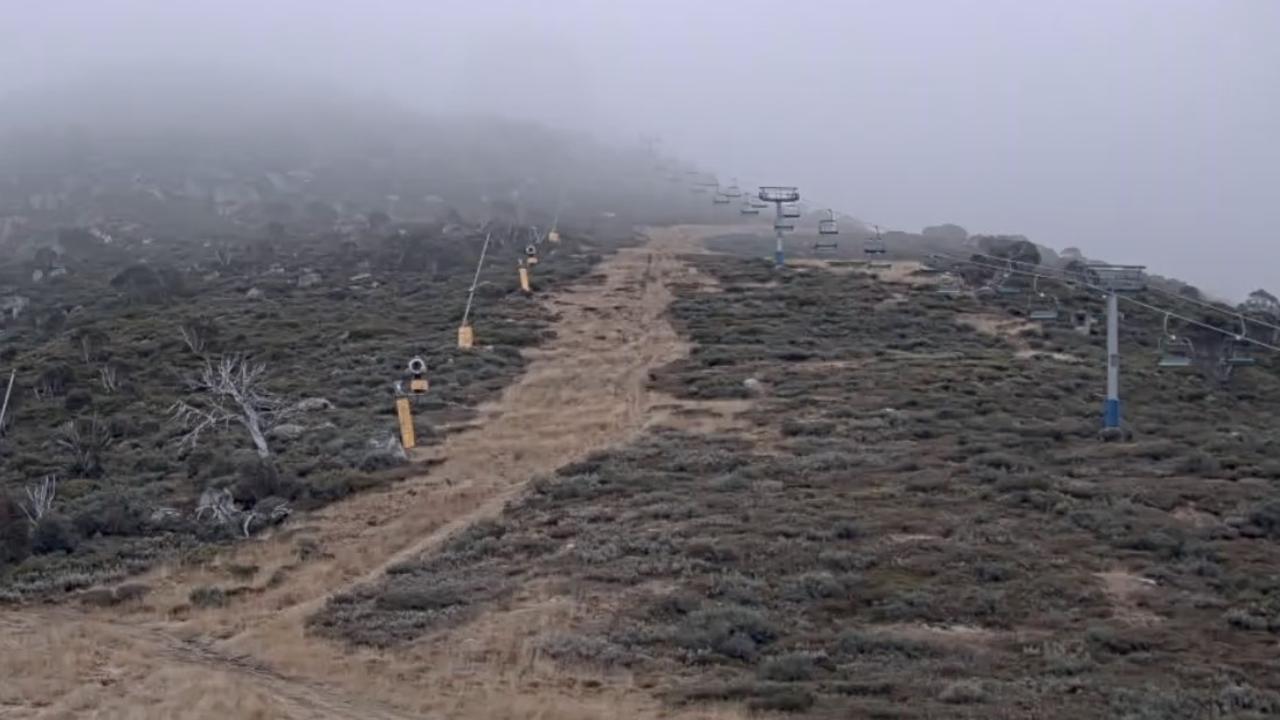
‘Cascading impacts’: Ski season, Murray-Darling smashed by climate change
Even if damage is reined in, one of Australia’s key tourism drivers faces a bleak future, new research finds.

Detail that totally transformed family trip

Resort eliminates most hated part of skiing
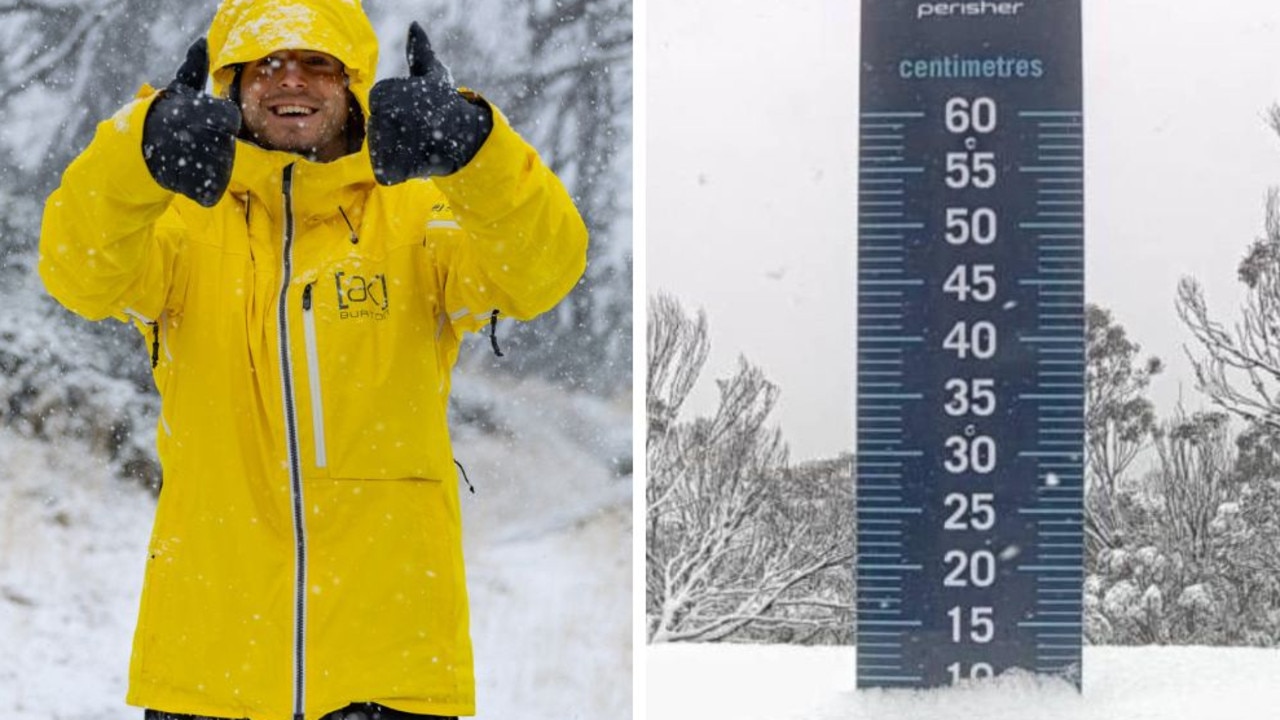
Epic pictures Aussie skiers need to see
The length of ski seasons will be slashed by one-third by 2030 even if greenhouse gas emissions are cut radically, new research has found.
According to the research by the Australian National University, New South Wales fields Charlotte Pass, Perisher and Thredbo, and Victoria’s Falls Creek and Mt Hotham fare better than others under the modelling.
But Ben Lomond, Lake Mountain and mounts Baw Baw, Buller, Selwyn and Stirling will be hit hardest, the research finds.
Broadly speaking, the roughly 100-day resort season length will decline by 16-18 days by the 2030s, regardless of emissions.

The Victorian alpine resorts was responsible for 10,000 full-time jobs and $1.2bn of economic activity in 2019. The latest NSW data is from 2011, but going on trends the NSW industry would have contributed about $2.1bn of activity in 2019.
In the 2050s, ski seasons will be 28 days shorted in a low-emissions scenario, and 55 days shorter in a high emissions scenario.
Come 2080, there might be one skiable day on the calendar if emissions remain high.

Further those skiable day projections only take into account the ‘critical’ altitudes at the resorts, and assume all resorts already have snow-making machines, which most do but not all.
Critical altitudes are: “The maximum season length that is possible with partial opening of the highest terrain, being the lowest point of the upper-half (if such an area exists), or the base station if not”.
Report co-author and ANU researcher Ruby Olsson said vulnerable resorts needed support to diversify into year-round tourism destinations.

“The more we can limit the impacts of climate change by reducing greenhouse gas emissions, the less expensive adaptation by businesses, communities, and the environment will be and the more options we will have,” Ms Olsson said.
Advocacy group Protect Our Winters Australia worked on the report with university and the Australian Mountain Research Facility.
Protect Our Winters Australia director Sam Quirke said 2023 snowfalls were inadequate.
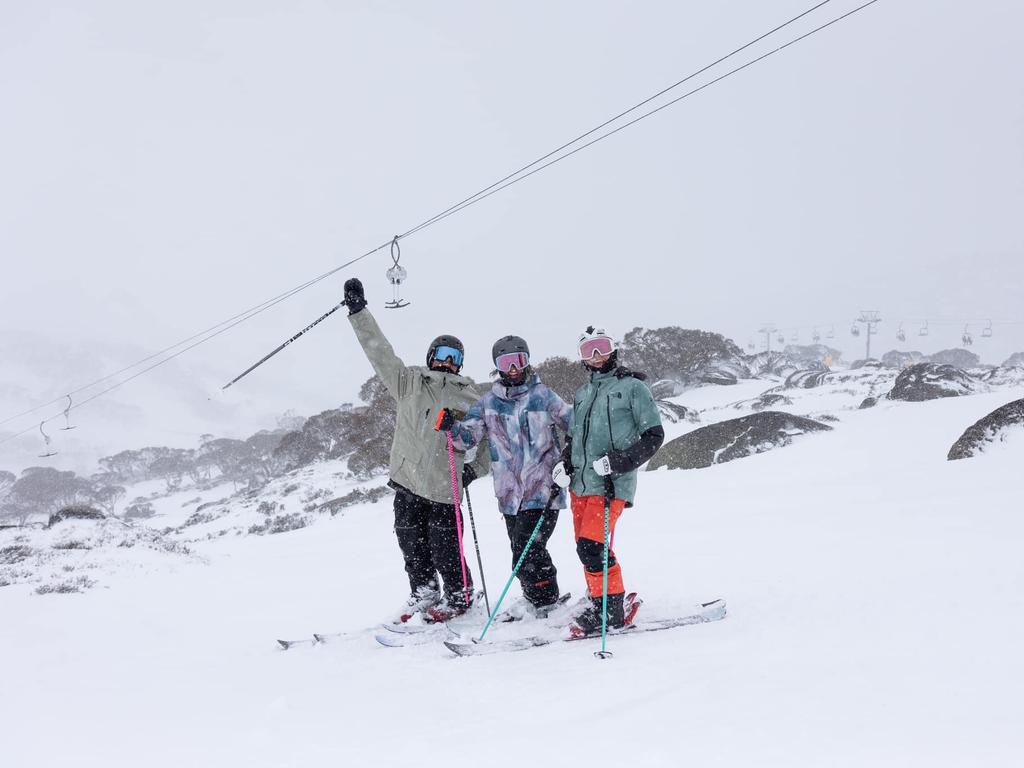
“The ski season last year was tough, with minimal snowfall and some resorts having to shut their doors early.
“This report shows that we’ll see that happening more and more frequently, as ski seasons become more erratic and harder to predict due to global warming, until we do something about it.”
Report co-author, Ms Olsson, is doing her PhD on the socio-economic impacts of snow gum dieback in the Australian Alps and possible response options.

Snow-melt water run-off provides an average of 9600 gigalitres of water each year into the Murray-Darling Basin, which is about 29 per cent of the basin’s total annual flow, the research founds. Climate change is forecast to slash precipitation in the Alps between five and 24 per cent come 2050.
“The report highlights a cascading series of interconnected impacts across alpine tourism, regional communities, hydro-electricity, high country water flows to the Murray-Darling Basin, carbon sequestration, high country ecosystems, and First Nations and makes recommendations to respond to these impacts,” the report reads.
Conflict on water allocations in the Murray-Darling Basin have been raging for years, so even less snow melt in the Alps would only exacerbate the situation.

More than 2.4 million people live in the Basin, and its rivers contribute to $30bn of economic activity.
The report recommends canopy cover, soils and wetland restorations in the Alps to abate the reduced precipitation.
Further, tourism and hydro-electricity expansion which damages the ecosystem should only be made with full consideration of impacts to the Basin.
A relaxing holiday with a child under five is a rare find – but this destination has managed to work out the magic formula.
There is an obvious reason this American ski resort is a favourite among the rich and famous – and it wants Aussies to visit next season.
It is two months out from Australia’s ski season and our biggest resorts are celebrating the first snowfall for the year.
MIT Technology Review
- Newsletters
Sam Altman says helpful agents are poised to become AI’s killer function
Open AI’s CEO says we won’t need new hardware or lots more training data to get there.
- James O'Donnell archive page

A number of moments from my brief sit-down with Sam Altman brought the OpenAI CEO’s worldview into clearer focus. The first was when he pointed to my iPhone SE (the one with the home button that’s mostly hated ) and said, “That’s the best iPhone.” More revealing, though, was the vision he sketched for how AI tools will become even more enmeshed in our daily lives than the smartphone.
“What you really want,” he told MIT Technology Review , “is just this thing that is off helping you.” Altman, who was visiting Cambridge for a series of events hosted by Harvard and the venture capital firm Xfund, described the killer app for AI as a “super-competent colleague that knows absolutely everything about my whole life, every email, every conversation I’ve ever had, but doesn’t feel like an extension.” It could tackle some tasks instantly, he said, and for more complex ones it could go off and make an attempt, but come back with questions for you if it needs to.
It’s a leap from OpenAI’s current offerings. Its leading applications, like DALL-E, Sora, and ChatGPT (which Altman referred to as “incredibly dumb” compared with what’s coming next), have wowed us with their ability to generate convincing text and surreal videos and images. But they mostly remain tools we use for isolated tasks, and they have limited capacity to learn about us from our conversations with them.
In the new paradigm, as Altman sees it, the AI will be capable of helping us outside the chat interface and taking real-world tasks off our plates.
Altman on AI hardware’s future
I asked Altman if we’ll need a new piece of hardware to get to this future. Though smartphones are extraordinarily capable, and their designers are already incorporating more AI-driven features, some entrepreneurs are betting that the AI of the future will require a device that’s more purpose built. Some of these devices are already beginning to appear in his orbit. There is the (widely panned) wearable AI Pin from Humane, for example (Altman is an investor in the company but has not exactly been a booster of the device). He is also rumored to be working with former Apple designer Jony Ive on some new type of hardware.
But Altman says there’s a chance we won’t necessarily need a device at all. “I don’t think it will require a new piece of hardware,” he told me, adding that the type of app envisioned could exist in the cloud. But he quickly added that even if this AI paradigm shift won’t require consumers buy a new hardware, “I think you’ll be happy to have [a new device].”
Though Altman says he thinks AI hardware devices are exciting, he also implied he might not be best suited to take on the challenge himself: “I’m very interested in consumer hardware for new technology. I’m an amateur who loves it, but this is so far from my expertise.”
On the hunt for training data
Upon hearing his vision for powerful AI-driven agents, I wondered how it would square with the industry’s current scarcity of training data. To build GPT-4 and other models, OpenAI has scoured internet archives, newspapers, and blogs for training data, since scaling laws have long shown that making models bigger also makes them better. But finding more data to train on is a growing problem. Much of the internet has already been slurped up, and access to private or copyrighted data is now mired in legal battles.
Altman is optimistic this won’t be a problem for much longer, though he didn’t articulate the specifics.
“I believe, but I’m not certain, that we’re going to figure out a way out of this thing of you always just need more and more training data,” he says. “Humans are existence proof that there is some other way to [train intelligence]. And I hope we find it.”
On who will be poised to create AGI
OpenAI’s central vision has long revolved around the pursuit of artificial general intelligence (AGI), or an AI that can reason as well as or better than humans. Its stated mission is to ensure such a technology “benefits all of humanity.” It is far from the only company pursuing AGI, however. So in the race for AGI, what are the most important tools? I asked Altman if he thought the entity that marshals the largest amount of chips and computing power will ultimately be the winner.
Altman suspects there will be “several different versions [of AGI] that are better and worse at different things,” he says. “You’ll have to be over some compute threshold, I would guess. But even then I wouldn’t say I’m certain.”
On when we’ll see GPT-5
Artificial intelligence, what i learned from the un’s “ai for good” summit.
OpenAI’s CEO Sam Altman was the star speaker of the summit.
- Melissa Heikkilä archive page
An AI startup made a hyperrealistic deepfake of me that’s so good it’s scary
Synthesia's new technology is impressive but raises big questions about a world where we increasingly can’t tell what’s real.
Is robotics about to have its own ChatGPT moment?
Researchers are using generative AI and other techniques to teach robots new skills—including tasks they could perform in homes.
Generative AI can turn your most precious memories into photos that never existed
The Synthetic Memories project is helping families around the world reclaim a past that was never caught on camera.
- Will Douglas Heaven archive page
Stay connected
Get the latest updates from mit technology review.
Discover special offers, top stories, upcoming events, and more.
Thank you for submitting your email!
It looks like something went wrong.
We’re having trouble saving your preferences. Try refreshing this page and updating them one more time. If you continue to get this message, reach out to us at [email protected] with a list of newsletters you’d like to receive.
- Share full article
Advertisement
Supported by
A Girls’ Trip to Costa Rica. But With No Phones, Did It Happen?
Travelers are signing up for phone-free tours, to try to escape technology’s tether on daily life. But would it make for a better experience?

By Christine Chung
We were on a quintessential girl’s trip to Costa Rica. Together, we gulped icy drinks by the hotel pool, were battered by waves during a surf lesson, had our tarot cards read aboard a catamaran, and danced our hearts out, powered by espresso martinis, to early 2000s anthems on a rooftop.
But we didn’t capture any of this on our phones. No Instagram stories were posted of the fun being had. No TikToks either. We didn’t text photos to friends and family in far colder climates back home.
And if there wasn’t a picture, well, did it happen? I had wondered if a vacation without my phone would reprogram my iPhone-addled brain, whether it might deepen the connections I made or improve my travel experiences. So, in mid-April, I joined a group of 10 other women in their 20s and 30s for a four-day, phone-free tour of Costa Rica’s Guanacaste Province, on the country’s northwestern coast, a picturesque place of breathtaking beaches, tropical forests and, everywhere around you, the chance of a surreal wildlife sighting.
To document my vacation, I brought only a pen, a notebook and a disposable camera.
‘More present in the moment’
FTLO Travel , which started offering group tours in 2016 for solo travelers 25 to 39 years old, organized our phone-free trip. Most FTLO clients are women, said Tara Cappel, the company’s founder and chief executive, and the majority of them are traveling solo for the first time.
The company has long had a rule prohibiting phones at dinner, she said, and the phone-free trips, which began this year, are an extension of this. “Removing that sort of temptation has always helped facilitate better bonding and conversation,” said Ms. Cappel, 35.
The hope in providing an entirely phone-free experience, she continued, is that travelers could “be present in the experience and the destination and with each other.”
She added that FTLO’s phone-free trips this year, which start at $1,699 and also head to Iceland, Mexico, Cuba and Puerto Rico, are in strong demand . My Costa Rica trip was sold out and overall, the company anticipates about 3,000 travelers across the hundreds of trips they’re offering this year.
The interest in these trips stem in part from a growing trend among travelers to try to escape technology’s tether on daily life. Operators are moving beyond offering meditation retreats and truly remote locations — even cruises and hotels in buzzy vacation hot spots these days market their disconnection experiences. At the Grand Velas Resorts , on Mexico’s Riviera Maya, guests can opt for a detox concierge, who will remove the hotel room’s flat screen television and lock all personal electronics in a safe. With Unplugged , a company specializing in tech-free escapes, you can book a “digital detox cabin” to spend three tech-free days in the English countryside.
Heather Orton, a nurse practitioner and my roommate in Costa Rica, said that going phone-free was the main reason she’d booked the FTLO trip. She’d previously gone on two trips with FTLO, to Crete and to Morocco, experiences where she made lasting friendships.
“At work I have to always have my phone on, be responsive to texts, emails and calls,” said Ms. Orton, 37, of Ohio. “It’s nice to turn that off and get away.” She said she felt she was “more present in the moment” and fully immersed in Costa Rica.
A bit like sleepaway camp
We’d come from all over the United States, including Texas, Alabama, California and Minnesota, and most of us were meeting for the very first time.
It felt like sleepaway camp, or college orientation — it was a social situation structured around group activities that quickly gave rise to new friendships, even if they were brittle ones. Two ebullient trip leaders corralled us to various activities and recited facts about local flora and fauna, all adding to the feeling of a camp for adults, and at times like being chaperoned on a school trip.
They directed us to their favorite restaurants and watering holes, and attempted to draw everyone into conversation and ensure no one felt left out. One afternoon, Mandy, one of the co-leaders and a certified yoga instructor, led a trio of us in a restorative flow at our hotel. Dani, the other trip leader, who was born in Costa Rica, was on crutches because of a recent ankle injury, but he hobbled along energetically on nights out, swaying to dance music on one leg.
Companies targeting younger travelers, like FTLO, G Adventures , Flashpack and others, aren’t touting their ability to get you to a place, but the connection they can deliver.
“The inspiration was really to help people go abroad who had the desire but didn’t necessarily have people to go with,” Ms. Cappel said of creating FTLO.
Sambavi Venkatesen, a 32-year-old therapist who lives in Austin, Texas, told me she had booked the trip after turning to TikTok to research group travel for people of color.
“The opportunity to meet other diverse women is not something that’s easily accessible in your 30s. That was kind of a big appeal,” she said, adding that she felt a real connection to other tour participants by trip's end. “I genuinely want to see people again and hope they visit me.”
Unscheduled time
We were based in Tamarindo, a lively tourist playground set along the Pacific Ocean that spanned just a few blocks, making it easy to navigate without GPS. We were given a printed map of the town, which I barely used. With my phone and laptop locked in the hotel room safe, gone were all the tools I usually rely on while traveling (and check frenetically): map and translation apps, social media and internet, for restaurant and activity searches. But thanks to the tour, this work had already been done.
We spent an afternoon ziplining through canyons and then crossed a rickety suspension bridge to plunge into the icy, refreshing waters by a waterfall. We surfed and drank beer — two activities I do not generally voluntarily sign up for. We lounged on the netted deck of a catamaran, where we watched a deep-red sun sink into the sea. Nearly every night we frequented a different nightclub.
We started the trip knowing nothing about each other’s lives, from our ages to interests. Our first night was characterized by icebreakers (“share a fun fact about yourself”) and the occasional awkward silence. But by the third night, we were screaming the lyrics to Lil Jon’s “Get Low” in the club. And the conversation grew more nuanced, as we shared stories about jobs, relationships, beloved pets and the rhythms of lives back home.
Some of the best moments happened during the time left unscheduled, when I made my own decisions about activities. A highlight of the trip was an excursion my roommate and I booked on our own, through the hotel, to kayak in a mangrove-bordered estuary, where we spotted iguanas, howler monkeys and a crocodile, watchful and still in the murky waters.
A fuzzy food photo
Overall, I didn’t miss my phone. The absence of Slack notifications and countless other digital intrusions was bliss. Conversations unspooled more fluidly than I expected they would without the crutch of a phone for idly filling silence. I slept deeper than I had in months. But my phone’s phantom presence loomed large. I swiveled my head, a Pavlovian response, when I heard the ping of another tourist's phone. My bag felt too light, which made me feel uneasy.
Mainly, I missed a good camera. Others had wisely brought digital cameras along, but I had to ration the pictures on my disposable camera, and only allowed myself to take one food photo. It’s fuzzy.
Not everyone on the trip was fully committed to the screen time ban. One night, as I tried to capture sunset using my disposable, one of my trip mates pulled out her phone and took a picture. I’m sure her photo is better than mine.
Toward the end of the trip, I learned that some other travelers had surreptitiously used their phones throughout (to text and call their moms, mostly).
But we delighted in seeing a drowsy tapir, a large mammal almost mythical because of its rarity, wake from an afternoon nap in Hacienda Guachipelin , a private property by Rincon de la Vieja National Park . There were also dozens of howler monkeys perched atop mangroves swaying in the wind, and one night, a man who was absolutely shredding on the guitar at a beachfront bar. All were incredible moments that I’ve already revisited in my memory.
On the last day of the trip, we switched our phones back on, literally jolting us back to real life with pings and vibrations. We shared Instagram handles to connect online, and I returned, almost without realizing it, to a stream of information, push notifications, digital itineraries, unfettered scrolling and the expectation of a quick reply to a message.
I’ve tried, however, to maintain the feeling of being phone-free in Tamarindo: the delicious lack of immediacy, the way time seemed to expand languidly.
Simply put, I’m using my phone less.
Follow New York Times Travel on Instagram and sign up for our weekly Travel Dispatch newsletter to get expert tips on traveling smarter and inspiration for your next vacation. Dreaming up a future getaway or just armchair traveling? Check out our 52 Places to Go in 2024 .
Christine Chung is a Times reporter covering airlines and consumer travel. More about Christine Chung
Open Up Your World
Considering a trip, or just some armchair traveling here are some ideas..
52 Places: Why do we travel? For food, culture, adventure, natural beauty? Our 2024 list has all those elements, and more .
The Alaska Highway: On an epic road trip, a family plots a course from Alaska to the Lower 48, passing through some of Canada’s most spectacular scenery .
Minorca: Spend 36 hours on this slow-paced Spanish island , which offers a quieter and wilder retreat than its more touristy neighbors.
Japan: A new high-speed train stop unlocks Kaga, a destination for hot springs, nourishing food and traditional crafts , as an easy-to-reach getaway from Tokyo.
London: The Victoria and Albert Museum is a treasure trove of art and design. Here’s one besotted visitor’s plan for taking it all in .
More From Forbes
Father’s day gift guide 2024: the best travel gifts for new dads.
- Share to Facebook
- Share to Twitter
- Share to Linkedin
Traveling with little ones can be a day at the beach, thanks to these thoughtful gifts.
Just because he’s become a dad doesn’t mean your favorite traveler has to also become a homebody. Sure, it can be tougher to get around with a little person pretty much attached to him but it can be done more enjoyably than he might think.
We’ve found a variety of gifts that make travel so much easier with babies and toddlers that he won’t want to go anywhere without them – both the gifts and the kids – ever again.
Doona Liki Trike S5
He already loves and trusts Doona because of their must-have all-in-one car seat & stroller travel system so he will be thrilled to see that they’ve created the world’s most compact folding trike. Designed for children 10 months to 3 years old, it transforms into five different modes so parents can push little ones in it and leave older kids to ride on their own. So much more fun than a stroller, it will get him and his mini me through the airport without tears. It then folds up easily to toss in an overhead bin. Price: $300
Graco Turn2Me 3-in-1 Car Seat
Getting little ones in and out of car seats can be challenging but Graco has changed the game with a rotating feature that will make Dad’s life so much easier, especially if he’s planning to make frequent stops on a road trip. Of course, safety comes first and this seat protects kids on all sides and can be used rear or forward facing or as a booster. It also has a headrest that adjusts to 10 different positions to keep children safe and comfortable as they grow. Price: $349
7 AM K-Poncho
One of the best inventions ever, this baby carrier cover is perfect for dads headed to coolcation destinations. With its water repellent outer shell and plush lining, it keeps babies cozy, whether they’re facing Dad or the world. It even has hand slits so he can hold on to them. The cover also adapts to all strollers and car seats, making it indispensable at home or away. Price: $100
As Russia s Armored Vehicles Get Worse Ukraine s American Made M 2s Destroy Them Faster
Microsoft issues new warning for 70% of all windows users, google slashes pixel 8 pro price in a major new promotion.
Dagne Dover Indi Neoprene Diaper Backpack
A diaper bag is a new parent essential but Dad is probably more interested in practicality than cuteness. Luckily, this one has both in spades so anyone will feel good about carrying it around, even on the most luxury vacation — especially in sophisticated black. It easily clips onto a stroller and features lots of pockets, pouches and even a mini changing pad. Plus, it features a dedicated safe space for his laptop so he can get some work done while baby sleeps. Price: $215
Regalo Play Mat with Travel Case
Whether they’re waiting for a flight or spending the night in a hotel, this cushy foam mat gives Dad a clean, safe place to put little ones down. It’s even waterproof so he can use it outdoors and clean it right up afterwards. Older kids will get a kick out of the design, with its roads and parks, and will enjoy playing with their own toy cars and trucks on it. Babies will just find it soft and comfortable and dads will be glad they can give their arms a rest. Price: $49.99
Magnetic Me Lake You A Lot Grow With Me Convertible Coverall
Having to change a baby on a plane or at a rest stop is way easier with one of these adorable, magnetized rompers. Made of super soft, breathable and temperature regulating Tencel modal, it features a magnetic closure, which means no snaps and zippers that can take forever to do properly. It also has foldover cuffs to keep little hands and feet cozy on over-air conditioned flights. You can choose from dozens of cute prints but this one is perfect for spending long weekends at the lake. Price: $40
KeaBabies Baby Car Seat Mirror
Rear facing car seats are safest for babies but, if Dad is driving alone with his little one, it can be disconcerting not to be able to see what’s going on back there. This shatterproof mirror is a game-changer, letting him keep his mind on the road while keeping an eye on his precious cargo. Price $19.96
Looky Lou Bundle
Vacations offer lots of cute photo ops but, let’s face it, babies are not always the most cooperative subjects. Thanks to the innovative Looky Lou, all Dad has to do is clip this cute little rattle to his phone and suddenly everyone’s looking in the right direction and smiling. The bundle comes with a board book introducing little ones to Lou the lion so they’ll be especially happy to see him whenever Dad feels like capturing the moment. Price: $29
Keep Going First Aid Kit Bundle
Because kids are unpredictable and accidents happen, give Dad some peace of mind with this trio of different sized first aid kits to prepare him for anything. He can keep one in the car, toss one in the diaper bag, pack one in the luggage. Well organized and easy to access, the kits include everything from bandages and ointments to nosebleed plugs, tick removers and burn gels. Hopefully he’ll never have to use it but, if he does, it will absolutely be the gift he’s most thankful for. Price: $124.97
- Editorial Standards
- Reprints & Permissions
Join The Conversation
One Community. Many Voices. Create a free account to share your thoughts.
Forbes Community Guidelines
Our community is about connecting people through open and thoughtful conversations. We want our readers to share their views and exchange ideas and facts in a safe space.
In order to do so, please follow the posting rules in our site's Terms of Service. We've summarized some of those key rules below. Simply put, keep it civil.
Your post will be rejected if we notice that it seems to contain:
- False or intentionally out-of-context or misleading information
- Insults, profanity, incoherent, obscene or inflammatory language or threats of any kind
- Attacks on the identity of other commenters or the article's author
- Content that otherwise violates our site's terms.
User accounts will be blocked if we notice or believe that users are engaged in:
- Continuous attempts to re-post comments that have been previously moderated/rejected
- Racist, sexist, homophobic or other discriminatory comments
- Attempts or tactics that put the site security at risk
- Actions that otherwise violate our site's terms.
So, how can you be a power user?
- Stay on topic and share your insights
- Feel free to be clear and thoughtful to get your point across
- ‘Like’ or ‘Dislike’ to show your point of view.
- Protect your community.
- Use the report tool to alert us when someone breaks the rules.
Thanks for reading our community guidelines. Please read the full list of posting rules found in our site's Terms of Service.

IMAGES
VIDEO
COMMENTS
Based on the Travel Innovation Map, the Tree Map below illustrates the impact of the Top 9 Travel Industry Trends in 2024. Startups and scaleups are enabling contactless travel using technologies like biometrics, radio-frequency identification (RFID), and near-field communication (NFC). This is due to increasing health and hygiene concerns post ...
The latest technology trends in the travel and tourism industry for 2024. The hottest tips & travel tech trends, and innovate your business.
Motional. Net-zero flights: Thanks to a mix of emerging technologies, "net-zero" flights are are now in the realm of possibilities. US-based Eviation Aircraft is leading the way, providing a peek ...
As we move into 2023, here are the four major travel tech trends that we believe will revolutionize the industry. Jonathan Abraham. ( Joyend) Smart hotels and rooms. Smart hotels and rooms have incorporated voice-activated assistants, smart mirrors, and automated lighting, temperature controls and activating entertainment from the guests ...
Here are some of the top travel tech trends we expect to see in 2023. 1. Airports getting a tech upgrade. Expect to see a whole lot more technology designed to make airport travel easier. From ...
The share of digital ad spending in the travel and leisure industry will reach 14.5 percent in the United States and 13.9 percent in the United Kingdom in 2024. The world's leading online travel agencies (OTAs) will spend $2.3 billion on Google advertising in 2024. The global travel and tourism market will shift from 66 percent offline sales ...
UV-C cleaning. Hospitals have used UV-C light to disinfect and kill viruses for more than two decades. Now, indoor public spaces including airports, gyms, and movie theaters are adding UV-C to ...
PO Box 760, Sherman, CT 06784 USA | Telephone: +1 201 902-2000. The Phocuswright Conference•Phocuswright Europe•Global Startup Pitch•Travel Tech Fellowship•Phocuswire•Web In Travel•Inntopia•Retail Travel•Hotel Investment. The most significant innovation trends in travel technology and distribution for 2024 and beyond.
Each year, Phocuswright's expert analysts identify the technology and innovation trends that will influence travel significantly in the coming year and beyond. This year, we're exploring the growing roles of social media and Web3 in travel, addressing the realities of sustainability and our fragmented technology landscape, and pondering the ...
According to Phocuswright's latest travel research report Travel Innovation and Technology Trends 2022 , a dramatic acceleration in digital change has taken hold, from touchless journeys and robotic automation to the rise of remote working. We witnessed the turn in fortunes of SPACs, and the entry of tokenization and NFTs into common parlance.
10 technology trends that can enhance airline and airport operations in 2023. Ancillary | Biometrics | Digital Transformation | Mobility | On the Ground | Up in the Air // Jan 2023. The beginning of a new year brings with it an opportunity, following last week's CES 2023, to take a look at the trends, as well as the new and emerging ...
With the growth in technology for everything from airport security to hotel sanitization and virtual experiences, issues relating to cybersecurity will become a greater focus for the travel industry in the future. The World Travel & Tourism Council recently released a new report called "Codes to Resilience," in partnership with Microsoft ...
Apple 10.9" iPad (9th Generation) Since it's not the newest model, it's usually on sale. It's best for entertainment rather than intense productivity. Some planes aren't equipped with built-in ...
The intersection of AI and travel has sparked a new era of innovation, significantly altering how we explore, book, and experience our journeys. A focal point of this transformative wave is the ...
Mobile apps, contactless payments and IoT devices are just some of the technologies trending in the travel and tourism industry. By. Sarah Amsler, Senior Managing Editor. Published: 19 Apr 2022. Technology can change the way people travel, providing convenience, safety and fewer touchpoints. And after more than two years of COVID-19 ...
June 2007: the iPhone changes everything. After the GDS, which streamlined the buying and selling of travel via phone and online, the iPhone arguably had the biggest impact on travel. It was the start of the mobile computing era, which would eventually put smartphones in the hands of billions of people worldwide.
A must-have for preventing and easing the aches and pains of traveling, the Hypervolt Go 2 weighs just 1.5 pounds and lasts up to 3 hours on a single charge. With three speeds and two ...
The travel industry was one of the hardest hit industries during the pandemic. In 2023, global tourism recovered, jumping back to 84% of pre-pandemic levels. Also, global travel and tourism revenue is expected to grow from $927.3 billion in 2024 to $1.1 billion by 2028. However, the industry as a whole isn't expected to recover until 2027.
TravelPerk is a travel platform that helps business travelers manage their travel and expenses as well as book business trips with ease. The platform suits businesses of all sizes and streamlines the process of finding, booking, and planning business travel. 3. Airalo. Location: Singapore.
Anker 747 GaNPrime 150W charger. Best travel tech gadget overall. View at Amazon. Tessan International Plug Adapter. Best adapter for international travel. View at Amazon. Sony WH-1000XM5 ...
Tech Hacks to Make Traveling Right Now Less of a Headache. The travel industry is recovering from the pandemic, but messily. These apps and tips can help us navigate the chaos and maximize our ...
The Pluto POD acts almost like a sensory deprivation mask that works to block out sound and light with smart design notes like a slide-down eye mask and a deep hood. This travel pillow is perfect ...
Space Travel. The path to the Moon, Mars, and beyond requires technologies to get us where we need to go quickly, safely and efficiently. Space travel includes launch and in-space propulsion systems, cryogenic fluid management, and thermal management, as well as navigation and landing systems to get our supplies, equipment, and robotic or human ...
2:26. BYD Co. unveiled a new hybrid powertrain capable of traveling more than 2,000 kilometers (1,250 miles) without recharging or refueling, intensifying the EV transition competition with the ...
The Victorian alpine resorts was responsible for 10,000 full-time jobs and $1.2bn of economic activity in 2019. The latest NSW data is from 2011, but going on trends the NSW industry would have ...
Sam Altman says helpful agents are poised to become AI's killer function. Open AI's CEO says we won't need new hardware or lots more training data to get there. A number of moments from my ...
'More present in the moment' FTLO Travel, which started offering group tours in 2016 for solo travelers 25 to 39 years old, organized our phone-free trip.Most FTLO clients are women, said Tara ...
Well organized and easy to access, the kits include everything from bandages and ointments to nosebleed plugs, tick removers and burn gels. Hopefully he'll never have to use it but, if he does ...
The debut of an AI iPhone could also entice consumers to upgrade at a time when they've been holding onto older models longer. Apple reported first-quarter revenue of $90.8 billion, down 4% year ...
Science & technology June 8th 2024. Robots are suddenly getting cleverer. What's changed? The quest to build robots that look and behave like humans; Zany ideas to slow polar melting are ...